
Germany Footsteps

Top 12 Things To Do In Quedlinburg [Don’t Miss Them!]
Going on a Quedlinburg trip and want to know all the best things to do in Quedlinburg ? We have you covered! Below, you will find our guide to all the best attractions in Quedlinburg to plan your ultimate trip.
Quedlinburg made my must-visit list as soon as I saw photos of its amazing Old Town and, if you love Old Towns, Quedlinburg’s is hard to beat. In fact, it’s far and away my favourite one in Germany and, as an Old Town junkie, I have been to a lot!
One of the best preserved Medieval and Renaissance towns in Europe (according to UNESCO who added it to their World Heritage List), you’ll really feel like you’ve gone back in time wandering around here. All the well-preserved half-timbered buildings (over 1300 of them!) are a delight and it’s fantastic to just walk around and explore. Every street seems to beat the last.
If that’s not old enough for you, just look at the buildings on Castle Hill (Schlossberg) which will transport you back to the 10th – 12th centuries. Add in the beautiful Marktplatz and cobblestone streets and I felt like I was in a Medieval fairy tale.

While Quedlinburg can be popular on weekends and in summer, it’s still not crazy busy. We visited in August and it was mostly tourist free! Even if it was busy, it would still a great place to spend a few days soaking it all in. It’s one of my favourite places in Germany and I can’t believe I hadn’t even heard of it a few years ago. Make sure it’s on your Germany itinerary.
Below, you will find our full Quedlinburg travel guide with everything you need to know about the best places to visit in Quedlinburg as well as the best places to stay for your ultimate vacation in Quedlinburg. There is also a handy map of all the things to do Quedlinburg offers.
You’ll also find special sections on things to do in Quedlinburg in December and a full itinerary for a Quedlinburg day trip as well as what works if you are travelling with kids.
There’s a lack of information about Quedlinburg in English which is a shame as everyone should want to visit here. This guide will help!
Traveling to Germany? Click here to download your free Germany Trip Planning checklist . We’ll help you get ready for your trip!
Table of Contents
An Introduction To Quedlinburg
Lying on the Bode River in the foothills of the Lower Harz Mountains in the state of Saxony-Anhalt, Quedlinburg was founded in 922 by King Henry I as a fortress. It already existed before this at least as early as the 9th century when a settlement called Gross Orden was on the eastern bank of the river.
The story goes that Henry I was offered the German crown by Franconian nobles at this location in 919 and that the town was then called the “cradle of the German Reich”.
It became a favourite of Saxon Emperors and Henry I and his successors made it an important centre of politics.
Henry I was buried here at Castle Hill when he died in 936. After his death, his widow, Queen Mathilde, founded a women’s religious community on Castle Hill where noble women could be educated. It’s also called the Collegiate Church in Quedlinburg Abbey and you can visit it today.
In 994, the King of Germany, Otto III, gave Quedlinburg the rights to establish the first market place to the north of Castle Hill as well as the rights to tax and mint coins. Quedlinburg grew and prospered.
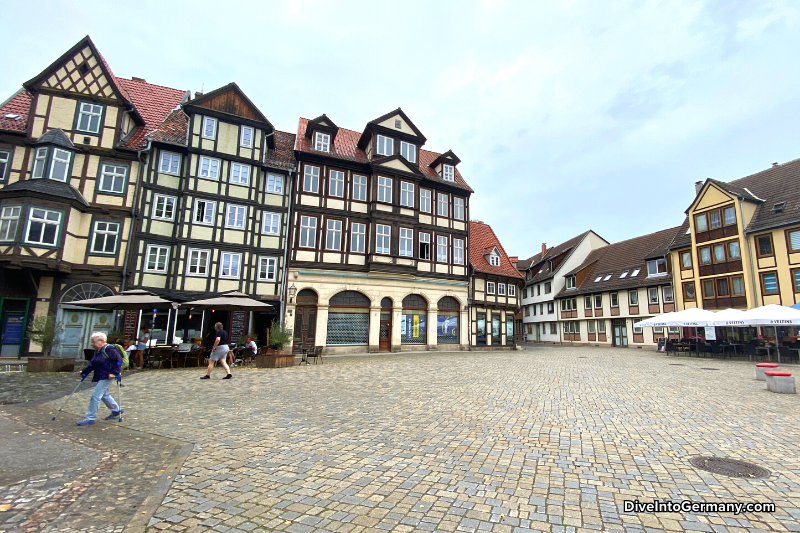
In 1426, Quedlinburg joined the Hanseatic League and wanted to become a free imperial city. However, this did not last long thanks to Quedlinburg Abbey disputing the independence of the town which it wanted to keep under its power.
In 1477, this lead to Abbess Hedwig (the head of Quedlinburg Abbey) winning her resistenace effort against the people who wanted to stay in the Hanseatic League and the Bishop’s forces. Quedlinburg had to leave the Hanseatic League. Instead, it was protected by the electors of Saxony.
During the Protestant Reformation, the town and the abbey converted to Lutheranism in 1539.
In 1697, the Saxony Elector, Frederick Augustus I, sold his rights to Quedlinburg to Brandenburg. In 1802, the abbey was secularised and taken over by the Kingdom of Prussia.
During the Nazi rule, the memory of Henry I became popular and the Collegiate Church and castle became a shrine for their vision of Nazi Germany. Quedlinburg escaped major damage from World War II but was occupied by the Americans during the last months of the war who put the church back how it was.
Quedlinburg was part of East Germany from 1949 to 1990 and joined the state of Saxony-Anhalt when Germany reunified in 1990.
In 1994, the Old Town, the Castle and the Collegiate Church were UNESCO World Heritage listed. This is thanks to Quedlinburg being one of the best preserved Medieval and Renaissance towns in Europe especially because of the number and quality of the timber-framed buildings in this town.
Today, tourism is an important industry in Quedlinburg along with the manufacturing of dyes, engineering products, vehicles, plastics and paper. It’s also a centre of plant research.
Top 11 Things To Do In Quedlinburg Germany
Here are the best Quedlinburg attractions. Read through and select the ones that fit your interests and timeframe. If you only have one day to visit Quedlinburg tourist attractions, find our one day Quedlinburg places to visit itinerary below.
Note that I sort these things to do in Quedlinburg Germany based on geographical location starting with the central Old Town and Marktplatz and then listing the closest Quedlinburg Germany things to do while working our way further away. The order isn’t based on what I think are the most important attractions.
Altstadt (Old Town)
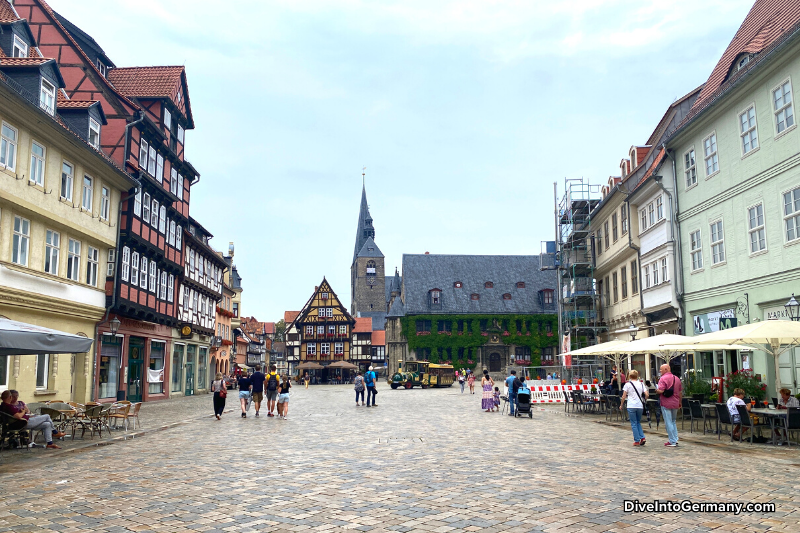
The Old Town in Quedlinburg is absolutely superb and you won’t want to miss it. With the crazy amount of original half-timbered houses, you’ll feel like you’ve gone back in time and there are constantly new buildings to admire as you walk around.
While the buildings you see were built over many different times, the majority of timber-framed houses were built in the economic boom from 1620 to 1720. This style of building was most popular then and a number of special styles developed in Quedlinburg (learn more at the Half Timbered Museum coming up in this list!).
The Old Town is best explored by foot. Marktplatz can be considered the centre and is definitely somewhere to head – it’s gorgeous! – but you’ll no doubt enjoy walking around any of the streets in this area.
The platz in front of Klopstockhaus is another pretty place to wander around, and I particularly enjoyed a line of houses near the corner of Carl-Ritter-Straße and Word as well.
I recommend you take your time wandering the whole area while you slowly tick off any of the Quedlinburg attractions below that interest you.
And keep your camera handy! I took a crazy amount of photos and all were insta-worthy.
There are also some great parks in the Old Town. Perfect for picnics or taking a time out from sightseeing.
Rathaus (Town Hall)
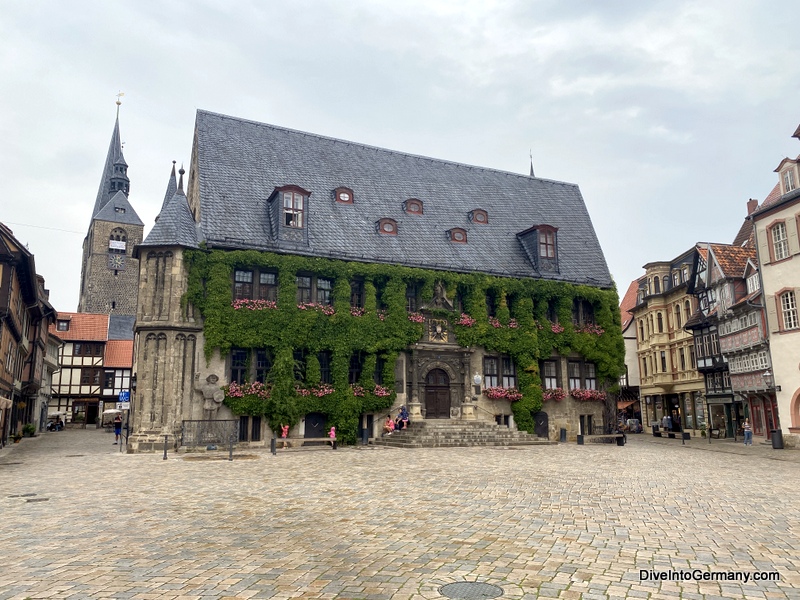
The ivy-covered Rathaus on Marktplatz is something you won’t want to miss. Dating back to 1320, this stone building in Gothic style makes for quite a sight.
Above the door is the city’s coat of arms. You can also see the Roland statue from around 1426 at the front (pictured above on the left hand side). This is from when Quedlinburg joined the Hanseatic League.
This became a controversial figure when Quedlinburg left the league and it has been moved several times, destroyed and re-erected again.
Marktkirche St. Benedikti (Market Church Of St Benedict)
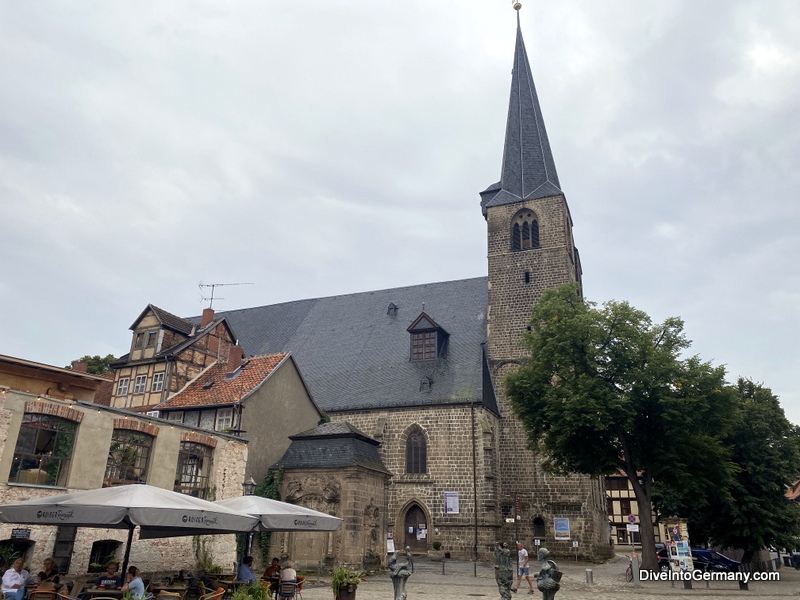
Located behind the Rathaus is Marktkirche, the place Quedlinburg’s merchants went in the 10th century to worship.
With Romanesque stonework, it’s a beautiful building that could have been consecrated as early as 1173. It’s evolved over the years and today, it has many architectural styles and furnishings. It’s worth taking a look inside.
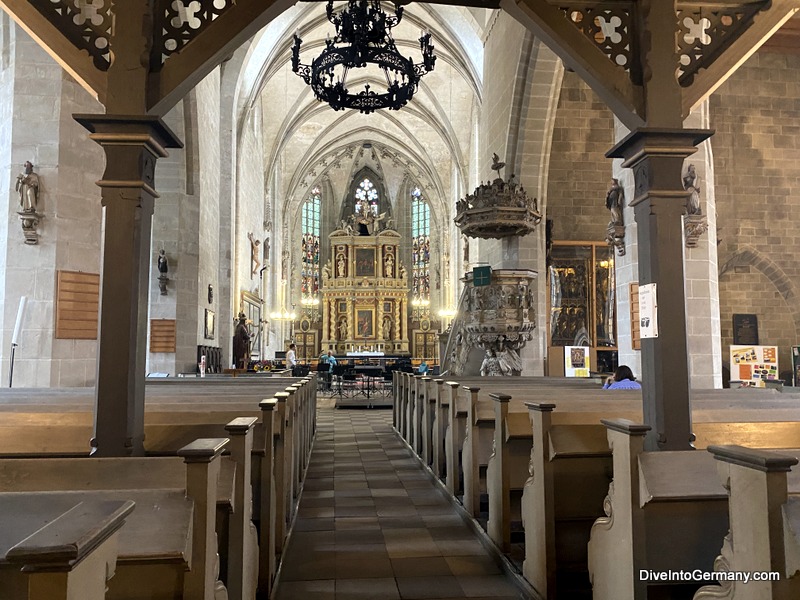
There is a permanent exhibit to enjoy, Quedlinburg – from Palatinate city to Roland city . It looks good, but unfortunately, it’s only in German.
The two towers of the church were damaged by fire which is why today one is lower. At the time of publishing, it is not possible to go inside the towers.
Entry is free.
Sternkiekerturm (Lindenbein Tower)
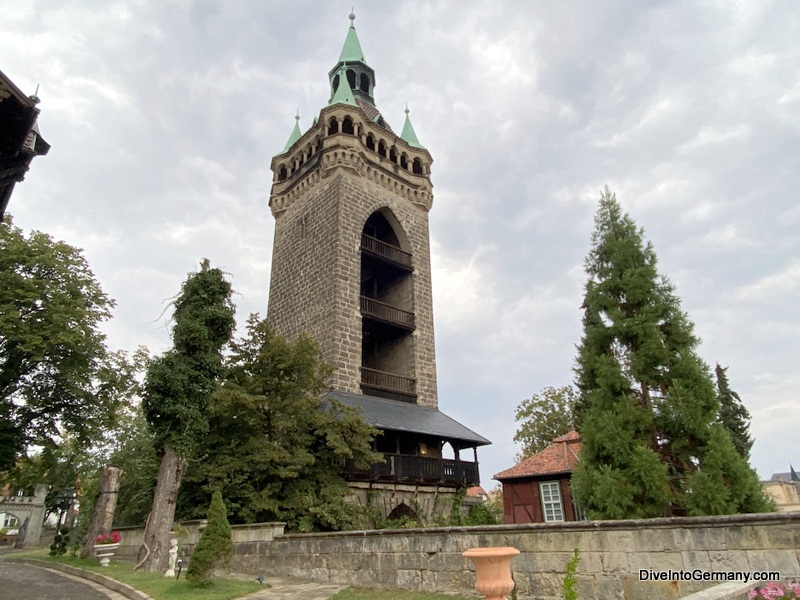
Just to the north-west of Marktplatz is Sternkiekerturm, an observation tower with great views of the Old Town thanks to being 42 metres high.
It is next to the city wall and used to be part of the defensive system of Quedlinburg. The current design of the tower dates to the late 19th century when the eclectic style was in vogue.
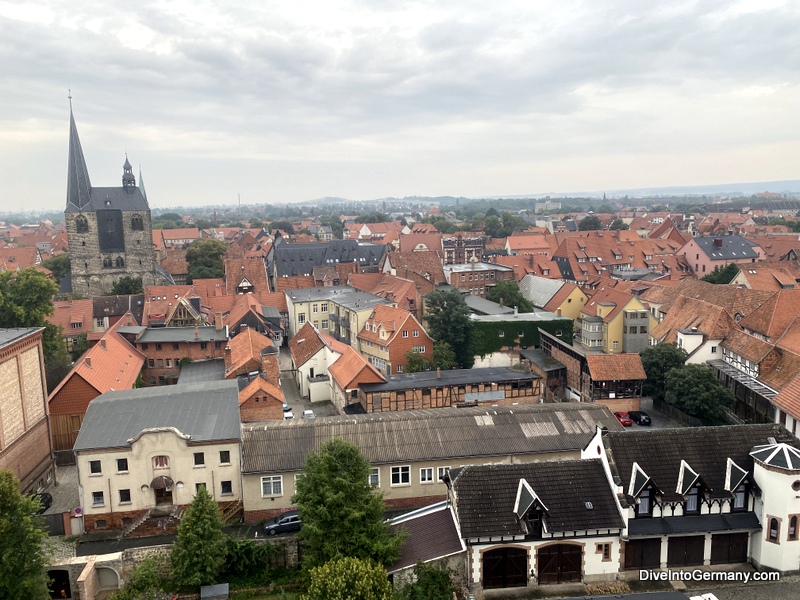
The tower is actually located in the grounds of the Schlosshotel zum Markgrafen so you need to enter here to climb this tower. This is easy to do, and you’ll spot it easily – it’s tall! So don’t feel strange about this.
There was a small charge of one Euro per person when we visited that we deposited into a turnstile to enter, so make sure you have enough Euro coins for your group.
Fachwerkmuseum Im Ständerbau (Half Timbered Museum)
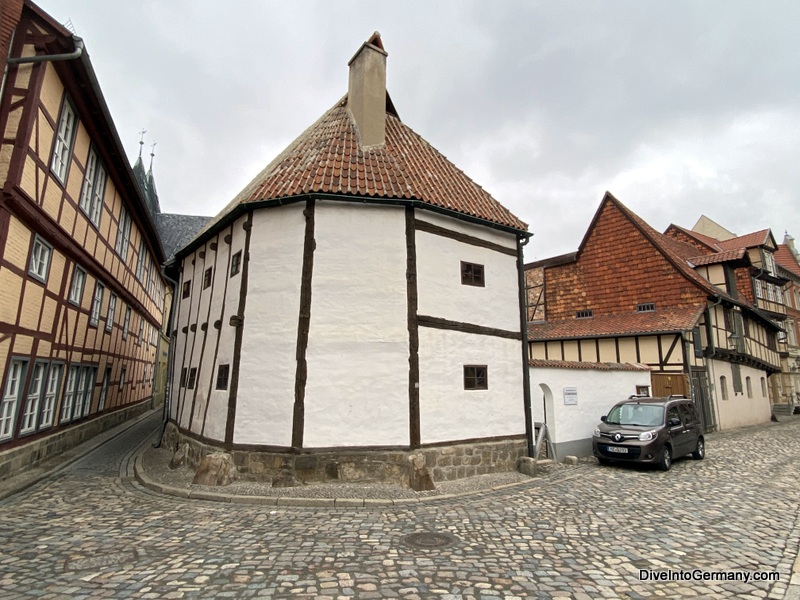
If you want to learn more about Germany’s half-timbered houses (it’s hard not to when you see so many of them here!), this museum is the place to head.
The Half Timbered Museum calls one of the oldest half-timbered houses in the city home. It dates back to 1310. It’s one of many styles you’ll see in Quedlinburg and this museum will walk you through the styles and physics behind the construction of these houses over time including the earliest Ständerbau construction (like this house).
You can also learn about the restoration currently taking place in Quedlinburg.
There is a small fee and this attraction usually shuts over winter.
We did not get the opportunity to visit this inside, but I think there’s a good chance it’s only in German.
Lyonel-Feininger-Galerie

For contemporary art, the Lyonel-Feininger-Galerie centres around the Bauhaus artist, Lyonel Feininger (1871–1956) and also shows work by some of his contemporaries.
Feininger was born in New York, but moved to Germany at the age of 16 before later returning to the US in 1937 to escape the Nazis. This collection is from the period 1906 to 1936 and was collected by Quedlinburg architect, Hermann Klumpp. It’s a collection of paintings, drawings, etchings, woodcuts, photographs and more.
It’s perfect for art lovers and a great contrast to the Medieval-ness of everything around 🙂
Klopstockhaus
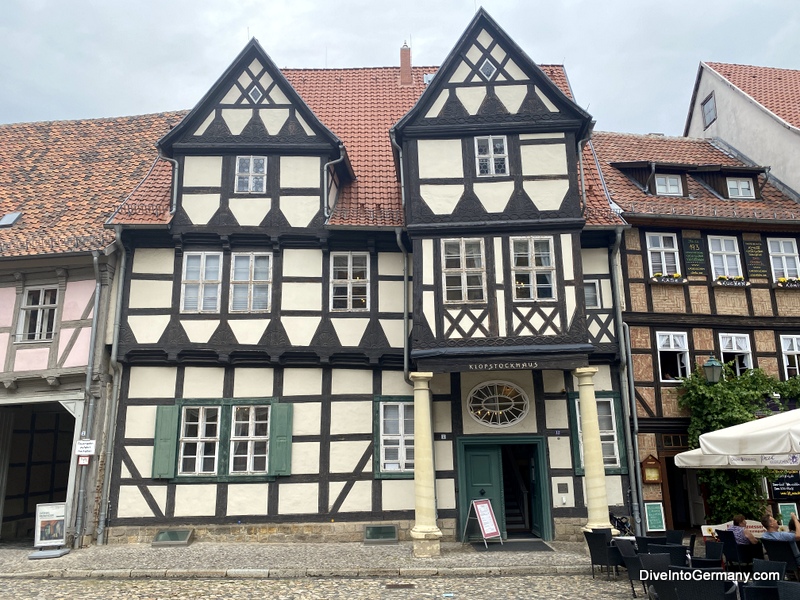
One of Quedlinburg’s favourite natives is the early classical poet, Friedrich Gottlieb Klopstock (1724–1803). Klopstockhaus is the home where he was born.
Today, it is a museum with exhibits centred around him and his work as well as other notable people born in Quedlinburg like Dorothea Erxleben (1715–62) who was Germany’s first female doctor.
Built just below Castle Hill around 1560, it is in a beautiful spot super close to the Lyonel-Feininger-Galerie. Take a walk here even if you don’t want to visit this museum.
Literary lovers will find it interesting the role Klopstock played in shaping poetry and the direction it was heading.
Schlossmuseum (Castle Museum)
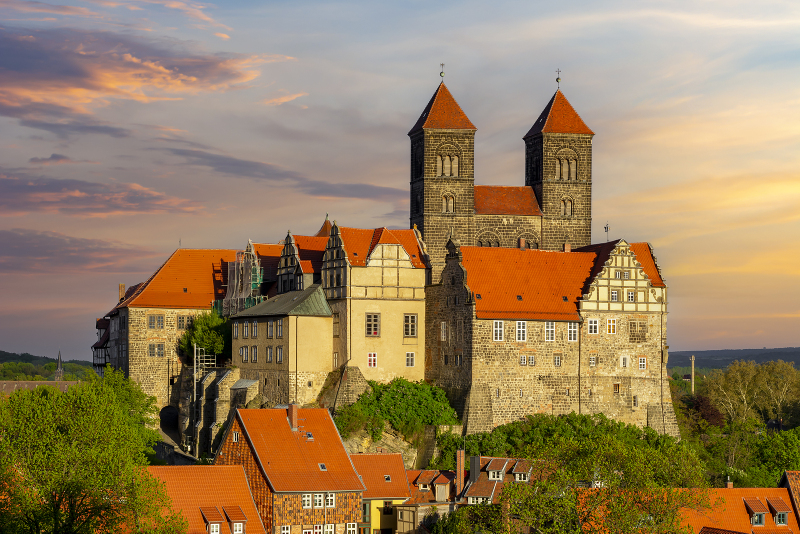
It’s time to take this Quedlinburg tour up from the Old Town to the old heart of Quedlinburg at Castle Hill (Schlossberg) with the Schlossmuseum which can be the first attraction you’ll hit here when walking from Marktplatz.
Castle Hill is a 25 metre high plateau located above Quedlinburg. Henry I initially had a church and residence here. Today, this Renaissance-era palace is home to the Schlossmuseum. This is the perfect place to head to learn more about the Quedlinburg’s history from prehistory and ancient and Medieval times.
You’ll learn more about how this area developed under Henry 1 and the Ottonian-period (919-1056) in particular. There are also remnants of stuccowork to see that date back to the 900s.
There’s also information about how the Nazi Party used this area and Henry I as part of their propaganda to justify their ideology.
There are also exhibits that date back to the bronze age found in nearby Lehof.
Add all of this with the fact that you also get to see the palace interiors, and it’s worth the entry fee.
Note at the time of publishing, this attraction is closed due to renovation work.
Stiftskirche St. Servatius (Collegiate Church)
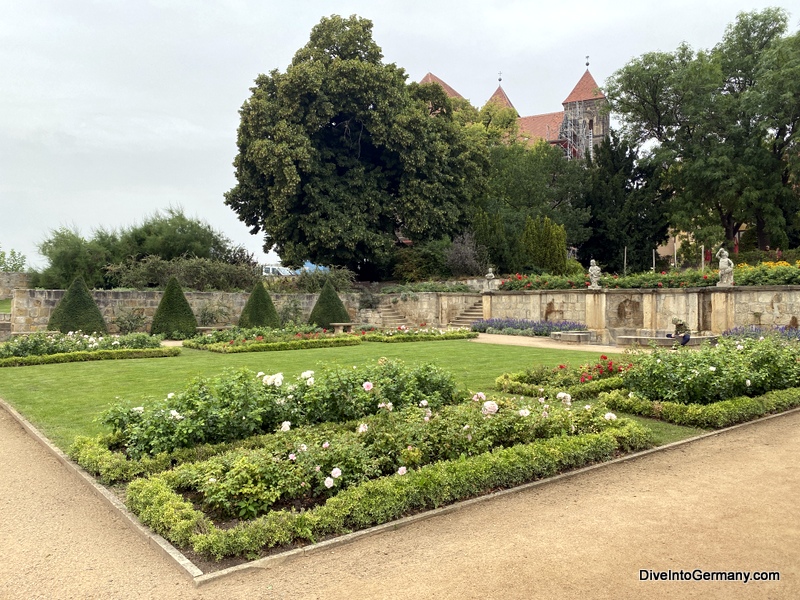
If you haven’t worked it out yet, Stiftskirche St. Servatius (Collegiate Church or formerly Quedlinburg Abbey) has played an important role in Quedlinburg’s history and should be high on your list of must visit places in Quedlinburg.
It was founded in 936 after Henry I died and his widow, Queen Mathilde, requested it in his honour. For centuries, this church and its abbesses had power and influence.
This sandstone building makes for quite a sight and you’ll want to make your way up here on Castle Hill. Its Lombard Romanesque architecture looks grand and imposing on the hill.
Inside, there are many treasures.
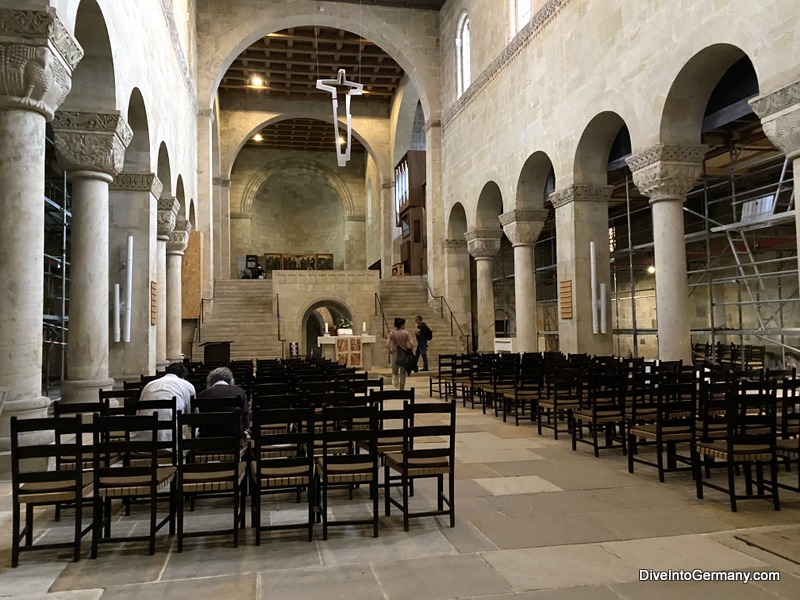
Firstly, Henry I and his wife, Mathilde, are buried here as well as the former abbesses. Its crypt also has many other treasures including murals, reliquaries and early Bibles. UNESCO says it “constitutes one of the most significant monuments in the history of art from the 10th to the 12th century”.
There is also a treasury reached from the choir with preserved Medieval treasure art. The wealth of this church at the time can be seen in the relics, manuscripts, sculptures, paintings and more here including great goldsmith work and ivory carvings. You can also find the oldest preserved knotted carpet in Europe from around 1200, and plenty of items much older than this.
As a history buff, I very much enjoyed visiting such an old church that stands at such an historic place, and I highly recommend it.
There is an entry fee (around 5 euros when we visited) but it’s well worth it.
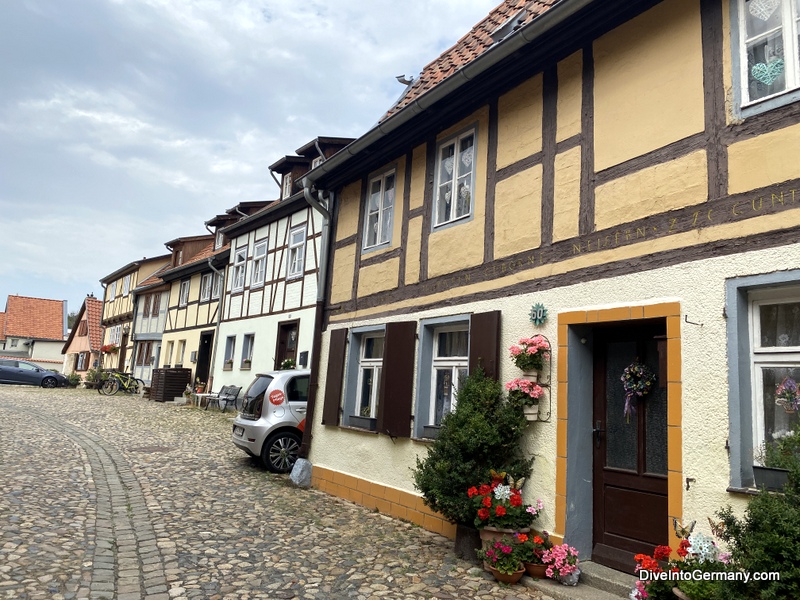
Münzenberg is an area of Quedlinburg on the hill to the west of the Old Town. It was once a separate settlement started when the sister of Otto II, Abbess Mathilde, and his wife founded a monastery church here. It is also home to around 65 half-timbered houses.
The monastery was closed when the Protestant Reformation took place and the treasures were moved to the Collegiate Church. Over time, the ruins were built over.
Today, you can find preserved parts of the building to give you an idea of the Medieval architecture that this building had. This is thanks to Professor Siegfried Behrens and his wife who bought the houses that were over the church and reunited the area so you can see everything that is left now.
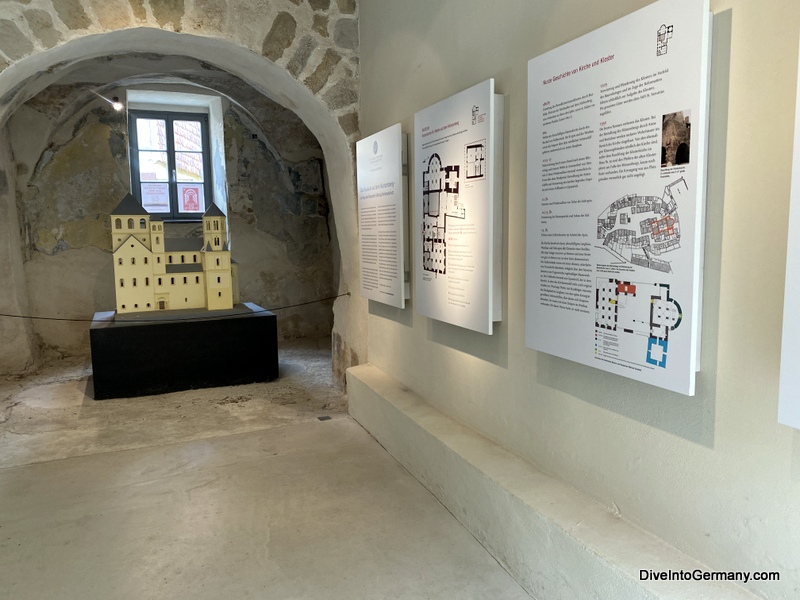
There is a museum on this site that you can visit for free. Information is in German only. Find the latest opening hours here .
Even if you don’t visit the museum, it’s a pretty little area to stroll and enjoy which is just a short walk from the heart of the Old Town. There are some nice views over to the Old Town as well. Even better is that I had it all to myself on a Friday in August.
Harz Narrow Gauge Railway
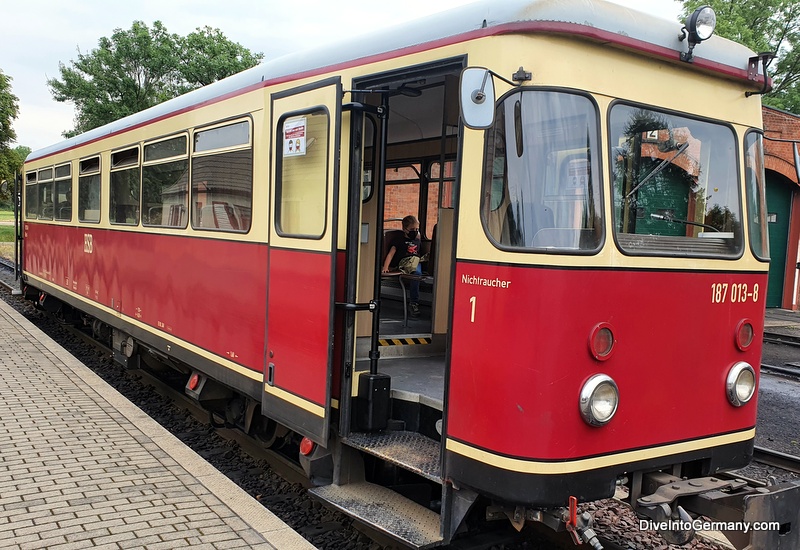
For something completely different to do in Quedlinburg, consider seeing more of the Harz Mountains on the narrow gauge railway.
Quedlinburg is the terminus for the Selktealbahn line that goes into the Harz Mountains via Bad Suderode, Gernrode, Alexisbad and Stiege. Depending on the train you catch, you can see the Harz Mountains from a train carriage pulled by a steam engine, diesel engine or a motor railcar, all of them offering excellent views.
You can also change trains and ride on the other two lines in the network at the stations where the lines meet. Train lovers won’t want to miss the chance to ride on the largest narrow gauge network in Germany.
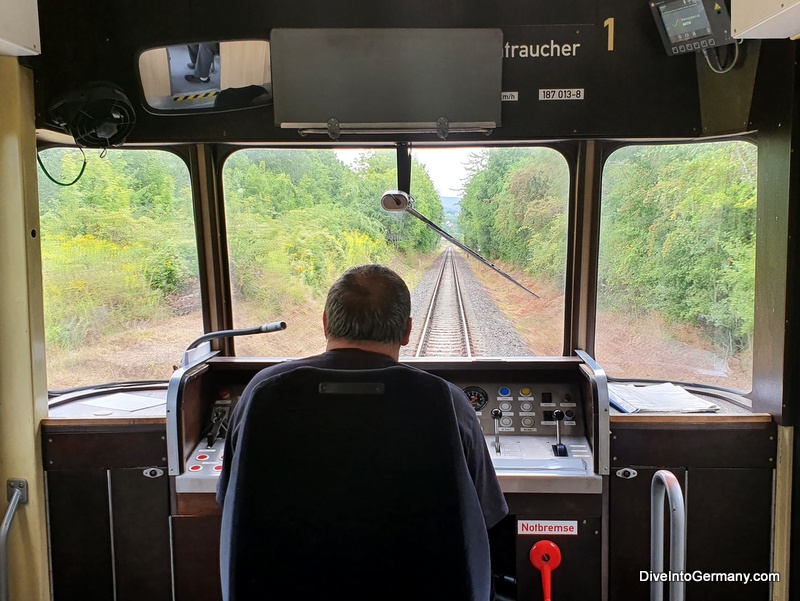
Even if you’re not a train buff, the train makes for a great day trip from Quedlingburg.
You can buy tickets online or at the tourist information centre on the Marktplatz. You select your origin and destination (and one way or return) and your tickets are valid for any trains on between those points for the day of travel. Buy tickets online or find timetables and more information here .
Best Things To Do In Quedlinburg In December
While most of the things to see in Quedlinburg Germany listed above are possible in winter time, there are also some fun things to do in Quedlinburg which are especially for the winter months.
Note that the Half Timbered Museum shuts in winter.
Quedlinburg Christmas Market And Other Events
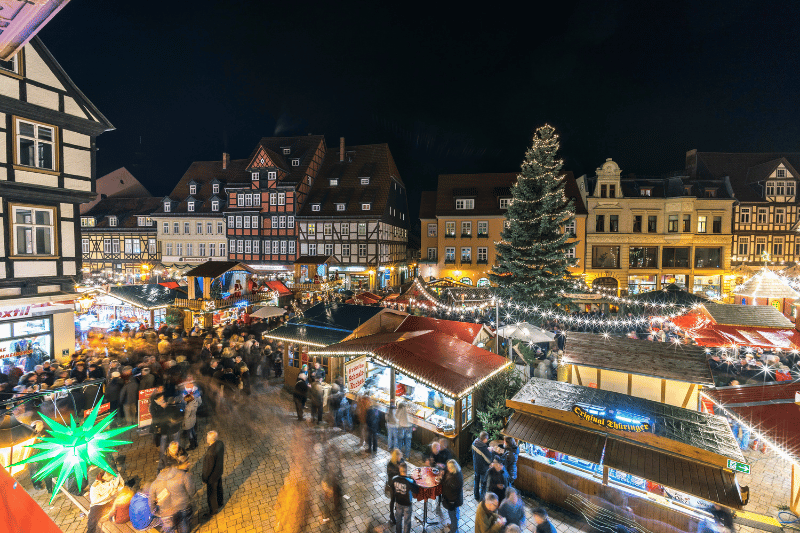
The Quedlinburg Christmas Market runs for about a month in the lead up to Christmas. It’s the perfect place to head if you are in Quedlinburg at this time for some festive spirit, to buy Christmas gifts and crafts and to try local food. Head to Marktplatz to get started
Even more special is the “Advent in the Courtyards”. On the second and third weekends of Advent, 20+ inner courtyards in Quedlinburg, which are usually not publicly accessible, open up. Small treasures are offered in the courtyards especially made for these weekends.
There is also the “largest Advent calendar in Germany”. Every day in December in the lead up to Christmas, one of 24 houses around Castle Hill with special Christmas decorations is opened to the public. Each day at 4:30pm outside of Klopstockhaus, everyone taking part meets and then searches together for the house that is opening that day. It has a shining star on the door.
Inside, there are surprises. This is an event aimed at families.
There is a great video explaining it here . It’s on our list for next time we spend Christmas in Germany!
What To Do In Quedlinburg In One Day
Only have one day in Quedlinburg? What a shame! But it’s ok, it’s still worth going to Quedlinburg if you only have one day.
With one day, I recommend you stick to the Old Town. In a day, you can have a good wander and visit most the attractions mentioned above without rushing around too much. In fact, they mostly fit nicely into a day.
You can make your own itinerary by picking the places to visit in Quedlinburg that sound most interesting to you or you can copy my itinerary below.
- Start at Marktplatz. Take your time soaking it all in and checking out the exterior of the Rathaus
- Take a look at the Market Church Of St Benedict
- Climb up Sternkiekerturm for great views over the Old Town
- Walk towards the Fachwerkmuseum Im Ständerbau (Half Timbered Museum) taking any detours you feel like on the way
- Visit either the Lyonel-Feininger-Galerie or Klopstockhaus depending on whether you are prefer art or literary history
- Walk up to Schlossmuseum and explore the palace
- Go inside Stiftskirche St. Servatius and give yourself enough time to fully enjoy everything on offer
If you still have time, wander around Münzenberg.
Quedlinburg Attractions Map

Best Place To Stay In Quedlinburg
When it comes to where to stay in Quedlinburg, there is a great range of hotels and other accommodation options. You won’t have any problem finding somewhere to stay.
Below, I’ve listed a few different places to consider depending on what type of accommodation you are looking for.
If you want more options, you can use this map to help you find hotels and home rental accommodation around Quedlinburg.
BEST – Romantik Hotel am Brühl Review

Located just south of Castle Hill, you can easily explore Quedlinburg from this stylish hotel just outside the Old Town.
Facilities here include a great restaurant with evening meals and afternoon cake time. There is also a bar and they can pack a lunch for you. Buffet breakfast is usually included in the accommodation charge.
Parking is possible for an additional charge as is access to a sauna. Wifi internet is included.
There are a range of room types from singles, doubles, triples and suites to two bedroom apartments. So, despite the name, this is a good choice for families as well as couples.
Rooms include flat-screen TV, minibar, toiletries and a desk area at a minimum. The apartments have living rooms and kitchenettes. All are beautifully renovated and stylishly decorated.
Click here for the latest prices.
VALUE – Hotel Zum Brauhaus Review
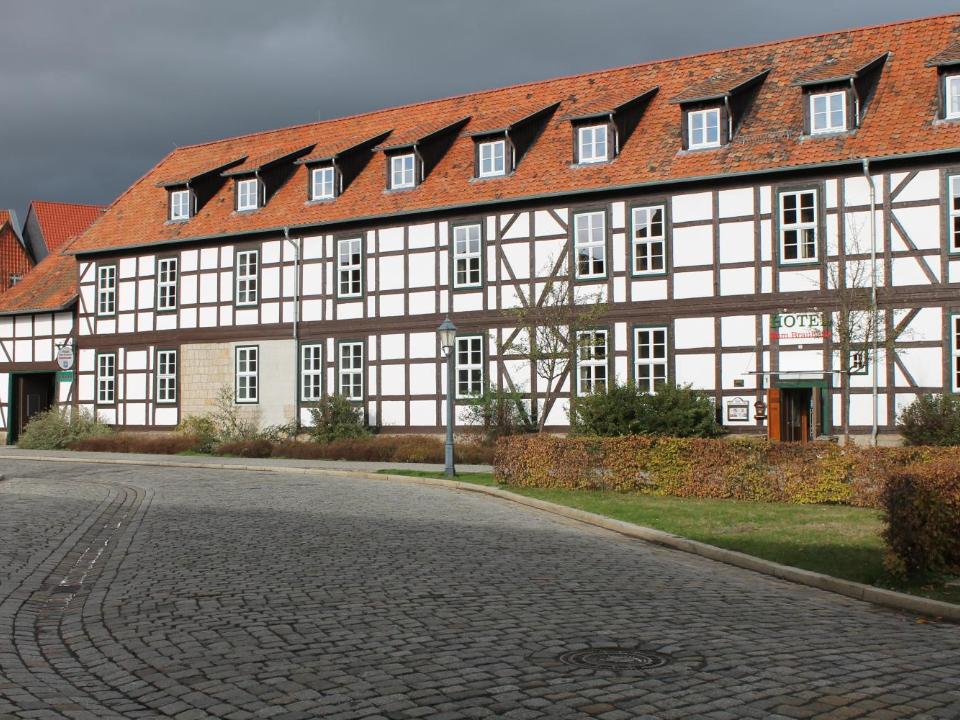
Looking for a lower price and great value? Consider the Hotel Zum Brauhaus . Located in the Old Town in between Castle Hill and Marktplatz, this is in a fabulous spot.
Facilities include free parking, included breakfast and wifi.
Rooms are either single or double but you can also book a triple room which is a connecting single and double room. Rooms include flat-screen TV, ensuite bathroom and desk area. The rooms can be quite small.
APARTMENTS – Quartier Am Brunnen Review

The Quartier am Brunnen is well located and a perfect choice if you want apartment style accommodation in the heart of the Old Town, moments from Marktplatz and Castle Hill. The hotel is in a renovated Baroque half-timbered house and it’s very atmospheric.
There are a range of apartments that are mostly one-bedroom as well as a two bedroom apartment complete with a great patio that can house up to six people. The apartments are self catering and great value.
You can find free parking and wifi internet here as well as an optional breakfast. There is also a garden area.
Click here for the latest prices or you can read our full review here.
How To Get To Quedlinburg
We travelled to Quedlinburg by hire car which made it very easy to get here.
You can hire a car to get you there by clicking here.
Quedlinburg is on the Romanesque Road which is a tourist route you may enjoy exploring. It takes you on a journey to towns with significant Romanesque architecture.
There are regular trains and buses here. You can find timetables and all your options here. From the main cities in the area, like Berlin and Leipzig, you’ll usually need to take multiple trains with changes in places like Magdeburg or Halberstadt. There are direct buses from Berlin.
If you want to fly here, Leipzig , Hanover and Berlin are your best choices, although they aren’t that close.
Once in Quedlinburg, we found it easy to explore on foot. Many roads are pedestrian only and you won’t want to miss anything by exploring any other way!
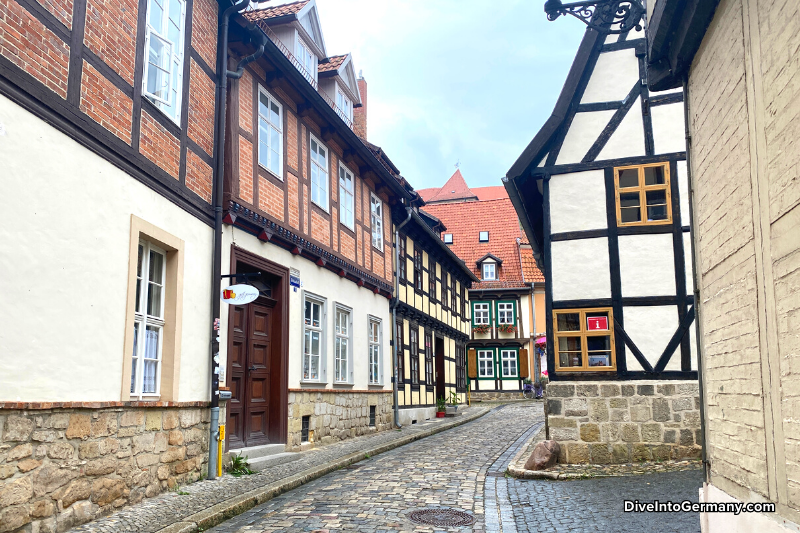
Quedlinburg With Kids
We visited Quedlinburg with our six and ten year olds. We found it a great place to visit with kids because most of what we wanted to do was simply walk around the Old Town which worked well for them. They had fun trying to find different coloured houses and picking their favourite ones.
If your kid is tired or reluctant to walk around much, you could take one of the train tours here around the Old Town.
There are playgrounds in the Wordgarten and in the Brühlpark (enter at Platz des Friedens) which are both by Castle Hill.
Final Words
I hope you enjoyed this guide to Quedlinburg and find it useful. Quedlinburg is a picturesque place to visit which is perfect for anyone who enjoys history and stunning Old Towns.
While there are some great attractions here (particularly the Collegiate Church), the best part is simply walking around the old streets taking it all in.
It’s a must visit for anyone who enjoys gorgeous Old Towns and history.
Add it to your Germany itinerary now!
Read more guides to visiting Central Germany here . Or read this guide to nearby Bamberg here or Leipzig here. Don’t miss our amazing Central Germany itinerary here which includes Quedlinburg.
Related posts:

By Sharon Gourlay
Sharon first fell in love with Germany back in 2000 on her first visit. She loves the long history, the picturesque Old Towns, the castles, the food, everything really! Since then, she has visited many times and loves writing about Germany here so you can enjoy it too. In fact, Sharon loves German culture so much that she sent her kids to a German primary school in Australia. She especially loves Berlin and towns with charming Old Towns like Celle and Quedlinburg. Sharon also has a Certificate III in International Travel Sales and understands the nitty gritty of travel planning. Through this site, she'll help you have the perfect trip to Germany whether it's your first or tenth time!
Leave a comment Cancel reply
Your email address will not be published. Required fields are marked *
Save my name, email, and website in this browser for the next time I comment.
This site uses Akismet to reduce spam. Learn how your comment data is processed .

Home » Travel Guides » Germany » 15 Best Things to Do in Quedlinburg (Germany)
15 Best Things to Do in Quedlinburg (Germany)
A UNESCO World Heritage city, Quedlinburg rests below a sandstone cliff that has an abbey and palace on top. The king of East Francia, Henry the Fowler founded Quedlinburg in the 10th century, and his successor, Holy Roman Emperor Otto I would hold court here and develop the city.
Quedlinburg has been left with enigmatic Ottonian and Romanesque architecture from the High Middle Ages when a long succession of Abbesses held sway from the cliff-top. Those Abbesses remained in charge up to 1803 when the abbey was dissolved.
Over five centuries, merchants and artisans built hundreds of half-timbered houses down the slope in the old town and on the Münzenberg hill. There are more than 1,300 half-timbered buildings in all, which may make you wonder if you’ve stepped into the realm of fantasy.
Let’s explore the best things to do in Quedlinburg :
1. Stiftskirche St. Servatius

A monumental sandstone construction on the Schlossberg, this Lombard Romanesque church is a three-aisled basilica consecrated in 1129. The church is the resting place of Henry the Fowler, founder of the Ottonian dynasty.
His bones and those of his Matilda of Ringelheim are still preserved in the fresco-covered crypt beneath the chancel.
In the nave spend some time admiring the capitals and imposts, richly carved with depictions of plants and animals, particularly eagles.
A little higher, the frieze under the clerestory is also decorated with animal motifs.
A stairway in the choir leads to the treasury, which has astonishing Early and High Medieval works like the Quedlinburg knotted carpet from the 12th century and the Servatius Reliquary and ivory box embellished with delicate gold filigree.
2. Schlossmuseum

In the magnificent interiors of the 16th-century Renaissance palace on Schlossberg is a museum that maps Quedinburg’s prehistory, ancient history and Medieval times.
The galleries explain how the Schlossberg took shape during the reign of Henry the Fowler in the 10th century, and take you into the world of the Ottonians.
From this period you can see the oldest remnants of stuccowork in the German-speaking world, dating to the 900s.
There are also Bronze Age hoards unearthed not far away in Lehof and Groß Orden.
The palace’s interiors are also worth the entry fee, offering a taste of noble life in Quedlinburg in the 17th and 18th centuries.
3. Timber-framed Houses

Quedlinburg’s old town is the very definition of cosy, and at the last count the city had 1327 half-timbered houses.
While all of them radiate old-time charm, there are some that need to be top of your list.
At Breite Straße 39 is Gildehaus zur Rose (1612), is distinguished by its two tiers of colourful, carved panels and home to a long line of wealthy merchants.
The Börse (Stock Exchange) at Steinweg 23 is a three-storey Baroque house from 1683, and was the first building designed by master carpenter Andreas Besen, who would help shape Quedlinburg in this period.
Also make a detour for the Weißer Engel (1623), a merchant and guesthouse at Lange Gasse 23, and the striking three-storey cube-like building at the corner of Breite Straße and Schulstraße, dating to 1660.
4. Münzenberg

This hill to the west of Schlossberg and old town was born out of a separate settlement and is packed with some 65 half-timbered houses.
It all came about at the end of the 10th century when a convent was founded by the widow of Otto II, Empress Theophanu.
When the Reformation arrived in the 16th century the convent was closed down and artisans like tinkers and scissor grinders moved into the area, building small timber-framed houses around the dilapidated monastic buildings.
There’s a museum about the history of the Münzenberg, preserving the convent church, a beautiful Ottonian basilica.
Also stop for the wonderful views east to the Schlossberg.

The piece de resistance in the market square is Quedlinburg’s old town hall.
Unlike most of the city’s architecture this 13th and 14th-century building is made entirely from stone, in the Gothic style and crested by a steep saddle roof.
Under its lush coating of ivy there are a few details to pick out: Over the portal is the city’s coat of arms, which is also represented by a mosaic on the ground to the left side.
Behind this is the Roland statue of a knight brandishing a sword and shield, signifying Quedlinburg’s town privileges.
6. Marktkirche St. Benedikti

In the old town, the Marktkirche was a place of worship for Quedlinburg’s merchants in the 10th century and has kept a lot of Romanesque stonework from its early years.
From the outside this is most obvious on the western towers, which have narrow semi-circular windows and blind arches.
The two towers have different heights as the south one was damaged in a fire, while the apartment of Quedlinburg’s night watchman is open to visitors and allows you to survey the old town to the east, south and west.
Check out the Baroque high altar (1700), Renaissance pulpit (1595) and a masterful Late Gothic winged altar in the south aisle from 1480 with an image of Mary with Child on its central panel.
7. St. Blasii

Now a concert hall, this former church may well be the oldest in the city.
The monolithic square tower has stonework from the 10th century, long before the first mention of the building in 1222. In the 1710s, everything except for that tower was given a Baroque redesign.
For the tastes of that time the interior is surprisingly discreet, but the wooden pews, stalls and gallery have an understated beauty, while the 18th-century pulpit is very theatrical for its gilded columns, statues and imitation red marble.
8. Sternkiekerturm

A few hundred metres west of the marktplatz is the Schlosshotel zum Markgrafen, which operates the observation tower on its grounds.
You pay €1 and pass through a turnstile to begin your climb of this structure that used to be a defensive tower.
Like all of Quedlinburg’s towers, the side of the Sternkiekerturm facing the city is completely open.
If you’re wondering about the quirky design, the tower was redesigned in the late 19th century according to the Eclectic fashion of the time.
At 42 metres, this is the highest observation platform in Quedlinburg, with unbroken views east to the old town and south to the Schlossberg.
9. Fachwerkmuseum Ständerbau Quedlinburg (Half-timbered Museum)

In a town of more than 1,300 half-timbered houses, Quedlinburg is just the place for a museum on this topic.
The attraction is set in one of the oldest houses in the city, dating to the middle of the 14th century.
But its value comes from the “Ständerbau” construction, in which single vertical timber beams attached to the sill plate(base at the ground floor) rise all the way to the roof.
Outside you can see where wooden pegs have been hammered in to secure the beams against tensile and shearing forces.
The exhibition goes into the specifics of this and other kinds of timber-framed construction, and lets you in on the restoration efforts constantly taking place around Quedlinburg.
10. St. Wiperti

On the grounds of Henry the Fowler’s royal court on the southwest side of the Schlossberg is the Church of St Wigbert, famed for its 10th-century crypt.
The royal court was hosted at St.
Wipeti, while Otto I visited throughout the 10th century to commemorate his father and to celebrate Easter.
This lower portion was unchanged after the basilica above was reconfigured in the 12th century, and is obligatory for its arched niches and Ottonian-style capitals.
The upper building was a male monastery until the Reformation and was even used as a barn for a time, before being restored after the Second World War.
West of the church is the Wipertifriedhof cemetery, where Medieval tombs have been cut into the hillside on terraces.

In the Middle Ages this 15-hectare park hemmed by the Bode River belonged to the St. Wiperti Monastery.
After the Reformation it became a recreation area for Quedlinburg’s residents, and in 1685 Anna Dorothea, Abbess of Quedlinburg laid out the avenues that still shoot through the park today.
When the monasteries were dissolved at the start of the 19th century Brühl became a royal property before soon being gifted to the city by the King of Prussia.
After that an English landscape park with exotic trees was planted in 1866, and monuments were erected to illustrious Quelinburgers like Carl Ritter, one of the founders of modern geography.
12. Lyonel-Feininger-Galerie

In the 20th century the Quedlinburg architect and art collector Hermann Klumpp put together a collection of paintings, lithographs, woodcuts, etchings, watercolours and drawings by the Expressionist and Bauhaus artist Lyonel Feininger.
The gallery, which was given a modern extension in the 1990s, has something from each of Feininger’s creative phases between 1906 and 1937. There are also works by some of Feininger’s contemporaries, like Lovis Corinth, Kandinsky, Paul Klee and Emil Nolde.
13. Stiftskirche St. Cyriakus

For an easy and rewarding excursion, go south to Gernrode where another Ottonian monument is in store.
This collegiate church was founded in the 960s by the Margrave Gero, whose sculpted tomb is in the crossing below the steps to the choir.
The show-stopping attraction inside is the copy of the Jerusalem’s Holy Sepulchre.
This masterpiece of Romanesque art was carved over 50 years up to 1130 and is claimed to be most like the original in Jerusalem.
In the nave the capital columns have a variety of motifs, from human heads to stylised acanthus leaves.
14. Harz Narrow Gauge Railways

Quedlinburg is a terminus for a narrow gauge railway line winding through the massive scenery of the Harz mountain range.
This is the longest contiguous network in Europe running on steam power, and it comprises two 19th-century lines that have been joined up and then lengthened to include some of the destinations around the range.
The 8.5-kilometre line from Quedlinburg south to Gernrode opened in 2006 and is an extension of the Selketalbahn, laid in 1887. If you want to make a day of it you could take a return trip to Hasselfelde, 40 or so kilometres away, riding below rolling peaks like the 600-metre Ramberg in a vintage carriage
15. Bad Suderode

It was the women of Quedlinburg’s Medieval convent who first made the most of the natural beauty of this valley a short drive south of Quedlinburg.
The small Romanesque church in the resort is from that period, and is decorated with Late Medieval frescoes and reliefs depicting King David and the Wise and Foolish Virgins.
After the local spring waters were discovered to have health-giving properties in the early 20th century, Suderode was given its spa (Bad) designation and sophisticated Wilehlmine houses cropped up around the valley.
The water has an unusually high concentration of calcium, and people still come to the spa to soak in warm salt baths.
For others Bad Suderode’s beauty is in the landscape of the northern Harz mountains, ready to be uncovered on 245 kilometres of signposted hiking trails.
15 Best Things to Do in Quedlinburg (Germany):
- Stiftskirche St. Servatius
- Schlossmuseum
- Timber-framed Houses
- Marktkirche St. Benedikti
- Sternkiekerturm
- Fachwerkmuseum Ständerbau Quedlinburg (Half-timbered Museum)
- St. Wiperti
- Lyonel-Feininger-Galerie
- Stiftskirche St. Cyriakus
- Harz Narrow Gauge Railways
- Bad Suderode
THE 15 BEST Things to Do in Quedlinburg
Things to do in quedlinburg, explore popular experiences, tours in and around quedlinburg.

Mustard-Guided Manufaktur Sightseeing, tasting and factory sales

Three audio tours in Berlin and other German cities

09/20/2022 Cashflow 101 - Business Event in the Elbe - Boardinghouse by Andreas Köchy

Goslar City guided tour

Segway tour in Etzelsbach with Eichsfeld breakfast

Eisleben Private Walking Tour With A Professional Guide

Vacation Photographer in Magdeburg

Halle Private Walking Tour with a Professional Guide

Private Photo Session with a Local Photographer in Magdeburg

11/24/2022 - 42nd B-DAY Business Breakfast in the Elb - Boardinghouse Magdeburg
Top attractions in quedlinburg.
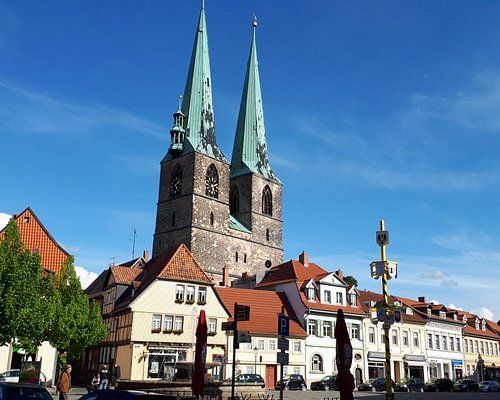
Other Top Attractions around Quedlinburg

What travellers are saying
- Quedlinburg Schloss
- Harzer Schmalspurbahnen
- Church of St. Servatius
- Mathildengarten
- Bremer Damm Teich bei Gernrode
- Sommer-Baden in und um Quedlinburg
Top Things to Do in Quedlinburg, Germany - Quedlinburg Must-See Attractions
Things to do in quedlinburg, explore popular experiences, tours in and around quedlinburg.

Mustard-Guided Manufaktur Sightseeing, tasting and factory sales

Three audio tours in Berlin and other German cities

09/20/2022 Cashflow 101 - Business Event in the Elbe - Boardinghouse by Andreas Köchy

Goslar City guided tour

Segway tour in Etzelsbach with Eichsfeld breakfast

Eisleben Private Walking Tour With A Professional Guide

Vacation Photographer in Magdeburg

Halle Private Walking Tour with a Professional Guide

Private Photo Session with a Local Photographer in Magdeburg

11/24/2022 - 42nd B-DAY Business Breakfast in the Elb - Boardinghouse Magdeburg
Top attractions in quedlinburg.

Other Top Attractions around Quedlinburg

What travellers are saying
- Quedlinburg Schloss
- Harzer Schmalspurbahnen
- Church of St. Servatius
- Mathildengarten
- Bremer Damm Teich bei Gernrode
- Sommer-Baden in und um Quedlinburg
Become a VIP Travel Club Member (FREE)! Get exclusive travel news, tips and experiences every week

Join the VIP Travel Club for weekly exclusive travel updates!
20 Best Things to Do in Quedlinburg Germany
Raise your hand if you love picturesque fairytale towns as much as I do. Nestled amidst the stunning Harz Mountains in central Germany, Quedlinburg is just that!
So just how enchanting is Quedlinburg Germany? Very !
Now, you might be wondering what are the best things to do in Quedlinburg.
With its labyrinthine cobblestone streets, half-timbered houses adorned with vibrant flowers and a rich history dating back over a thousand years, you’ll find nothing but Quedlinburg treasures here.
While living in Berlin, I got the chance to visit this charming town and instantly fell in love. And, I know you will too.
Get ready to immerse yourself in the charm of this fairytale-like destination as I share what to do in Quedlinburg.
Table of Contents
This post may contain affiliate links. If you click on an affiliate link, at no additional cost to you, I will earn a small commission if you decide to book. Please check out my privacy policy and disclosure for more information.
Is Quedlinburg Germany Worth Visiting?
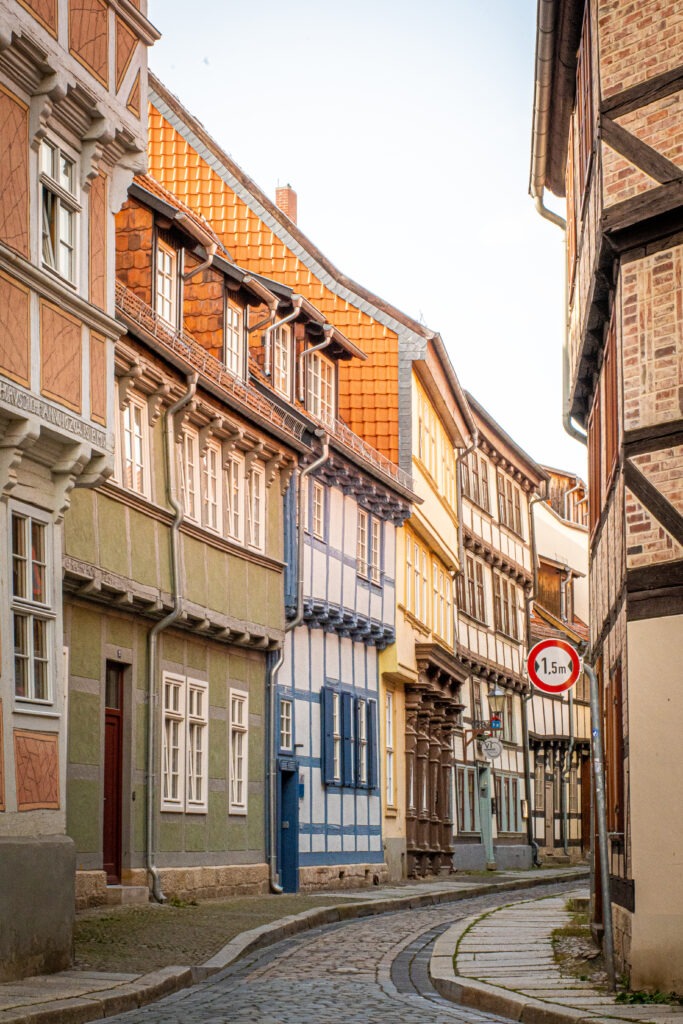
Without a doubt, Quedlinburg Germany is worth visiting! Well, that is if you adore half-timbered houses, a history that dates back over a thousand years and oozes with charm.
If you answered yes, then stick around as I share the top Quedlinburg things to do.
One of the reasons to visit Quedlinburg is to explore its UNESCO World Heritage-listed Old Town.
This well-preserved town boasts over 2,000 half-timbered buildings from eight different eras, making it one of the largest collections in all of Germany.
Strolling through these historic streets feels like stepping into a fairytale book – every turn reveals another delightful surprise. My camera was in overdrive!
So if you are a photographer, history buff, hidden gems chaser, or simply adore medieval, fairytale European towns Quedlinburg is a destination worth visiting!
20 Things to Do in Quedlinburg
1. old town quedlinbug (altstadt quedlinburg).
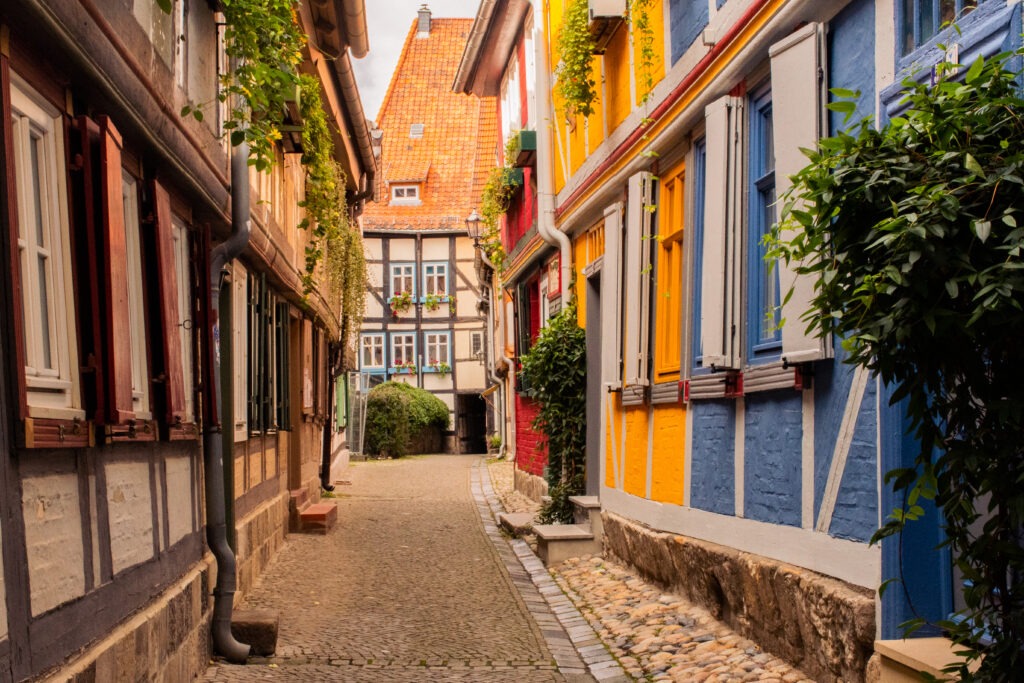
Wandering through the Altstadt of Quedlinburg is like strolling through a living museum. Each step reveals centuries-old half-timbered houses, their ornate façades telling tales of the past. The cobblestone streets wind their way past charming boutiques and quaint cafes, inviting you to stop and admire the view. It reminded me of another German fairy-tale town called Monschau , only much bigger.
A bonus is that the Old Town is a Fussgangerzone , which literally translates to go with your feet zone. Any time you see that in Germany it simply means, no cars and pedestrian-only traffic.
Quedlinburg’s Altstadt is surprisingly large but very simple to navigate. Even if you want to get intentionally lost, somehow streets lead you back to a starting point. My best advice is to explore it fully! Turn down every little street and tunnel as you’ll never know what you’ll find.
Better yet, explore Quedlinburg on a 2-hour guided tour! Locals always have the best stories to tell and hidden gems to find. Check prices and availability .
2. Marktplatz Quedlinburg

The heartbeat of Quedlinburg, the Marktplatz, is a delightfully large square. Café terraces beckon you to sip a frothy cappuccino while people-watching. Food trucks and colourful market stalls offering fresh produce and flowers take over the centre attracting a huge crowd.
The energy is infectious, but there was a small part of me that wanted to enjoy this lovely square all to myself. It is impossible to take a photo without something or someone getting in your way.
Be sure to wander the entire perimeter to admire each of the buildings, many of which are hotels, restaurants and shops. A swoon-worthy building called Quedlinburger Roland is bound to catch your eye (next to City Hall).
Look out for The Münzenberg Musicians by Prof. Wolfgang Dreysse. This bronze statue shows a quartet of Münzberg musicians. Residents of Münzenberg, a town hill positioned opposite the castle hill, found their livelihood through the art of music, skillfully performing on numerous occasions to earn their living.
3. Quedlinburg City Hall (Rathaus Quedlinburg)
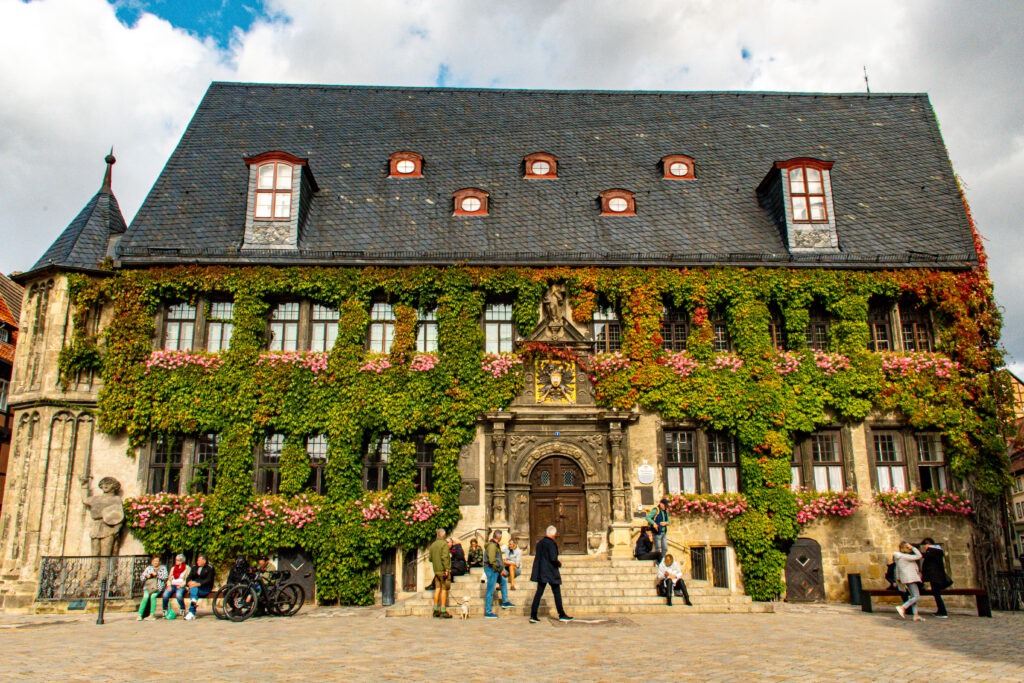
Quedlinburg’s Rathaus is a true architectural gem. Its distinctive Renaissance facade, adorned with intricate sculptures, is a testament to the town’s historical significance. Visit in spring, summer or early fall and it’s adorned with flowers. It’s one of the prettiest sites I’ve ever laid eyes on.
People love to sit on the staircase, some with a gelato and others with something they just picked up from a food vendor.
Don’t make the same mistake I did and that was a visit on a Wednesday, as it is closed. Otherwise, I would have loved to have taken a peak inside.
4. Quedlinburg Cathedral (Dom Quedlinburg known as MarktKirche)

MarktKirche, or the town’s cathedral, is a soaring Gothic masterpiece from the 10th century. Its towering spires can be seen from afar. And make a great backdrop for town photos.
Over the centuries, the church underwent architectural transformations, resulting in a unique blend of styles. From Romanesque to Gothic, Renaissance and Baroque.
There are fourteen churches in Quedlinburg, and without a doubt, this is one worth seeing.
How to Visit:
- 📍Marktkirchhof 1
- 🕙Open daily from 10:00 am – 5:00 pm
- Free entry, welcomes a donation
5. Goetzsches Mausoleum

After you visit Quedlinburg Cathedral, head north, and keep an eye out for a captivating structure nestled among a row of charming timber-framed houses.
This architectural gem is none other than Goetzsches Mausoleum, also known as Grufthaus Gebhardt. At first glance, its visual appeal might be the main draw, as it certainly makes for a great photo op!
However, it wasn’t until I returned to Berlin that I discovered its fascinating history. This Baroque masterpiece, dating back to 1726, was constructed in honour of the late merchant Christoph Gebhardt.
6. Sternkieker Tower (also known as Lindenbein Tower)
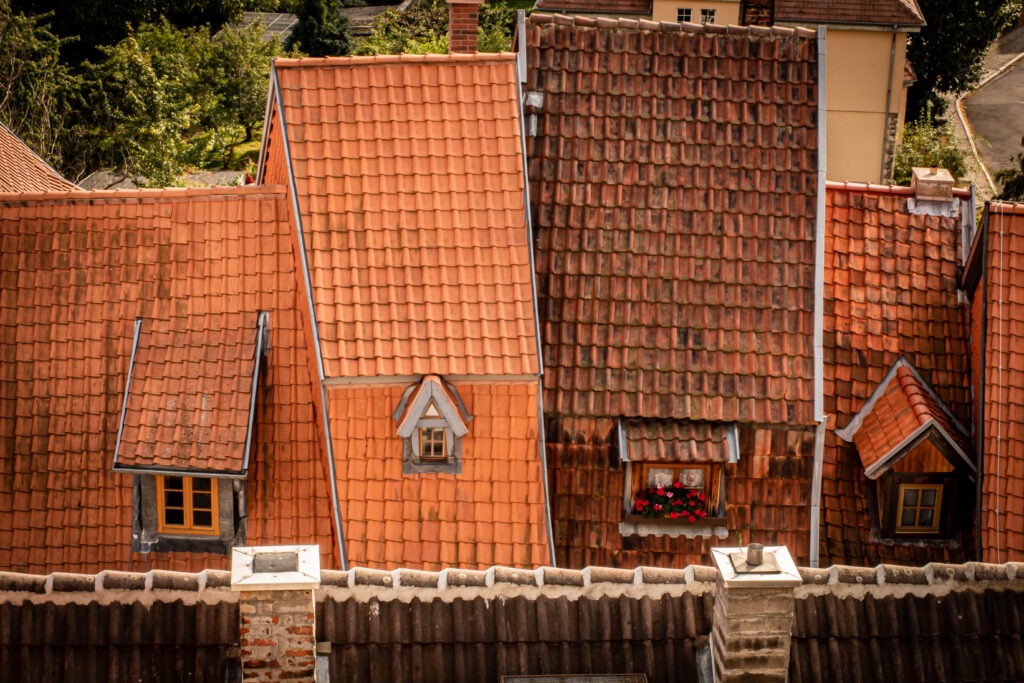
Climb the Sternkiekerturm, an old watchtower, to be rewarded with panoramic views of Quedlinburg’s red-roofed houses and the surrounding Harz Mountains. It’s the perfect vantage point from 42 m.
- 📍Weingarten 1
- 🕙Open daily from 10:00 am – 8:00 pm
- 1 € to get through a turnstile
7. Timberframe Houses
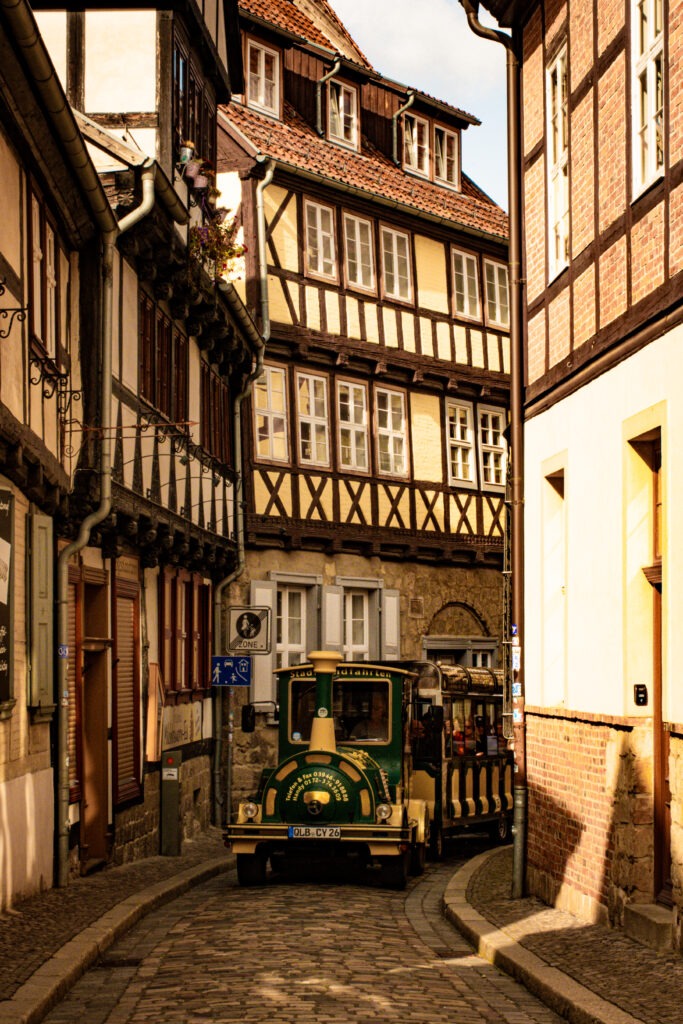
Quedlinburg’s timber-framed houses are a visual delight at every turn. Admire the intricate carvings and colourful facades that adorn these historic buildings, creating a charming backdrop to your exploration.
8. Cultural Church St. Blasii (Kulturkirche St. Blasii)
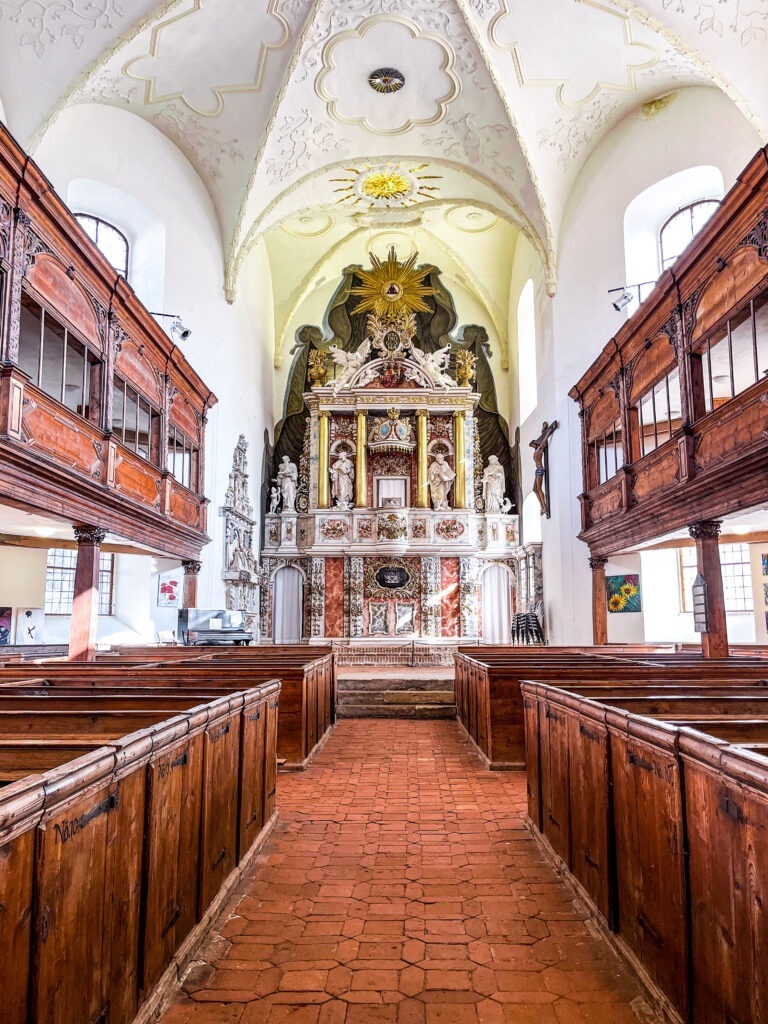
Many of the Quedlinburg churches are not in the centre of town, except this one. That’s why it’s making my list. Not to mention how pretty it is inside.
After its renovations, it reopened as a cultural centre where various concerts and exhibitions are held. When you are exploring the Altstadt, pop into this beauty found at Blasiistraße 6. Right outside of the church is a bronze fountain called The Shaft (Schachtbrunnen) of a boy and a dog.
9. Timberframe Museum (Fachwerk Museum im Ständerbau)
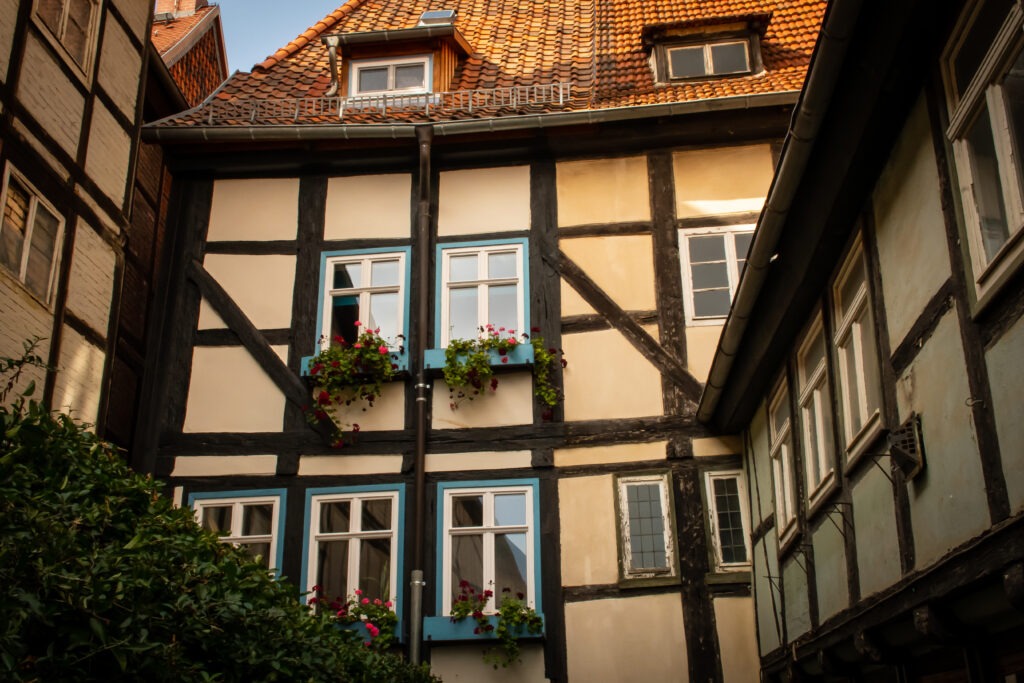
Knowing that Quedlinburg boasts over 2,000 well-preserved timeframe houses spanning eight eras it’s no surprise that it has a museum dedicated to it.
Housed in a 14th-century Ständerbau, this unique museum offers insights into the town’s half-timbered architecture evolution from the 14th to the 19th century, alongside showcasing the city’s restoration and reconstruction efforts.
Educational models provide a vivid understanding of timber-framed construction’s stylistic development. Architectural lovers take note, this is a must-visit museum!
- 📍Wordgasse 3
- 🕙Open April to October (only) Open daily except closed on Thursdays 10:00 am – 05:00 pm and holidays
- 3 € or a family card of 7 € (2 adults, 2 children)
10. Lyonel-Feininger Museum
For art enthusiasts, the Lyonel-Feininger Museum is a must-visit as it’s chock full of 20th-century and contemporary art, with a focus on the renowned artist Lyonel Feininger.
Lyonel Feininger, a key figure in Classical Modernism, is celebrated here with the most extensive collection of his prints in Europe, spanning from 1906 to 1955.
- 📍Schlossberg 11
- 🕙Open daily from 10:00 am – 6:00 pm, closed on Tuesdays
11. Klopstockhaus Muesum
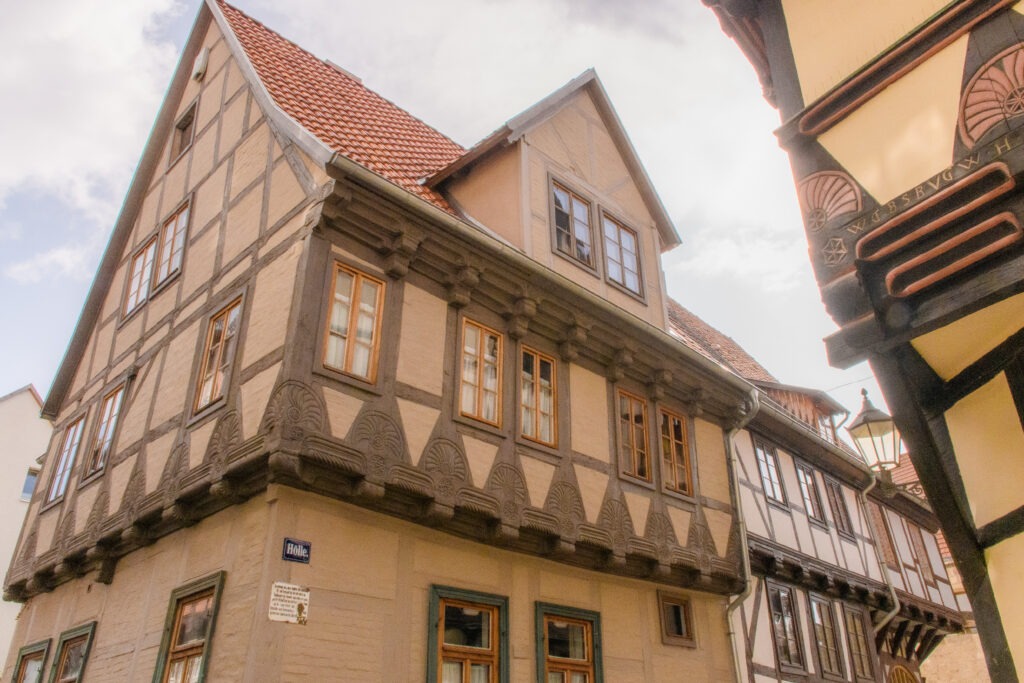
Klopstockhaus, the former residence of poet Friedrich Gottlieb Klopstock, provides a glimpse into the life and times of this literary figure.
Serving as the city’s first museum since 1899, this building from 1560 can be found below Quedlinburg’s Castle Hill.
Klopstock’s influential contributions to poetry, including his epic “The Messiah”, played a pivotal role in shaping literary trends. Paving the way for classical German literature to thrive and inspire subsequent generations of poets.
- 📍Schlossberg 12
- 🕙Open April to October (only) Wednesday to Sunday 10:00 am – 05:00 pm and holidays
- 3.50 € or a family card of 8 € (2 adults, 2 children)
12. Castle Museum (Schloss Museum Quedlinburg)
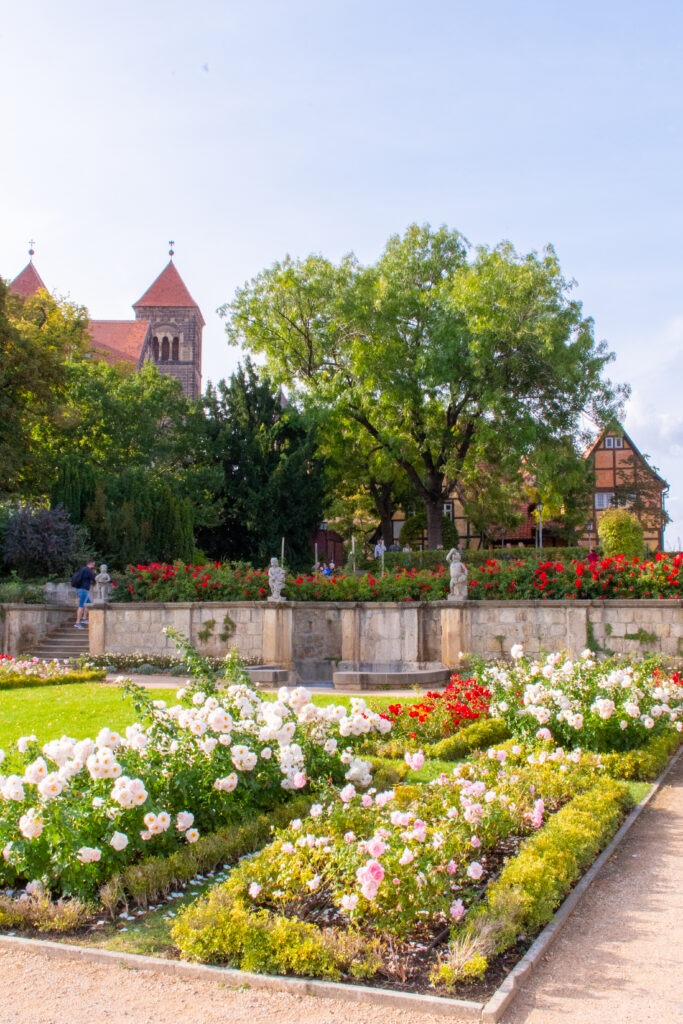
The Schloss Museum within Quedlinburg Castle is undergoing extensive renovations and restorations at the time of my visit (2023). It has been closed for renovations since 2020/2021.
Construction is currently transforming the former women’s convent with the hopes that visitors will soon be able to tour the Collegiate Church, cathedral treasury, and other rooms of significance.
Don’t let the massive construction deter you from visiting. You can still admire the monastery gardens on the hill plateau as well as soak up the captivating panoramic view of Quedlinburg’s historic half-timbered town. Also, the St. Servatius church is here too.
- 📍Schlossberg 1
- 🕙Closed for renovations
- One of the best free things to do in Quedlinburg is admire this view from above
13. Collegiate Church of St. Servatii (Stiftskirche im St Servatius)
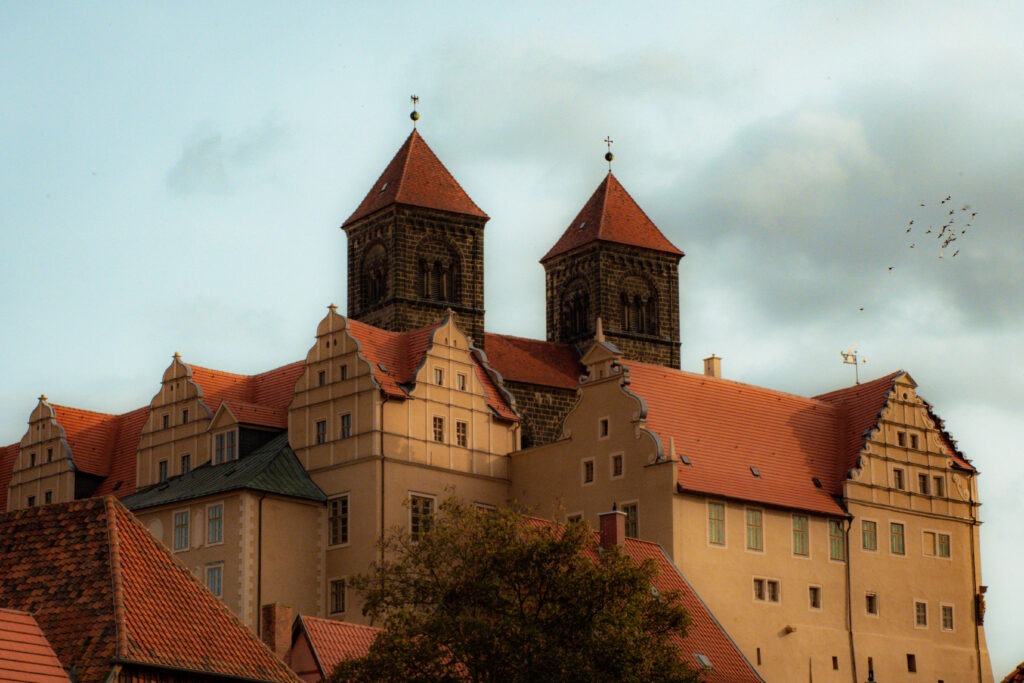
The Collegiate Church of St. Servatii in Quedlinburg, a UNESCO World Heritage site, has a history dating back to King Henry I in the 10th century.
Founded as a Palatinate Chapel, it later became his tomb. The church’s Romanesque architecture and medieval treasure art offer a vivid window into the era of the first German kings and emperors.
This Quedlinburg treasure houses well-preserved relics, manuscripts, sculptures, paintings, goldsmith works, ivory carvings, and even a unique knotted carpet from around 1200, the oldest in Europe.
- 🕙Open daily, except for Tuesdays, from 10:00 am – 4:00 pm (last entry at 3:00 pm)
- My experience: I arrived at 3:45 and the entrance fee was 6 € – two differences not reflected on their website
14. Munzenburg
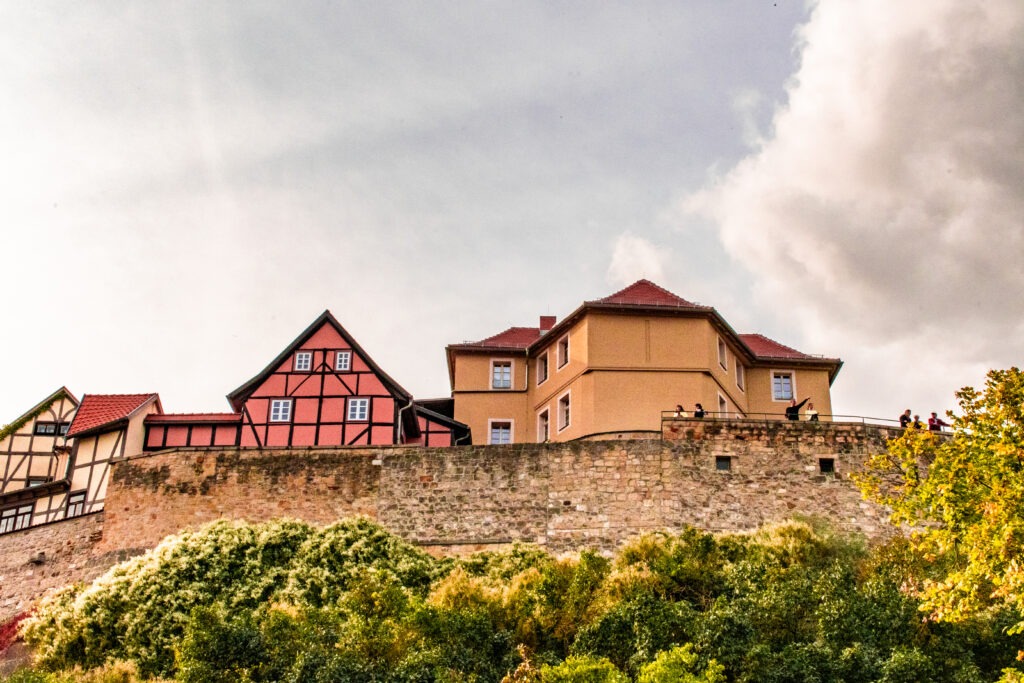
Munzenburg is a medieval fortress, that stands proudly atop a hill overlooking the town. Explore its ancient walls, and timbered houses and soak in breathtaking views of the well-preserved medieval town and surrounding countryside.
On the still-preserved walls of the Church of St. Mary on the Münzenberg in Quedlinburg, you can see all the elements of an Ottonian basilica with apse, transept, three-aisled nave and west building.
Founded in 986, you can see the still-preserved walls of the Church of St. Mary which existed until 1536. It was after this time that it was rebuilt with additional residential buildings.
14. St. Nikolai Church Quedlinburg (Niklolaikirche)
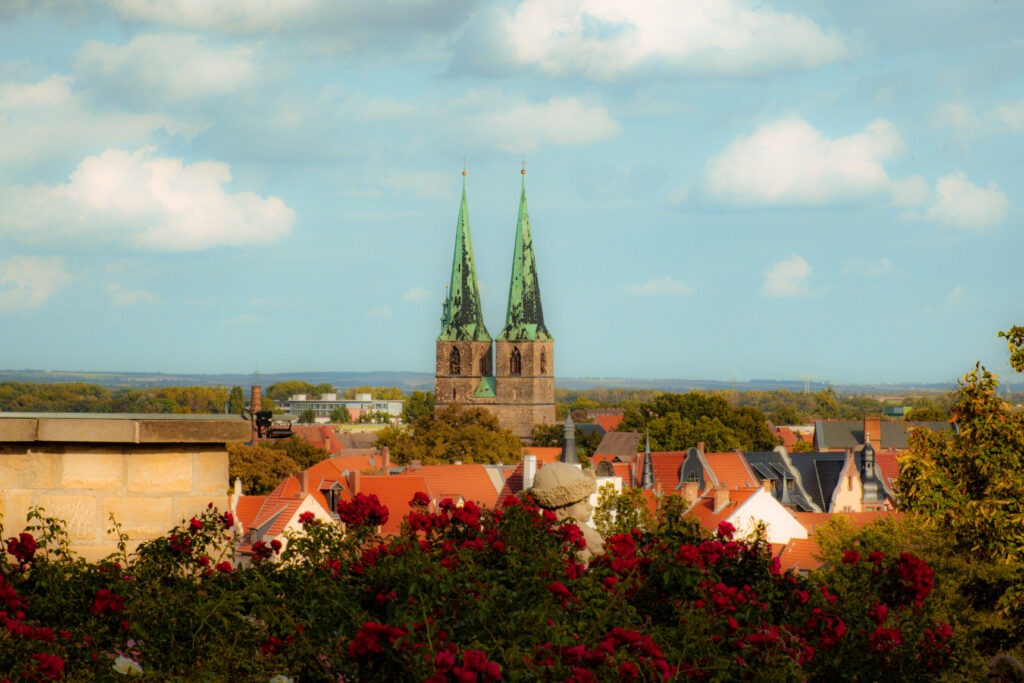
The St. Nikolai Church can trace its origins to around 1200 where Romanesque elements can still be found. According to the local legend, a shepherd’s newfound wealth from gold contributed to its financing. That’s why you will see a Baroque statue of a shepherd with his dog on one tower side, earning it the nickname of “shepherd’s church.”
In the 14th century, the church underwent a Gothic transformation, elevating its towers to their present height of 72 m. Another church that shapes the skyline of this charming German town.
- 📍Neustädter Kirchhof 1
- 🕙Open Monday to Saturday from 10:30 am – 4:00 pm, Sunday from 12:00 pm to 4:00 pm
- Free, welcomes a donation
15. Harz Time Museum (Harzer Uhrenmuseum)
A unique, family-friendly museum in Quedlinburg is Hazer Uhrenmuseum. With an impressive collection of approximately 300 cuckoo clocks, grandfather clocks, and various other timepieces. Watch as skilled watchmakers craft a cuckoo clock and delight in seeing the largest cuckoo clock made of chocolate.
If you had on your German souvenir list to purchase a cuckoo clock, this would be the place to go!
- 📍Lindenstraße 7
- 3 € and children 8 years and younger are free
- Recommended as one of the top things to do in Quedlinburg with kids
16. Hiking in the Harz
The Harz area has a comprehensive network of trails. I only wished we had time to add this to our itinerary. But I simply couldn’t tear myself away from the Altstadt.
The Quedlinburg Tourist office, located on the Marktplatz, has some great information. They told me there is over 69 km with two national trails being the most popular, the Selketal-Stieg and the Harzer Klosterwanderweg.
Serious hikers might be interested in this, as stamps can be collected on a variety of routes.
17. Hard Narrow Gauge Railway
Another fun thing to do in the Harz area is to climb aboard the Harz Narrow Gauge Railway, winding through the scenic Harz Mountains. This vintage railway offers a unique perspective of the region’s natural beauty.
For routes and ticket information, go to the Quedlinburg tourist office .
18. Bad Suderode
Had we not been travelling with our dog, I would have gladly ventured to Bad Suderode, a neighbouring spa town, for a relaxing soak in its thermal baths. We did this when we were in the Czech Republic’s spa town of Karlovy Vary and loved it!
I can only imagine the tranquil escape, offering you the perfect opportunity to unwind and recharge amidst the Harz Mountains’ serene beauty.
19. Goslar Quedlinburg Road Trip
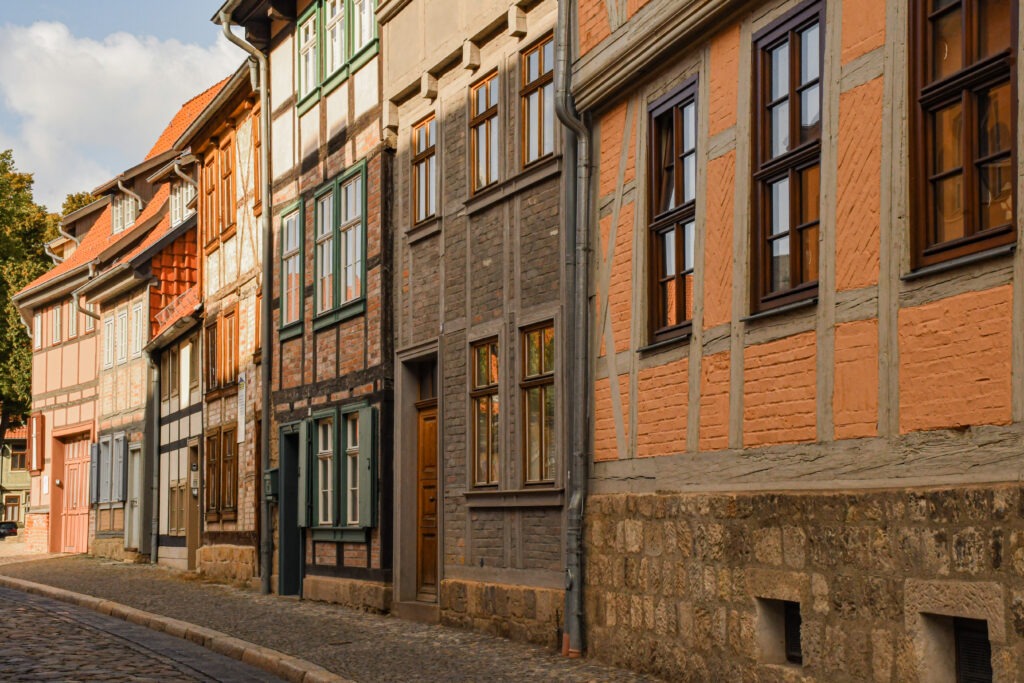
Day trip from one UNESCO-listed town to another. Goslar is another medieval charming town that features charming alleys, more timber-frame buildings, a glockenspiel (although not as famous as the one found in Munich ) and an awe-inspiring Imperial Palace.
Only plan to add this to your Quedlinburg itinerary if you are staying overnight. Otherwise, the timing is too tight.
20. Weihnachtsmarkt in Quedlinburg
Visit during the Christmas Market season and watch Quedlinburg’s historic streets transform into a winter wonderland. Twinkling lights adorn the half-timbered facades and quaint wooden stalls adorned with handcrafted ornaments, delicate lacework, and enticing aromas of roasted chestnuts and mulled wine linger through the air.
The Quedlinburg Christmas market Christmas will take place for 24 days from November 29 to December 22, 2023.
Cafes in Quedlinburg
Quedlinburg’s cafe scene is a delightful reflection of how cute, charming and cozy this German town is. Here are a few that caught my attention.
- Käsekuchenbäckerei Vincent: when a bakery has cheesecake in its name, you know they’re good!
- Samocca : this quaint cafe with its inviting atmosphere is a good spot for coffee lovers, alongside the delectable pastries.
- Quedlinburg – Kornmarkt 3 : is a unique old ruin with no roof that has turned itself into a cafe (in the am) and bar (in the pm).
Restaurants in Quedlinburg
In Quedlinburg, there is no shortage of restaurants to choose from, most of them serving traditional German cuisine like Ratskeller Quedlinburg , located in a historic cozy cellar beneath the town hall. Or we went to Brauhaus Lüdde , a local brewery that is located in the former gatehouse and stables of a large house, now a hotel.
If you’re in the mood for something more upscale, Weinstube im Hotel , a Michelin-star restaurant would be my pick.
Hotels in Quedlinburg
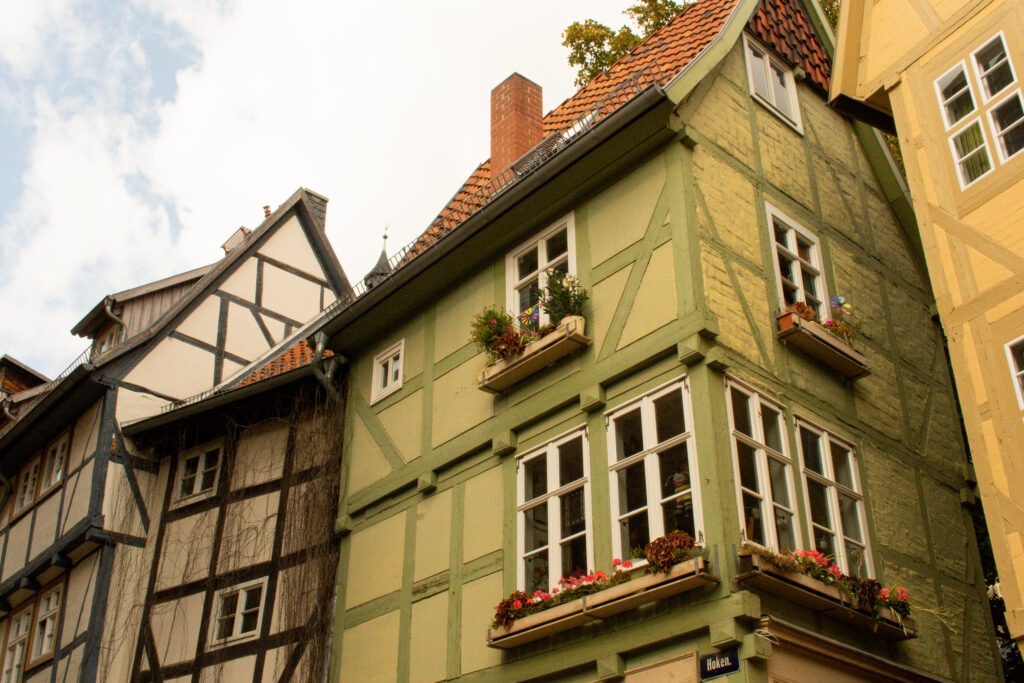
When considering an overnight stay in the town of Quedlinburg, you’ll want to ensure that your accommodation choice is as memorable as the destination itself.
Although I haven’t personally experienced these lodgings, I’ve meticulously sifted through ratings and reviews to curate a selection of the best hotels that promise an unforgettable stay.
Here are the top-rated options for you to consider:
- Romantik Hotel am Brühl : this elegant historical hotel lies in a secluded location just south of the Schlossberg mountain. It’s a perfect blend of original features with contemporary furnishings and is home to the only Michelin-starred restaurant in Quedlinburg. Guests love their beautifully appointed rooms, breakfast, scenic location and onsite restaurant.
- Wyndham Garden Quedlinburg Stadtschloss : situated in a former castle, this chain hotel offers contemporary furnishings with a touch of fairy-tale charm. Guests love its central location and fine wine collection in the Stadtschloss’s vaulted cellar.
- Hotel Zum Bär: this family-run hotel in Quedlinburg sits right on the historic Market Square. A timber-framed building offers comfortable, traditional-style rooms in this budget-friendly 3-star property with a restaurant that serves German cuisine. Guests love the friendly service, location, and breakfast.
Tourist Info Quedlinburg
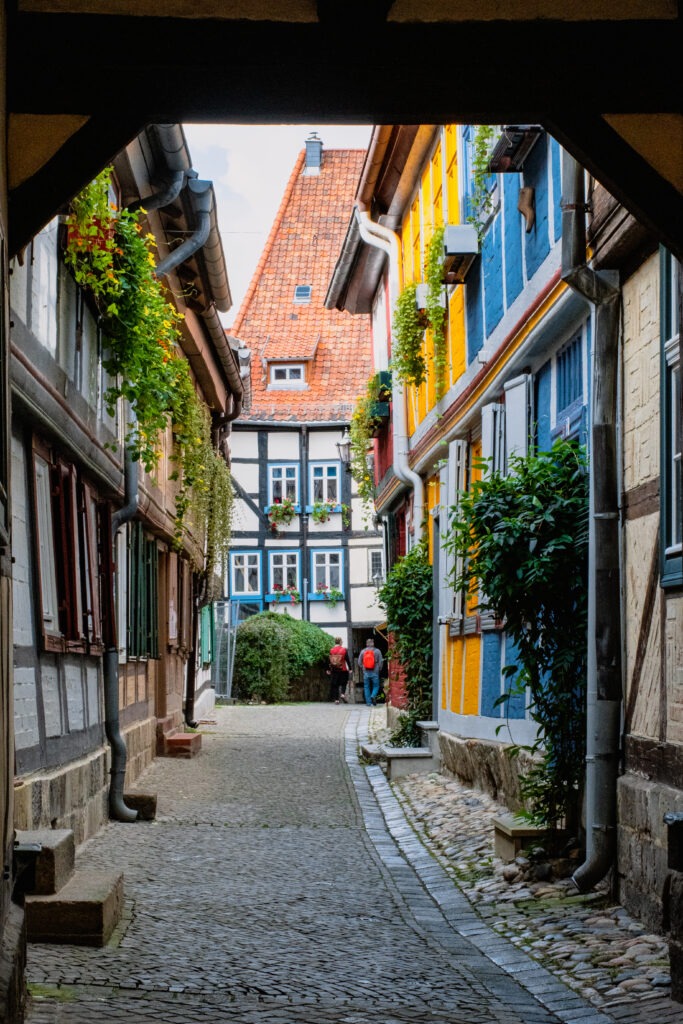
How to Get from Berlin to Quedlinburg
Travelling from Berlin to Quedlinburg is super easy. Both the train and car get you there in almost the same amount of time. We elected to rent a car for our Quedlinburg day trip as we were travelling with our dog, and it is a much more comfortable journey for him than by train. Also, it allowed us to stop along the way if we wanted to.
Berlin to Quedlinburg Train (note there are a few options, but I selected the shortest time duration)
- From Berlin’s central train station, Berlin Hauptbahnhof, take the IC2432 Norddeich Mole train to Magdeburg (4 stops in 90 minutes)
- Take the RE11 80500 Thale Hbf to Quedlinburg station (8 stops in 75 minutes)
- Total time is 2 hrs 45 mins
- Book train tickets in advance here
- Rent a car here (be sure to select unlimited km when booking)
- Using GPS, we took the A2 Autobahn towards Magdeburg, then B6 to Quedlinburg
- Driving time is 2.5 hours (224 km)
- Parking in Quedlinburg : there are several parking lots located near the Old Town. We parked at the lot closest to Sternkiekerturm. Parking is 1 € per hour.
As a Holidaymaker
There is no doubt that Quedlinburg has to be on your Germany itinerary. Whether you are touring northern Germany or taking a day trip from Berlin, Quedlinburg is worth visiting.
If you enjoyed this article, I invite you to read these other ones:
- Other popular day trips by train from Berlin
- 10 German towns and cities near Berlin
- A UNESCO-city road trip to 9 destinations near Berlin
If Berlin is on your radar, be sure to check out my latest articles to help you plan your trip, found at Germany Travel Blog .
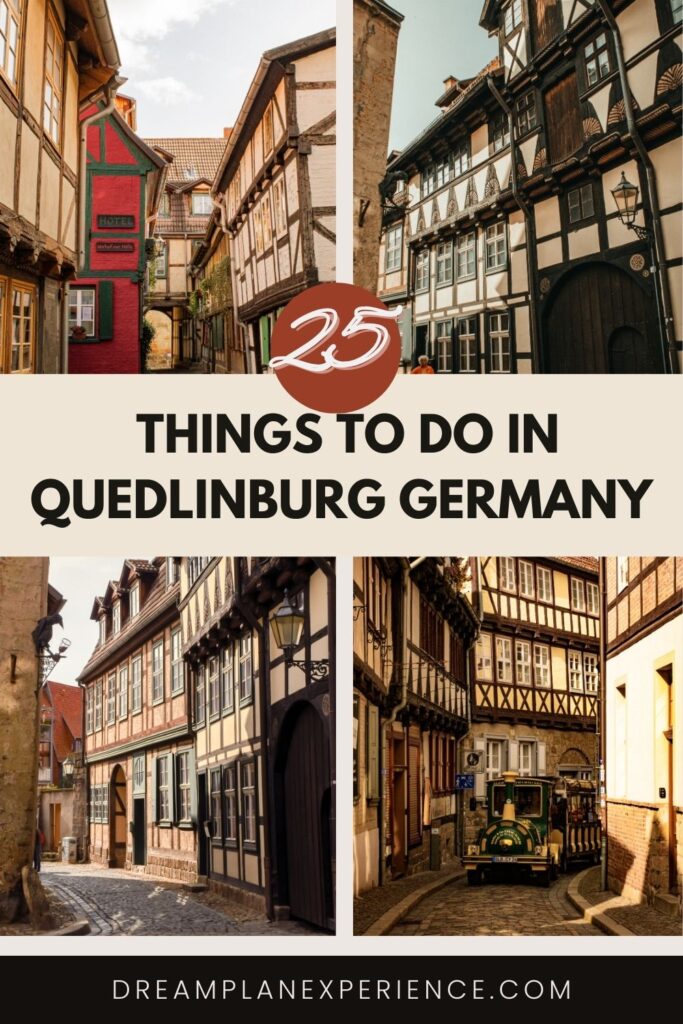
Creator, Founder of Dream Plan Experience
She specializes exclusively in European travel and crafting unforgettable day trips within her home province of Ontario, Canada.
She has been travelling to Europe for over 35 years and has lived abroad in Germany twice. Revisiting countries and exploring them extensively to create in depth travel itineraries, destination guides and helping travellers plan their trips to Europe through her customized services.
She also is a co-partner in a woman-led company that offers luxury retreats in Europe offering immersive cultural experiences.
Similar Posts
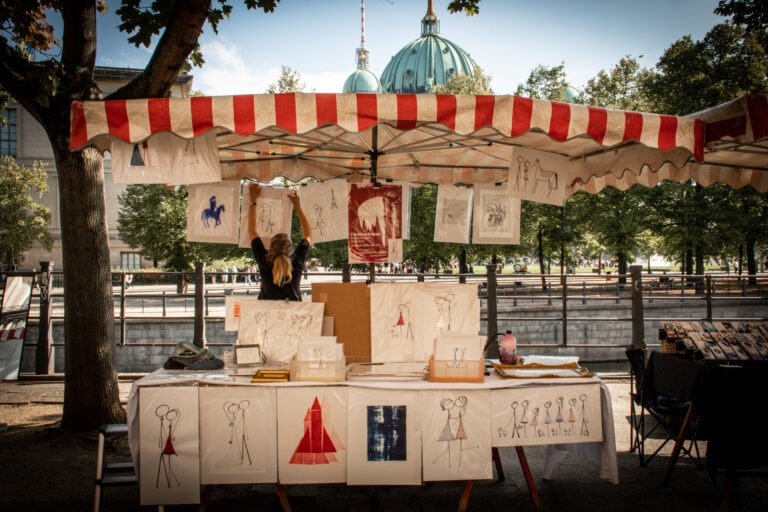
10 Best Flea Markets Berlin Has to Offer
Tucked away amidst the city’s eclectic neighbourhoods, an enchanting realm comes to life: the Berlin flea market. If you want to know…
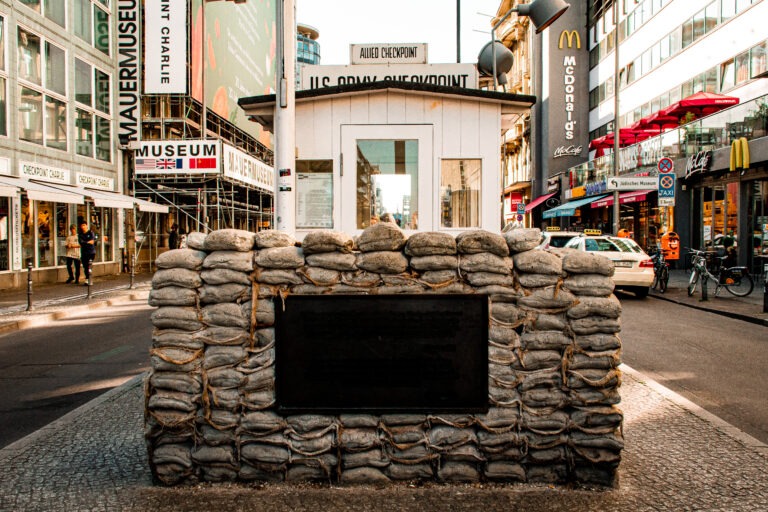
Why Is Checkpoint Charlie So Famous? Plan Your Visit Now
When it comes to iconic landmarks in Berlin, few hold as much historical significance and intrigue as Checkpoint Charlie. If you are…

Local’s Guide to Unter den Linden: Berlin’s Landmark Street
Have you ever strolled down the historic Unter den Linden boulevard in Berlin, Germany? Trust me, it’s a journey that will transport…

Your Ultimate Guide to Exploring Berchtesgaden National Park in Germany
Are you looking for deep dark forests, icy blue glaciers, idyllic valleys, peaceful green pastures, and picturesque lakes all within a breathtaking…

Take a Road Trip in Germany to 9 UNESCO City Gems
Taking a road trip in Germany is an adventure, especially when the itinerary is curated to explore its UNESCO-listed designations. From picturesque…

List of the 10 Best German Cities & Towns Near Berlin Germany
When one thinks of Germany, the vibrant and culturally rich city of Berlin often comes to mind. However, just beyond the capital…
THE 10 BEST Things to Do in Quedlinburg
Things to do in quedlinburg, explore popular experiences, tours in and around quedlinburg.

Mustard-Guided Manufaktur Sightseeing, tasting and factory sales

Three audio tours in Berlin and other German cities

09/20/2022 Cashflow 101 - Business Event in the Elbe - Boardinghouse by Andreas Köchy

Goslar City guided tour

Segway tour in Etzelsbach with Eichsfeld breakfast

Eisleben Private Walking Tour With A Professional Guide

Vacation Photographer in Magdeburg

Halle Private Walking Tour with a Professional Guide

Private Photo Session with a Local Photographer in Magdeburg

11/24/2022 - 42nd B-DAY Business Breakfast in the Elb - Boardinghouse Magdeburg
Top attractions in quedlinburg.

Other Top Attractions around Quedlinburg

What travellers are saying
- Quedlinburg Schloss
- Harzer Schmalspurbahnen
- Church of St. Servatius
- Mathildengarten
- Bremer Damm Teich bei Gernrode
- Sommer-Baden in und um Quedlinburg
Top Things to Do in Quedlinburg, Germany
Things to do in quedlinburg, explore popular experiences, tours in and around quedlinburg.

Mustard-Guided Manufaktur Sightseeing, tasting and factory sales

Three audio tours in Berlin and other German cities

09/20/2022 Cashflow 101 - Business Event in the Elbe - Boardinghouse by Andreas Köchy

Goslar City guided tour

Segway tour in Etzelsbach with Eichsfeld breakfast

Eisleben Private Walking Tour With A Professional Guide

Vacation Photographer in Magdeburg

Halle Private Walking Tour with a Professional Guide

Private Photo Session with a Local Photographer in Magdeburg

11/24/2022 - 42nd B-DAY Business Breakfast in the Elb - Boardinghouse Magdeburg
Top attractions in quedlinburg.

Other Top Attractions around Quedlinburg

What travellers are saying
- Quedlinburg Schloss
- Harzer Schmalspurbahnen
- Church of St. Servatius
- Mathildengarten
- Bremer Damm Teich bei Gernrode
- Sommer-Baden in und um Quedlinburg
Top Things to Do in Quedlinburg
Things to do in quedlinburg, explore popular experiences, tours in and around quedlinburg.

Mustard-Guided Manufaktur Sightseeing, tasting and factory sales

Three audio tours in Berlin and other German cities

09/20/2022 Cashflow 101 - Business Event in the Elbe - Boardinghouse by Andreas Köchy

Goslar City guided tour

Segway tour in Etzelsbach with Eichsfeld breakfast

Eisleben Private Walking Tour With A Professional Guide

Vacation Photographer in Magdeburg

Halle Private Walking Tour with a Professional Guide

Private Photo Session with a Local Photographer in Magdeburg

11/24/2022 - 42nd B-DAY Business Breakfast in the Elb - Boardinghouse Magdeburg
Top attractions in quedlinburg.

Other Top Attractions around Quedlinburg

What travelers are saying
- Quedlinburg Schloss
- Harzer Schmalspurbahnen
- Church of St. Servatius
- Mathildengarten
- Bremer Damm Teich bei Gernrode
- Sommer-Baden in und um Quedlinburg

Quedlinburg: The Most Charming Timber-Frame Town in Germany
What are some things to do in Quedlinburg, Germany during your visit?
Quedlinburg is a beautifully preserved medieval town situated on the north-eastern edge of the Harz Mountains in the state of Saxony-Anhalt, Germany and it dates back over a millennium!
The old town is a maze of Romanesque half-timbered houses featuring a castle, churches, gardens, squares and winding alleys where one could happily get lost for hours. Picturesque doesn’t even begin to do it justice.
Quedlinburg is also one of the stops on Germany’s Romanesque Road, a scenic route in the German state of Saxony-Anhalt that links village churches, monasteries, cathedrals and castles that were built between 950 and 1250. These represent the emergence of Christianity in this part of Germany, making it another reason to visit .
So without further ado, today we’re sharing some best things to do in Quedlinburg during your visit to this charming medieval town !

Things to do in Quedlinburg
Quedlinburg castle and collegiate church of st servatius.
The main attraction in Quedlinburg is, of course, Quedlinburg Castle, a medieval fortified abbey fortress that sits on a hill known as Schlossberg or ‘castle mountain’.

Within the complex, you also have the Collegiate Church of St Servatius. This church was dedicated in the year 1129, though it was preceded by earlier structures. It was one of the most highly regarded churches of the Empire during the Middle Ages.

In the crypt beneath the choir, you’ll find the royal graves of Henry the 1st and his wife Mathilde. King Henry the Fowler (also known as King Heinrich I) ruled during the early 10th century and is credited with being the founder of medieval Germany and i s considered the first German King,
Lastly, the Schlossgarten or ‘castle garden’ offers a nice vantage point over the city. It’s red rooftops and church steeples as far as the eye can see – the quintessential medieval town!
Together, the aforementioned church, castle and old town are UNESCO World Heritage Sites thanks to their outstanding example of a European town with medieval foundations and preserved timber-framed buildings.
Guided Walking Tour
In the morning we joined a guided walking tour to learn about the town’s unique architecture. If you enjoy doing walking tours when you first arrive in a new destination, consider this Quedlinburg walking tour or for something a bit more unconventional this evening walking tour where a night watchman takes you down medieval streets recounting tales from another time.
Quedlinburg happens to be Germany’s largest half-timbered town, with more than 1,300 timber-frame houses, and the cool thing is that you can walk around and see how this style evolved over the centuries.

One of the places we visited was the Timbered Museum that dates back to the 14th century and shows a very early example of this type of construction.
Here you can see an individual vertical beam from the ground all the way up to the roof, which meant the height of the framed houses was limited to the tallest trees that could be found.
Inside the museum’s courtyard , you can see examples of how timbered buildings were constructed – frames, walls and all.

We then continued our walk through town for more examples of how the half-timbered construction style evolved to have multiple protruding levels, and more elaborate design elements.
This town has some of the most interesting architecture we’ve seen, so if you’re into that sort of thing, it’s well worth joining a guided tour because you learn about all the little details that would otherwise go unnoticed.

Lunch at Hotel zum Bär
We had a hard time finding a restaurant that was open, but eventually stumbled upon Hotel zum Bär which is located in Market Square.

It was a very cool autumn day , so we were craving hearty dishes and big portions, and this restaurant delivered on both fronts.

I got the pork medallions served in a creamy mushroom sauce with a side of fried potatoes and bacon.
Meanwhile, Sam ordered the ‘Bear Platter’ (there was no bear meat, it was just a bear-sized portion!) featuring chicken, pork and beef on a bed of green beans with a side of potatoes and bacon.

We really enjoyed both meals and left feeling beyond satisfied.
Museum Lyonel Feininger
In the afternoon, we visited the Museum Lyonel Feininger , which bears the name of the German-American artist Lyonel Feininger.
Feininger was born in New York City but travelled to Germany at age 16 to study art. He was a leader in the Expressionist movement and worked as a painter, caricaturist and comic strip artist. He then went on to produce a large body of photographic works later in his career.

The museum houses many of his works and it’s a nice way to spend part of the afternoon if you enjoy art.
Cheesecake at Cafe Vincent
After exploring Quedlinburg on foot most of the day, we decided to treat ourselves to a mid-afternoon snack.
We went to Cafe Vincent which is best known for its Käsekuchen or cheesecake! It’s a very popular spot in town; there was actually a line of people waiting to order a slice of cheesecake from the window. Always a good sign.

What caught our attention was the variety of cheesecakes they had on offer: mango, blueberry, lemon and thyme, basil, caramel and more. The list was endless. We opted for the mascarpone cheesecake with wild berries which was super creamy.
We also got some cappuccinos to try and beat our jet lag.
Another thing to do in Quedliburg is to go for a stroll in Brühl Park. This park was just down the street from our hotel, so we made time to visit.
We first enjoyed a walk down Brühlstrasse, which is lined with beautiful mansions and villas. Eventually, we reached the Bode River, where a riverside trail led us to the park.
Brühl Park once formed part of the gardens of the former monastery and is home to a beautiful forest that feels like something out of a fairy tale .
Stay at Romantik Hotel am Brühl
During our visit to Quedlinburg, we stayed at Romantik Hotel am Brühl , a hotel situated just south of Schlossberg just a few minutes from the castle.
This hotel is spread out across a series of restored buildings including a timbered barn that was previously home to a seed-growing company, a palace formerly owned by a distillery, and a barn with Prussian vaulted ceilings.

The hotel also has two onsite restaurants: Weinstube which focuses on regional dishes with an haute cuisine twist, and Le Mariage which is a bit more exclusive (it only seats 20 guests who get to enjoy a 7-course meal).
We had dinner at Weinstube one night and enjoyed a lovely meal.
Final thoughts on visiting Quedlinburg
Hopefully this gives you an idea of some of the things you can do in Quedlinburg during your visit.
We arrived on an early morning train and then stayed in town for the night, so everything you see here was done with one day in Quedlinburg.
The nice thing about a small, walkable, medieval town is that you can see quite a lot in one day!
If you enjoyed this destination, you may also be interested in visiting the medieval town of Lüneburg that’s famous for salt, exploring Germany’s northernmost wine region of Saale-Unstrut, or going on a Black Forest road trip .

Ah, the simple pleasure of strolling through new destinations, enjoying their history and old buildings.
Audrey, your review has shown that Quedlinburg is a truly picturesque place to visit. It fascinates me that one can explore a significant portion of this small, walkable, medieval town within a single day!
By the way, your photographs are beautiful and enhance the place’s allure, making me even more intrigued and wanting to visit.
Cheers, Femi.
Really been debating between Quedlinburg, Bamburg or Nuremburg for my extra 3 days after leaving Berlin during my trip in October. Thanks for sharing the details of your visit!
Your email address will not be published. Required fields are marked *

Duisburg Travel Guide: Top 28 Things to Do in Duisburg, Germany
Welcome! Ready to discover Duisburg? Tucked away in the western part of Germany, this industrious city might not be on every traveler’s radar, but it’s packed with surprises that defy expectations. Duisburg marries a rich industrial heritage with sprawling green spaces, modern art, and a multicultural vibe that’s as welcoming as it is intriguing. Let’s dive into the heart of the Ruhr Valley and uncover the layers of Duisburg’s unique charm.
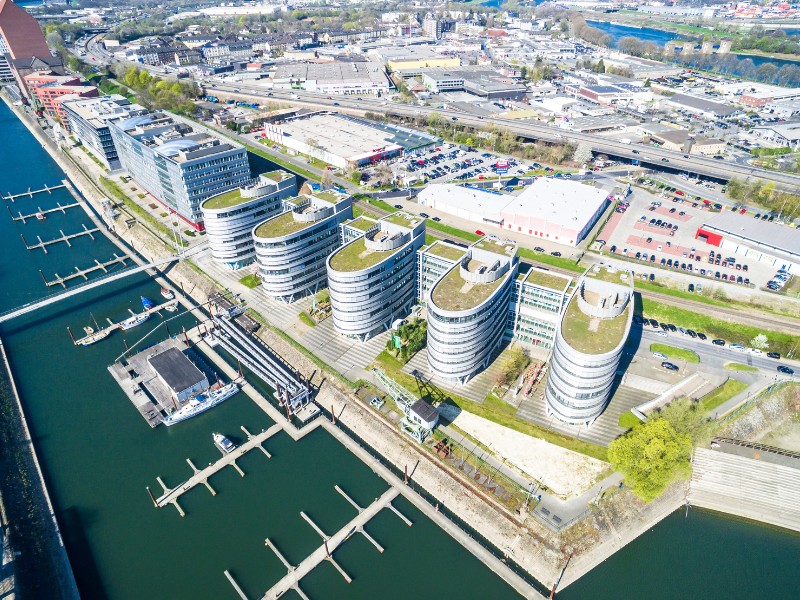
A City Shaped by Industry and Nature
Duisburg’s story is one of transformation. Once a giant in the coal and steel industries, the city has reinvented itself, weaving its industrial past into a vibrant cultural tapestry. The Landschaftspark Duisburg-Nord, a public park built on a decommissioned steel mill, symbolizes this shift perfectly. Here, blast furnaces serve as climbing walls, and old gasometers are now diving pools. It’s a place where history meets recreation head-on.
A Cultural Melting Pot
Duisburg’s streets buzz with a multicultural energy, a testament to its diverse community. From Turkish bazaars to Portuguese festivals, the city celebrates its international influences with flair. Foodies rejoice! The local culinary scene is a delightful journey through global cuisines, offering everything from authentic German dishes to Turkish kebabs and beyond.
Green Spaces Galore
Believe it or not, Duisburg is also a haven for nature lovers. The city is home to the Six Lakes Plateau (Sechs-Seen-Platte), a beautiful recreational area perfect for hiking, swimming, and sunbathing. Whether you’re looking to relax by the water or explore serene woodlands, Duisburg’s green spaces provide a peaceful escape from urban life.
Art and Events
Duisburg’s cultural calendar is brimming with events, from the renowned Duisburg Film Week to vibrant street festivals that light up the city. The Lehmbruck Museum, dedicated to modern sculpture, is a must-visit for art enthusiasts, showcasing works that challenge and inspire.
Duisburg: More Than Meets the Eye
So, why visit Duisburg? Because it’s a city that surprises you. It’s a place where industrial grit meets green serenity, where global cultures come together, and where art and history are alive in the streets. So, pack your bags (and maybe some preconceptions) and get ready to explore Duisburg.
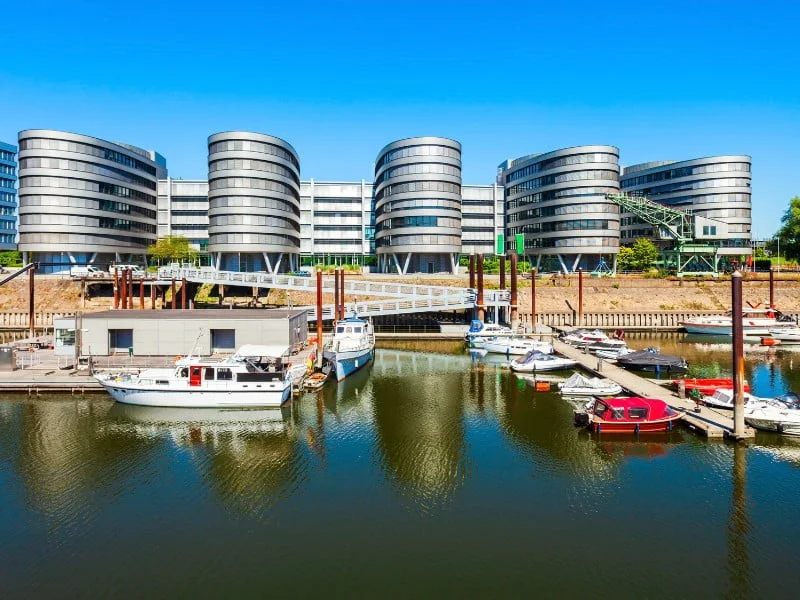

Duisburg City Guide: A Brief History Of Duisburg, Germany
Curious about how Duisburg evolved from a quiet Roman settlement to one of Germany’s most dynamic cities? So, grab a cup of coffee. And let’s embark on a quick journey through time, exploring the milestones that shaped Duisburg into the city it is today.
Ancient Beginnings and Medieval Might
Rome’s Far Reach : Duisburg’s story kicks off in the 5th century, with its roots as a small but strategic Roman outpost. Its location at the confluence of the Rhine and Ruhr rivers made it a prime spot for trade and military defense, laying the groundwork for its growth.
A Medieval Metropolis : Fast forward to the Middle Ages, and Duisburg had blossomed into a thriving medieval city. Granted city rights in 883, it became a key player in the Hanseatic League, Europe’s powerful network of merchant guilds and market towns, bolstering its status as a trading hub.
Industrial Revolution and War Time
The Iron Heart Beats : The 19th century heralded Duisburg’s transformation into an industrial behemoth. The discovery of coal in the Ruhr Valley fueled its ascent as a steel-producing titan. Factories sprouted, the population boomed, and Duisburg became the backbone of Germany’s industrial might.
Wartime Woes : The city’s strategic importance, unfortunately, made it a target during World War II, suffering significant damage. The resilience of its people shone through as they rebuilt from the ashes, turning tragedy into a catalyst for modernization and growth.
A New Chapter: Cultural Renaissance
Green Transformation : The closure of steel mills and coal mines in the late 20th century could have been a knockout blow. Instead, Duisburg turned its industrial heritage sites into cultural landmarks and green spaces. The Landschaftspark is a prime example, symbolizing the city’s knack for reinvention.
Cultural Hub : Today, Duisburg’s rich history melds with a vibrant cultural scene. It’s a place where art, music, and festivals thrive, where the past is honored, and the future eagerly embraced. The city’s diverse population adds layers of cultural depth, making it a mosaic of global influences.
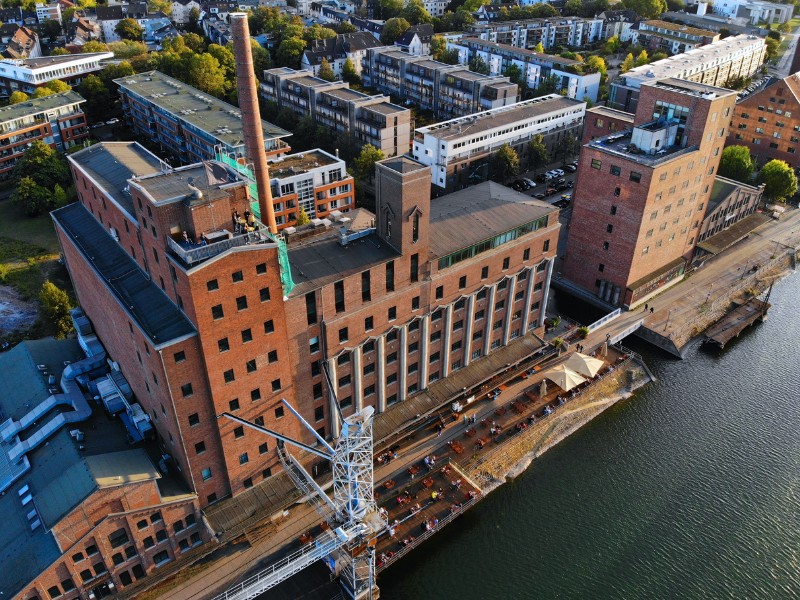
Duisburg Top Attractions and Best Places to Visit in Germany
Dortmund is a less-known German city . But Duisburg is even more under-the-radar. Most stumble upon it when visiting Landschaftspark, a famous historic industrial site. However, there’s so much more to this place than that.
In Duisburg, you’ll find amazing museums, parks, and a reworked waterfront. Don’t miss this off-the-beaten-track gem.
Are you looking for something different while in Duisburg? Landschaftspark , a former factory turned historic site, delivers just that. Fans of industrial grit will be in their element, as this former steel plant appears as it did when it shut down.
Apart from night-time art installations and safety improvements, it is what it is. Years ago, its structural steel helped build a nation. Climb to the top of its 80-metre tall blast furnace. From there, you’ll have amazing views over the site.
More Attractions
You’ll also find your next Duisburg attraction inside a former industrial work. However, Museum Küppersmühle instead features a fine collection of contemporary art. This former warehouse dates back to the mid 19th century. However, rather than foreign goods, it now holds works by Hans Uhlmann, Peter Brüning, and others.
When we wrote this guide, this attraction was closed for renovations. However, it’s currently slated to reopen in March 2021. Admission costs 9 EUR for adults, and 14 EUR for a family of four. Children under 16 are free.
Duisburg is far from the ocean. However, thanks to the Rhine River’s depth, ships used this city as a port throughout the Industrial Revolution. Learn more about this time at the German Inland Waterways Museum .
This institution sits in a gorgeous Art Nouveau building, which used to serve as a public bath. Where the men’s and women’s swimming pools used to exist, you’ll find two reconstructed boats. In other exhibits, you’ll learn the history of Duisburg as a port.
Out of town, take some time to check out Tiger & Turtle . This modern piece of art resembles a roller-coaster but is actually a series of twisted staircases. In spots, the steps invert, so you won’t be able to walk the whole thing.
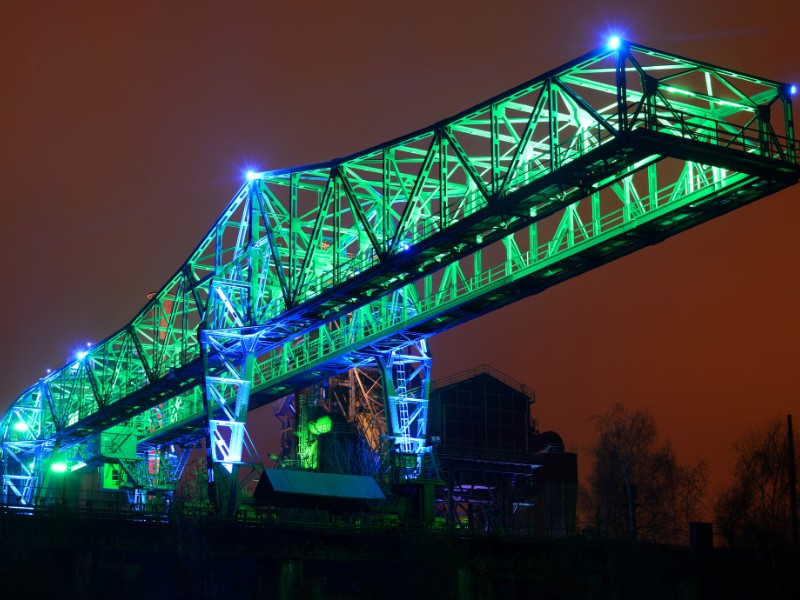
Other Cultural Attractions: Trip to Duisburg, Germany
Travelling as a family? Make time for a visit to the Duisburg Zoo . This complex is among the largest in Germany , with over 2,100 animals representing 280 species. This particular park is known for two species in particular – its dolphins and its koalas.
Admission is 24 EUR for families. Try to visit during the week, as this attraction is busy on weekends. Sunday is especially jammed, as few other things are open on this day.
Need to relax for a bit in nature? Spend some time unwinding at Sechs-Seen-Platte – the most beloved urban park in Duisburg. This park protects six lakes located just south of Duisburg city centre. As a result, this place is popular with boaters during the summer months.
Other Attractions
The city does not allow swimming in the lakes. However, an outdoor swimming pool near Wolfssee Lake gives the public a place to cool off. Climb this park’s 23-metre high steel observation tower for sweeping views over this park and the city.
Germans love football (soccer). So much so, that buying one Bundesliga ticket can cost a fortune. However, in Duisburg, it’s still possible for entire families to take in a live match at Schauinsland-Reisen-Arena .
The home team, MSV Duisburg, plays in Germany 3rd tier league. As a result, prices are much more reasonable. Want to take in a game? You’ll pay 12 EUR for standing room tickets, or 34 EUR for seats in the lower bowl.
Wind down your visit to Duisburg by spending an evening in the Inner Harbour . In its heyday, this was a busy port, with workers importing and exporting goods to/from ships. By 1960, the area fell into disuse. By the 1990s, though, things began to turn around. Today, you’ll find many restaurants and bars by Duisburg’s waterfront.
Top 28 Things To Do in Duisburg, Germany For Visitors
Here are the top 28 things to do in Duisburg:
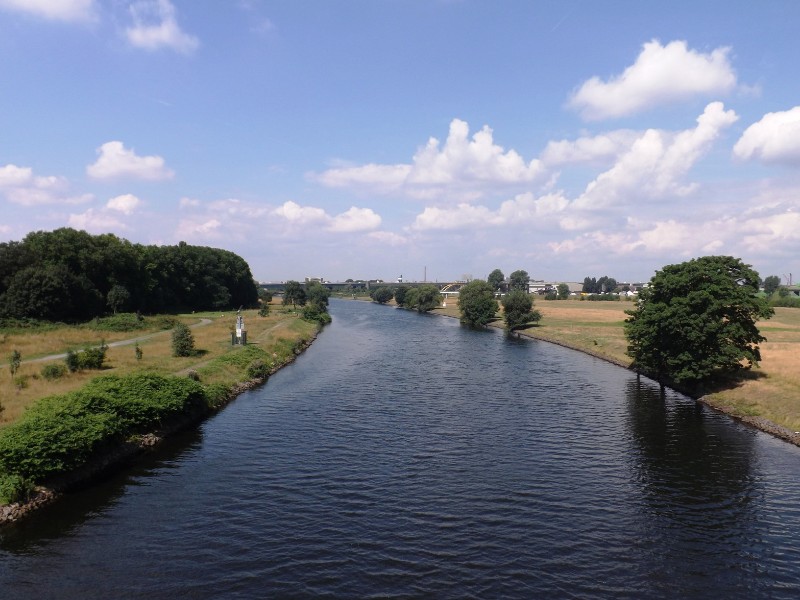
1. Visit the Landschaftspark Duisburg-Nord
An epitome of industrial culture turned into a public park, Landschaftspark Duisburg-Nord is where nature and industrial heritage blend. Visitors can explore old furnaces, gasometers, and bunkers, now repurposed for recreational activities like rock climbing and diving. The park lights up beautifully at night, offering a mesmerizing view. It’s a testament to how industrial spaces can be transformed into vibrant community hubs.
2. Explore the Duisburg Zoo
Home to over 10,000 animals, the Duisburg Zoo is renowned for its dolphinarium and the Koala House. It focuses on conservation, offering visitors a chance to learn about endangered species and their habitats. The zoo’s layout encourages leisurely walks through diverse animal exhibits. It’s a fun and educational destination for families and animal lovers.
3. Enjoy a Day at the Sechs-Seen-Platte (Six Lakes Plateau)
The Sechs-Seen-Platte is a recreational area with six interconnected lakes, offering opportunities for swimming, sailing, and walking. It’s a perfect spot for picnics, with numerous paths for biking and jogging around the lakes. The area’s tranquility makes it an ideal escape from the city bustle. Birdwatchers and nature enthusiasts can explore the diverse flora and fauna.
4. Discover the Inner Harbor (Innenhafen)
The Inner Harbor is a striking example of urban regeneration, transforming the city’s former industrial port into a lively cultural and commercial district. Visitors can find museums, restaurants, and modern architecture along the waterfront. The area is also known for hosting events and exhibitions. A walk through the Inner Harbor at sunset offers stunning views and a glimpse into Duisburg’s dynamic urban life.
5. Visit the Museum Küppersmühle (MKM)
Situated in the Inner Harbor, the Museum Küppersmühle is an art museum specializing in modern and contemporary art, housed in a converted grain mill. Its collection includes works by renowned German and international artists. The museum’s architecture, combining industrial heritage with modern design, is equally impressive. It’s a cultural landmark for art enthusiasts.
6. Stroll Through the Duisburg Botanical Garden
The Duisburg Botanical Garden is a peaceful oasis offering themed gardens, including a Japanese garden and a medicinal herb garden. It’s an educational space where visitors can learn about plant species from around the world. The garden hosts seasonal events and guided tours. It’s a beautiful spot for relaxation and nature walks.
7. Experience the Tiger & Turtle – Magic Mountain
This walkable rollercoaster sculpture, situated on a hill in Angerpark, offers panoramic views of Duisburg and its surroundings. The Tiger & Turtle – Magic Mountain is both an art piece and a viewing platform, with LED lights illuminating the structure at night. It’s an iconic landmark that combines art, leisure, and adventure. The climb to the top is rewarded with breathtaking views, especially at sunset.
8. Delve into History at the Culture and Local History Museum (Kultur- und Stadthistorisches Museum)
Housed in a historic granary, this museum offers insights into Duisburg’s rich history, from its Roman roots to its industrial development. Exhibits include medieval artifacts, historical documents, and interactive displays. The museum also showcases the city’s connection to Gerhard Mercator, the famous cartographer. It’s a must-visit for history buffs.
9. Relax at Sportpark Duisburg
Sportpark Duisburg is a vast sports complex offering facilities for athletics, soccer, rowing, and more. It’s a hub for both professional athletes and recreational sports enthusiasts. The park also features walking and cycling paths, making it a great place for outdoor activities. It hosts international competitions, offering visitors a chance to see top athletes in action.
10. Admire Modern Architecture at the Duisburg-Nord Landscape Park
Beyond its function as a public park, Landschaftspark Duisburg-Nord is also a showcase for innovative landscape design and modern architecture within an industrial setting. Guided tours offer deeper insights into the park’s architectural features and historical significance. The juxtaposition of industrial structures with green spaces and contemporary art installations is striking. It’s an architectural marvel reflecting Duisburg’s industrial past and creative future.
11. Take a Boat Tour on the Rhine
A boat tour on the Rhine offers a unique perspective on Duisburg’s industrial landscape and skyline. Visitors can learn about the city’s history as a significant inland port and enjoy scenic views along the river. Various tour options are available, ranging from short trips to day-long excursions. It’s a relaxing way to experience the beauty and industrial might of the Rhine.
12. Explore the Mercator Quarter
The Mercator Quarter is a historic district honoring the life and work of Gerhard Mercator, the renowned cartographer who lived in Duisburg. The area features buildings dating back to the Renaissance, along with modern installations celebrating Mercator’s contributions to cartography. Visitors can see the Mercator fountain and visit the Mercatorhalle, a concert hall named after him. It’s a blend of history, art, and music in the heart of Duisburg.
13. Visit the Wilhelm Lehmbruck Museum
Dedicated to modern sculpture, the Wilhelm Lehmbruck Museum houses an extensive collection of works by its namesake artist and other prominent sculptors. The museum’s architecture, with its spacious exhibition halls, complements the sculptures on display. It also hosts temporary exhibitions, workshops, and cultural events. It’s a cornerstone of Duisburg’s cultural scene, offering insights into the evolution of modern sculpture.
14. Attend the Duisburg Philharmonic Orchestra
Experience world-class music performances by the Duisburg Philharmonic Orchestra, held in the acoustically renowned Mercatorhalle. The orchestra has a rich tradition of performing classical and contemporary works. Attending a concert here is not only a treat for the ears but also an opportunity to enjoy the impressive architecture of the concert hall. It’s a cultural highlight for music lovers visiting the city.
15. Shop at Forum Duisburg
Forum Duisburg is one of the city’s largest shopping centers, offering a wide range of stores, from international brands to local boutiques. It’s a modern shopping destination with fashion, electronics, and home goods, along with dining options. The center frequently hosts events and promotions, adding to the shopping experience. It’s a convenient place for visitors to find everything they need under one roof.
16. Unwind at Toeppersee
Toeppersee is a serene lake located in the southern part of Duisburg, ideal for swimming, sailing, and family picnics. The lake is surrounded by walking and biking paths, making it a popular recreational area. It also features a beach volleyball court and a playground for children. The lake’s calm waters and green surroundings offer a peaceful escape from urban life.
17. Participate in the Duisburg Christmas Market
The Duisburg Christmas Market transforms the city center into a winter wonderland, with festive stalls selling crafts, gifts, and traditional holiday treats. It’s one of the largest Christmas markets in the region, attracting visitors from all over. The market features a large ice skating rink and a Ferris wheel, providing fun for the whole family. The festive atmosphere, with its lights and decorations, is magical.
18. Learn at the Explorado Children’s Museum
The Explorado Children’s Museum is an interactive museum designed specifically for children, offering hands-on exhibits on science, technology, and society. It encourages curiosity and learning through play, making it an educational yet fun experience. The museum covers various topics, from human anatomy to environmental conservation. It’s an ideal destination for families with young children.
19. Explore the Duisburg City Hall (Rathaus Duisburg)
The Duisburg City Hall is an impressive building featuring early 20th-century architecture. Visitors can admire its ornate façade and, on certain days, explore the interior, including the council chamber. The Rathaus is not only a center of municipal governance but also a symbol of Duisburg’s resilience and growth. The plaza in front of the City Hall is a gathering place for civic events and celebrations.
20. Enjoy the Water Sports at Wedau Sports Park
Wedau Sports Park is a premier destination for water sports enthusiasts, offering facilities for rowing, canoeing, and water skiing. The park has hosted numerous national and international competitions, making it a significant site for sports in Germany. It also features sports fields, a swimming pool, and fitness trails. The park’s vibrant sports community and excellent facilities make it a great place for both watching and participating in sports activities.
21. Visit the Loveparade Memorial
The Loveparade Memorial commemorates the victims of the Love Parade tragedy in 2010. It’s a poignant site, featuring 21 steel pillars representing each person who lost their life during the event. The memorial is a place of reflection and remembrance, highlighting the importance of safety at public events. Visitors can pay their respects and learn about the impact of the tragedy on the city and the electronic music community.
22. Stroll Through Kaiserberg Park
Kaiserberg Park is one of Duisburg’s largest and most beautiful parks, offering lush landscapes, walking paths, and a small zoo. It’s an oasis in the city, perfect for leisurely walks, jogging, and picnics. The park also features historical monuments and sculptures. It’s a popular spot for relaxation and outdoor activities, enjoyed by locals and visitors alike.
23. Explore the RheinPark
RheinPark offers stunning views of the Rhine River and is a prime location for watching ships pass by. The park features wide open spaces, playgrounds, and a beach volleyball court. It’s an excellent venue for outdoor concerts and festivals during the summer months. The RheinPark is a favorite among residents for its recreational opportunities and scenic beauty.
24. Experience the Harbor Tour
A harbor tour in Duisburg provides an up-close look at one of the world’s largest inland ports. Visitors can learn about the logistics, history, and significance of the Duisburg Port. The tours offer fascinating insights into the city’s industrial backbone and its role in global trade. It’s an interesting activity for anyone curious about maritime and industrial operations.
25. Attend the Duisburger Akzente
The Duisburger Akzente is an annual arts festival that showcases theater, music, literature, and visual arts. It focuses on contemporary social issues and cultural diversity, offering a platform for dialogue and creativity. The festival attracts artists and performers from around the world, making it a highlight of Duisburg’s cultural calendar. It’s an enriching experience for arts and culture enthusiasts.
26. Discover the Six Lakes District (Sechs-Seen-Platte)
The Six Lakes District is a beautiful area created from gravel pits, now a leisure destination with lakes for swimming, sailing, and fishing. It’s interconnected by paths suitable for walking and cycling, offering a picturesque landscape. The district is a testament to successful land reclamation and environmental conservation. It’s a peaceful spot for enjoying nature and outdoor activities.
27. Visit the MKM Museum Küppersmühle for Modern Art
Housed in a beautifully converted grain mill, the MKM Museum Küppersmühle features an impressive collection of modern and contemporary art. The museum showcases works by prominent German and international artists. The architecture of the museum itself is a highlight, blending industrial heritage with modern design. It’s a must-visit for art lovers and those interested in the transformation of industrial spaces.
28. Watch a Performance at the Duisburg Theater
The Duisburg Theater is a key cultural venue offering a wide range of performances, from opera and ballet to drama and musicals. It’s known for its high-quality productions and collaborations with international artists. The theater’s architecture, with its modern and classic elements, provides an elegant setting for cultural experiences. Attending a performance here is a delightful way to immerse oneself in the city’s vibrant arts scene.

What To Eat and Drink in Duisburg, Germany
Duisburg is part of Westphalia. As such, you’ll find many dishes common to this region in this city’s restaurants. However, Duisburg is best known for Bratkartoffeln . Cooks prepare this potato-based dish by pan-frying them with ham, bacon, onions, and other vegetables.
Feeling brave? If you spot it on a menu, order some Steinfurter Töttchen . This dish got its start from butcher’s leftovers. Things like offal, calf’s head, and other non-premium cuts were cooked with onions and given to the less fortunate.
After dinner, give your day a sweet ending by enjoying some Butterkuchen . As the name suggests, pastry chefs make this cake primarily with butter and sugar. You’ll often find it topped with almonds and pieces of actual butter.
Let’s take a gastronomic tour through some must-try dishes and beverages in this dynamic city.
Traditional German Delights
1. Currywurst : Start your culinary adventure with a classic German street food. Currywurst is a savory delight, featuring a steamed then fried pork sausage cut into slices and seasoned with curry ketchup. It’s a simple yet satisfying dish, perfect for on-the-go eating.
2. Rheinischer Sauerbraten : This marinated pot roast, often made with beef (but sometimes with venison or lamb), is a beloved dish in the Rhineland. The meat is tenderized in a mixture of vinegar, water, and spices before being slow-cooked. It’s typically served with red cabbage and potato dumplings, making for a hearty, comforting meal.
3. Pfefferpotthast : A traditional Westphalian stew that packs a punch with its pepper seasoning. The dish consists of beef simmered in a broth with onions, anchovies, and a generous amount of pepper. It’s a warming dish, perfect for Duisburg’s chilly evenings.
International Cuisine
4. Turkish Kebabs and Mezes : Duisburg’s large Turkish community means you’re never far from an authentic kebab or a selection of mezes. These small dishes, perfect for sharing, include favorites like hummus, stuffed vine leaves, and eggplant salad.
5. Dutch Fries : Given Duisburg’s proximity to the Netherlands, Dutch-style fries are a popular snack. Thick-cut and served in a paper cone with a variety of toppings and sauces, they’re a must-try for potato lovers.
Local Brews and Beverages
6. Altbier : While Düsseldorf claims fame to Altbier, Duisburg is just a stone’s throw away and offers its own take on this traditional German beer. Dark, top-fermented, and with a hoppy taste, it’s a refreshing choice.
7. German Riesling : The Rhineland is known for its vineyards, and Duisburg is the perfect place to sample a glass of Riesling. This wine ranges from sweet to dry, making it a versatile companion to many dishes.
Sweet Treats
8. Apfelstrudel : For dessert, indulge in an Apfelstrudel. This traditional pastry is filled with tart cooking apples, sugar, cinnamon, and raisins, served warm with a side of vanilla ice cream or whipped cream.
9. Schneeballen : A fun and unique treat, Schneeballen, meaning “snowball,” consists of shortcrust pastry rolled into a ball, deep-fried, and then coated with powdered sugar or chocolate. It’s a delightful sweet to enjoy with a cup of coffee.
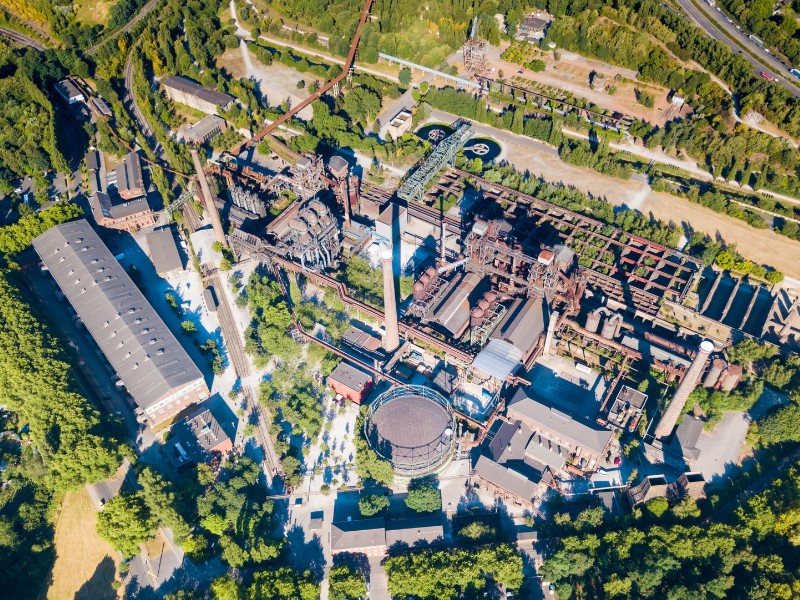
Tours For Visitors To Duisburg, Germany
Here’s a look at the types of tours and experiences you might find in a city like Duisburg, based on its known attractions and cultural offerings:
1. Landschaftspark Duisburg-Nord Tour
Discover the transformation of Duisburg’s industrial past into a green, public space. Tours of Landschaftspark might include guided walks explaining the history and architecture of the former steel mill, night tours showcasing the park’s dramatic lighting, or even diving excursions in the gasometer.
2. Harbor Boat Tours
Explore the world’s largest inland port on a guided boat tour. These tours provide insight into Duisburg’s historical and ongoing significance as a logistic hub, offering views of the docks, warehouses, and the bustling activity of the port.
3. Industrial Heritage Route
Join a cycling or bus tour along the Industrial Heritage Trail, which connects significant industrial landmarks across the Ruhr Valley, including Duisburg. It’s a fantastic way to understand the region’s industrial revolution and its impact on local culture.
4. Cultural and Historical City Walks
Embark on a walking tour through Duisburg’s city center and historic districts. These tours highlight architectural landmarks, historical sites, and stories from the city’s past, offering a glimpse into its development over the centuries.
5. Art and Museum Tours
With its vibrant art scene, Duisburg offers tours of its galleries, museums, and public art installations. Specialized tours might focus on contemporary art, local history, or specific exhibitions at places like the Lehmbruck Museum.
6. Culinary Tours
Experience Duisburg’s diverse culinary scene with a guided tasting tour. From traditional German fare to international cuisine reflecting the city’s multicultural community, these tours delight foodies looking to explore local flavors and culinary traditions.
7. Nature and Park Walks
Discover Duisburg’s green side with guided tours of its parks and natural reserves. These might include botanical tours, bird-watching walks, or leisurely strolls through scenic areas like the Six Lakes Plateau.
8. Zoo Duisburg Experience
For families and animal lovers, guided tours of Zoo Duisburg offer an educational and fun experience. Learn about conservation efforts, get up close with exotic animals, and discover the zoo’s role in international breeding programs.
9. Beer Tasting and Brewery Tours
Dive into Germany’s celebrated beer culture with a tour of local breweries in and around Duisburg. Learn about the brewing process, sample various beer styles, and hear stories from master brewers.
10. Sports and Adventure Activities
For those looking for a bit more adrenaline, Duisburg and its surroundings offer adventure tours, including climbing in the Landschaftspark, kayaking on the Ruhr River, or biking along the industrial heritage sites.
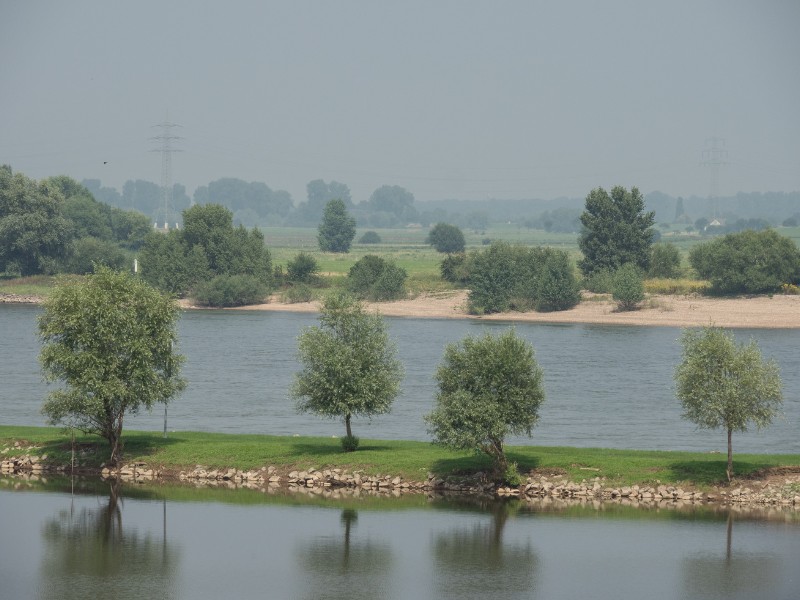
Day Trips From Duisburg, Germany
Here’s a compilation of day trips from Duisburg that promise enriching experiences and memorable adventures.
Just a short train ride away, Cologne offers a blend of historical, cultural, and gastronomic delights. The city’s centerpiece, the Cologne Cathedral, is a stunning example of Gothic architecture. Cologne is also known for its vibrant art scene, numerous museums, and the lively Old Town. Don’t miss trying the local Kölsch beer in one of the traditional breweries.
2. Düsseldorf
Düsseldorf, the state capital, is renowned for its fashion industry, avant-garde architecture, and the bustling Königsallee shopping street. The Altstadt, or Old Town, is often referred to as “the longest bar in the world” due to its high density of bars and pubs. The city’s vibrant art scene can be explored through numerous museums and galleries. The Rhine embankment promenade offers splendid views and a pleasant atmosphere for a leisurely stroll.
Explore the cultural heart of the Ruhr area in Essen. The Zollverein Coal Mine Industrial Complex, a UNESCO World Heritage site, provides an intriguing look into the region’s industrial past. Essen is also home to the beautiful Grugapark, one of Germany’s largest and most picturesque city parks. The Museum Folkwang, with its impressive collection of 19th and 20th-century art, is a must-visit for art enthusiasts.
Dive into Germany’s ancient Roman history at the Archaeological Park Xanten, the largest outdoor museum in the country. Here, you can explore the remains of the Roman city of Colonia Ulpia Traiana. Xanten’s medieval center, with its charming market square and the stunning Xanten Cathedral, is also worth exploring. The park regularly hosts events and reenactments, bringing Roman history to life.
5. The Netherlands: Venlo
A trip to Venlo in the Netherlands offers a change of scenery and a glimpse into Dutch culture, just across the border from Germany. The city is known for its historic center, vibrant market, and the Limburgs Museum, which showcases the region’s history and art. Venlo is also a great place for shopping and enjoying Dutch cuisine. The city’s location by the Maas River provides opportunities for scenic walks and bicycle tours.
Münster, with its historic old town, prestigious university, and numerous museums, offers a perfect blend of history and vibrant city life. The city is known as the “bicycle capital” of Germany, making it perfect for exploring on two wheels. The Prinzipalmarkt, with its iconic gabled houses, and the stunning St. Paulus Dom are must-sees. Münster is also home to the Peace Hall, where the Peace of Westphalia was signed, ending the Thirty Years’ War.
Famed for its historic cathedral, where German kings were crowned, Aachen is steeped in history and royal legacy. The city’s thermal springs have attracted visitors since Roman times. Aachen’s charming old town offers cozy cafes, boutiques, and the impressive Aachen Town Hall. Don’t leave without trying the local specialty, Printen, a type of gingerbread.
8. The Rhine Valley
Embark on a scenic journey through the Rhine Valley, known for its breathtaking landscapes, medieval castles, and picturesque vineyards. The Rhine River Cruise provides stunning views of the Loreley Rock and numerous historic towns along the way. The valley is also a renowned wine-producing region, offering ample opportunities for wine tasting. The town of Bacharach, with its well-preserved medieval architecture, is particularly charming.
Discover Bonn, the former capital of West Germany, rich in political history and cultural heritage. The Beethoven-Haus, birthplace of the famous composer, is a highlight for music lovers. The Museum Mile features several notable museums, including the Haus der Geschichte, focusing on Germany’s contemporary history. Bonn’s cherry blossom-lined streets offer a stunning spectacle in spring.
10. Teutoburg Forest
For nature enthusiasts, the Teutoburg Forest offers lush landscapes, hiking trails, and the famous Hermannsdenkmal, a monument commemorating the Battle of the Teutoburg Forest. The Externsteine, striking sandstone rock formations, are a natural wonder not to be missed. The area is also home to several charming small towns and historic spa resorts. It’s an ideal getaway for outdoor activities and relaxation.
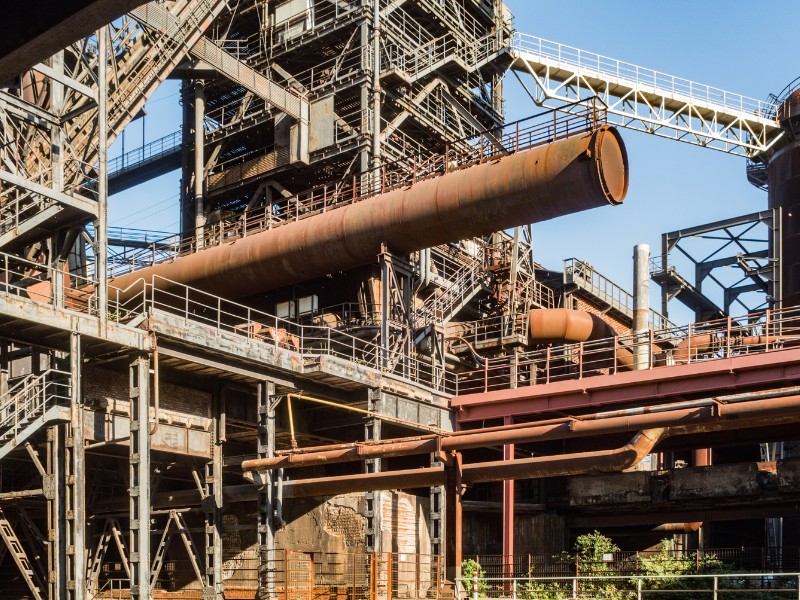
Duisburg Transportation Guide
Here’s a travel guide to getting around Duisburg:
1. Duisburg Stadtbahn (U-Bahn)
- The Duisburg Stadtbahn, often referred to as the U-Bahn, is an underground/subway system that serves the city and its surrounding areas. It’s a fast and convenient way to get around, connecting major districts, attractions, and the university.
- Key lines include the U79, which connects Duisburg to Düsseldorf, offering an easy commute between the two cities.
2. Trams (Straßenbahn)
- Duisburg’s tram network complements the U-Bahn, providing extensive coverage within the city. Trams are a scenic and efficient way to explore Duisburg, with several lines traversing major routes.
- Notable tram lines include Line 901, which offers a direct route through the city center and towards Mülheim an der Ruhr.
- A dense network of buses serves areas not covered by the U-Bahn or trams, ensuring comprehensive city-wide coverage. Bus stops are conveniently located and offer frequent services to residential areas, industrial zones, and neighboring towns.
- Night buses operate on weekends, providing safe transportation options during late hours.
4. Deutsche Bahn (DB) Regional and S-Bahn Trains
- For longer distances or trips to neighboring cities within the Rhine-Ruhr metropolitan area, Deutsche Bahn’s regional trains and the S-Bahn network are ideal. Duisburg Hauptbahnhof (main station) is a central hub for regional and long-distance travel.
- The S-Bahn line S1 connects Duisburg with other major cities in the Ruhr area, such as Essen and Dortmund, facilitating easy day trips and commutes.
- Duisburg is equipped with bike paths and lanes, making cycling a viable and eco-friendly option for getting around. The city is part of the NRW Radnetz (bike network), with designated routes for cyclists.
- Bike rental services, including those offered by Deutsche Bahn (Call a Bike), allow for flexible short-term use.
6. Car Sharing and Rentals
- For more flexibility, car sharing and rental services are available in Duisburg. These options are ideal for exploring the wider Rhine-Ruhr region or for when public transportation doesn’t suit your schedule.
- Major rental companies have offices at the Duisburg Hauptbahnhof and other convenient locations throughout the city.
- Taxis provide a direct and convenient way to reach your destination, especially outside the operating hours of public transportation. Taxi stands are located at the Hauptbahnhof, major attractions, and shopping areas.
- Ride-hailing apps also operate in Duisburg, offering an alternative means of booking rides.
Transportation Tips:
- Ticketing : The VRR (Verkehrsverbund Rhein-Ruhr) offers a range of ticket options that cover buses, trams, U-Bahn, and S-Bahn within Duisburg and the broader Rhine-Ruhr region. Tickets can be purchased at stations, online, or via mobile apps.
- DB Navigator App : Useful for planning trips and purchasing tickets for regional trains and S-Bahn services.
- DVG Mobile App : The official app of Duisburg’s public transportation provider (DVG) is handy for route planning, timetables, and ticket purchases for local transit.

Where To Visit After Your Trip To Duisburg?
From historical cities and natural wonders to cultural hubs, here’s a list of places to visit after your trip to Duisburg, each offering its unique charm and attractions.
Just an hour away, Cologne boasts a stunning Gothic cathedral, a vibrant arts scene, and the lively Altstadt (Old Town). The city is famous for its Kölsch beer, Carnival celebrations, and the Museum Ludwig, which houses a significant collection of modern art. Don’t miss a walk along the Rhine for picturesque views of the cityscape.
Düsseldorf, the state capital, is renowned for its fashion industry, cutting-edge architecture, and the Königsallee, one of the most luxurious shopping streets in Germany. The Altstadt offers over 260 bars and restaurants, earning it the nickname “the longest bar in the world.” The city also hosts the largest Japanese community in Germany, reflected in its excellent sushi restaurants and the annual Japan Day festival.
A key city of the Ruhr industrial region, Essen is home to the Zollverein Coal Mine Industrial Complex, a UNESCO World Heritage site that symbolizes the area’s industrial history. The city also offers green escapes such as the Grugapark and cultural venues like the Museum Folkwang, with its impressive collection of 19th and 20th-century art.
4. The Rhine Valley
For breathtaking natural beauty, head to the Rhine Valley, where you can explore medieval castles, vineyards, and picturesque villages along the Rhine River. Take a river cruise to see the legendary Lorelei rock and sample some of the world’s best Rieslings. The area is perfect for hiking, cycling, and wine tasting tours.
Known for its historic cathedral, where German kings were once crowned, Aachen is steeped in history and European significance. The city is also famous for its thermal springs and the RWTH Aachen University, one of the largest technical universities in Germany. The Christmas market around the cathedral is one of the most beautiful in the country.
Münster is a charming city with a vibrant student population, known for its well-preserved medieval old town and the peace treaties of Westphalia. The city is considered Germany’s cycling capital, offering numerous bike paths and green spaces. The Prinzipalmarkt is a picturesque square surrounded by gabled houses and historic buildings.
Delve into Germany’s Roman past at the Archaeological Park Xanten, where you can explore the remnants of the Roman city of Colonia Ulpia Traiana. The park offers insights into ancient Roman life through reconstructed buildings and interactive exhibits. Xanten’s medieval center and the stunning Xanten Cathedral add to the town’s appeal.
8. The Netherlands: Amsterdam
A bit further afield, Amsterdam awaits with its iconic canals, world-class museums, and vibrant nightlife. The city’s rich artistic heritage is on display at the Van Gogh Museum and the Rijksmuseum. Amsterdam’s open-minded culture and picturesque streets make it a must-visit European capital.
9. Belgium: Brussels
Just a few hours from Duisburg, Brussels, the heart of the European Union, offers stunning architecture, historic sites, and culinary delights like Belgian waffles and chocolates. The Grand Place is a UNESCO World Heritage site known for its ornate buildings and lively atmosphere. Don’t miss the Atomium and the Mini-Europe park for a unique experience.
10. Luxembourg City
Explore the blend of medieval, Gothic, and modern architecture in Luxembourg City, the capital of one of Europe’s smallest countries. The city’s fortress, the Casemates du Bock, offers spectacular views and a glimpse into Luxembourg’s strategic military significance. Despite its size, Luxembourg City is a cosmopolitan place with a diverse cultural scene.
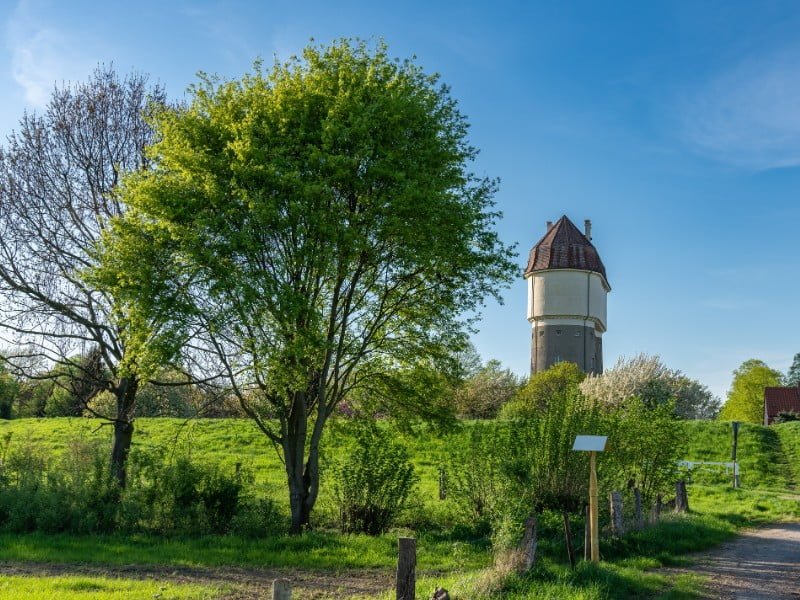
Duisburg Travel Guide: Final Thoughts
We’ve reached the end of our Duisburg journey. Who knew this under-the-radar city could pack such a punch? From its awe-inspiring industrial landmarks to serene parks, buzzing multicultural districts, and rich history, Duisburg has unfolded before us as a city of unexpected discoveries. Let’s take a moment to reflect on why this Ruhr gem deserves a spot on your travel list.
More Than Meets the Eye
Duisburg has a way of surprising you. It’s not just about the industrial might of the past; it’s about how the city has repurposed these giants into spaces of creativity and leisure. The Landschaftspark Duisburg-Nord is a testament to this transformation, blending history with modern recreational use in a way that’s uniquely Duisburg.
A Cultural Mosaic
The city’s cultural diversity is one of its greatest treasures. Walking through Duisburg, you’re as likely to hear Italian, Turkish, or Arabic as you are German. This melting pot of cultures is reflected in the vibrant food scene, lively festivals, and the warm, welcoming nature of its people.
Green Escapes
Duisburg’s green spaces are a breath of fresh air, offering tranquil retreats from urban life. The Six Lakes Plateau isn’t just a place for relaxation; it’s a reminder of the city’s commitment to balancing urban development with nature conservation. These pockets of greenery in and around the city are perfect for anyone looking to reconnect with nature.
Gateway to Adventure
Finally, Duisburg’s strategic location makes it an ideal starting point for exploring the wider Ruhr area and beyond. Whether you’re drawn to the historic charm of Cologne, the art and fashion of Düsseldorf, or the natural beauty of the Rhine Valley, Duisburg serves as your gateway to a richer, more diverse exploration of Germany.
As we wrap up our travel guide, remember: Duisburg is a city that rewards the curious and the adventurous. So, pack your bags, bring an open mind, and discover the multifaceted city that is Duisburg. Who knows? It might just surprise you.

Ode To Duisburg
In Duisburg’s heart, where history breathes, A city of contrasts, where past and present meet. From industrial might to cultural delights, Duisburg’s essence, a traveler’s treat.
Stroll along the Inner Harbor’s lively embrace, Where boats dance and the water’s grace. Museums await, with art’s vibrant hues, MKM’s contemporary marvels, an artistic fuse.
Landschaftspark Duisburg-Nord, a playground of the past, Industrial relics transformed, a landscape vast. Climb the blast furnace, witness panoramic sights, Nature and industry, harmonious delights.
Duisburg Zoo, where creatures roam, Exotic wonders, a captivating home. The Town Hall stands tall, a historic sight, Step inside, behold its grandeur and light.
Salvatorkirche’s Gothic charm, Stained glass windows, a heavenly arm. Dine by the harbor, flavors aplenty, Savor local cuisine, a culinary journey.
Duisburg’s rhythm pulses through the night, Königstraße alive, city lights shining bright. Theater Duisburg’s stage, where stories unfold, Culture’s embrace, a tale to behold.
As you bid farewell, memories in tow, Duisburg’s spirit, a traveler’s glow. A city of resilience, past and present entwined, Duisburg, a destination, forever enshrined.
- The Top 7 Things To...
The Top 7 Things to See and Do in Quedlinburg, Germany

Quedlinburg is the very picture that comes to your mind when you hear the words “quintessential medieval German town.” This UNESCO World Heritage Site, with its cobbled streets and 1,300 timber-framed houses, is agreed to be the best-preserved medieval town in the country. Read on to find out why you need to stop whatever you are doing and visit this Harz Mountain jewel right away.
UNESCO describes the Old Town of Quedlinburg an “extraordinary example of a medieval European town,” and it’s easy to see why. The unbelievably quaint Old Town is any wanderer’s dream. As you walk the narrow cobbled lanes and feast your eyes on around 1,300 impeccably preserved timbered houses from almost eight centuries, you are bound to feel yourself transported to another era.

1. Schloss Quedlinburg and Church of St. Servatius
Church, Museum
The stately Schloss Quedlinburg (Quedlinburg Castle) sits atop sandstone cliffs, looking down at the rows of beautifully preserved half-timbered houses below. Visitors are welcome to tour the beautiful rooms, and marvel at prehistoric artifacts in the castle museum. The sandstone, double-towered Church of St. Servatius in the castle complex is one of the most significant Romanesque buildings in Germany and preserves some of the oldest ecclesiastical treasures in the country.
Schloßberg 1, 06484 Quedlinburg, Germany , + 49 3946 905681

Schloss Quedlinburg | © rikkerst / Pixabay
Harzer Schmalspurbahnen (Harz Narrow Gauge Railway) connects the towns of Quedlinburg, Wernigerode, Nordhausen, and several others, and takes visitors on a nostalgic steam-train ride up to Brocken, the highest peak in the Harz Mountains . This is one of the most scenic train routes in Germany and is sure to be the highlight of your trip to the Harz.

2. Marktkirche St. Benedikti

The first mention of the Marketkirche (Market Church) St. Benedikti can be dated back to 1233, but it is deemed to be many decades older. It stands out because of its unique octagonal structure, two towers unmatched in height, and its Romanesque elements. The church houses tombstones, artworks, and a late-Gothic altar of St. Mary from the 15th century.
Marktstraße, Hoken, 06484 Quedlinburg, Germany , +49 3946 916060

Marktkirche St. Benedikti, Quedlinburg | © Hajotthu at the German-language Wikipedia
3. Fachwerkmuseum im Ständerbau
Fachwerkmuseum im Ständerbau is one of the most ancient half-timbered houses in the country and the very oldest among the 1,300 timber-framed houses in Quedlinburg. Its year of construction is pegged at 1310, and it served as a residential house till the year 1965. Today, it houses a small museum, which walks visitors through the history of half-timbered houses spanning four centuries and the evolution of the town of Quedlinburg. It is supposedly the only museum of its kind in the world. Wordgasse 3, 06484 Quedlinburg, Germany , +49 3946 3828

Fachwerkmuseum | © Jungpionier / Wikimedia Commons
4. Lyonel-Feininger-gallery
Lyonel-Feininger-gallery is a must-stop for art enthusiasts. It preserves the creations of Bauhaus artist Lyonel Feininger (1871-1956) in addition to related works, adding up to the only monographic museum exhibiting an unbeatable stock of print-making. Lyonel Feininger moved to America when his work was declared “degenerate” by the Nazis. The artist’s work was preserved and later donated to the museum by his close friend, Dr. Hermann Klumpp. Schloßberg 11, 06484 Quedlinburg, Germany , +49 3946 6895930
5. Klopstockhaus

Klopstockhaus is dedicated to the memory of Quedlinburg’s most famous son, the legendary early classicist poet Friedrich Gottlieb Klopstock (1724–1803), who was born in this quintessential half-timbered house built around 1560. The museum conserves the works of the gifted poet, along with documents and artifacts related to Dorothea Erxleben (Germany’s first female doctor), philanthropic pedagogue Johann Christoph Friedrich GutsMuths and Carl Ritter (founder of scientific geography).
Schloßberg 12, 06484 Quedlinburg, Germany , +49 3946 2610

Klopstockhaus | © Michael Mertens / Wikimedia Commons
Since you are here, we would like to share our vision for the future of travel - and the direction Culture Trip is moving in.
Culture Trip launched in 2011 with a simple yet passionate mission: to inspire people to go beyond their boundaries and experience what makes a place, its people and its culture special and meaningful — and this is still in our DNA today. We are proud that, for more than a decade, millions like you have trusted our award-winning recommendations by people who deeply understand what makes certain places and communities so special.
Increasingly we believe the world needs more meaningful, real-life connections between curious travellers keen to explore the world in a more responsible way. That is why we have intensively curated a collection of premium small-group trips as an invitation to meet and connect with new, like-minded people for once-in-a-lifetime experiences in three categories: Culture Trips, Rail Trips and Private Trips. Our Trips are suitable for both solo travelers, couples and friends who want to explore the world together.
Culture Trips are deeply immersive 5 to 16 days itineraries, that combine authentic local experiences, exciting activities and 4-5* accommodation to look forward to at the end of each day. Our Rail Trips are our most planet-friendly itineraries that invite you to take the scenic route, relax whilst getting under the skin of a destination. Our Private Trips are fully tailored itineraries, curated by our Travel Experts specifically for you, your friends or your family.
We know that many of you worry about the environmental impact of travel and are looking for ways of expanding horizons in ways that do minimal harm - and may even bring benefits. We are committed to go as far as possible in curating our trips with care for the planet. That is why all of our trips are flightless in destination, fully carbon offset - and we have ambitious plans to be net zero in the very near future.

See & Do
Stay curious: experience germany from your living room.

Places to Stay
The best spa hotels in baden-baden.

The Best Hotels to Book in Thuringia, Germany

Architecture
Breathtakingly beautiful buildings in germany.

A Voyage Through Germany: the Lowdown on River Cruising

Guides & Tips
The story behind germany's neuschwanstein castle.

Top Tips for Travelling in Germany

Craft and Culture in the Lesser-Known Gems of Eastern Germany

10 Reasons Why You Should Visit Bavaria

The Best Hotels in Germany for Every Traveller

The Best Hotels to Book in Garmisch for Every Traveller

Places in Germany for History Lovers
Culture trip spring sale, save up to $1,100 on our unique small-group trips limited spots..

- Post ID: 1863214
- Sponsored? No
- View Payload

Things To Do In Quedlinburg: Germany’s Medieval Treasure Town
Posted on Last updated: December 15, 2023
Categories Germany
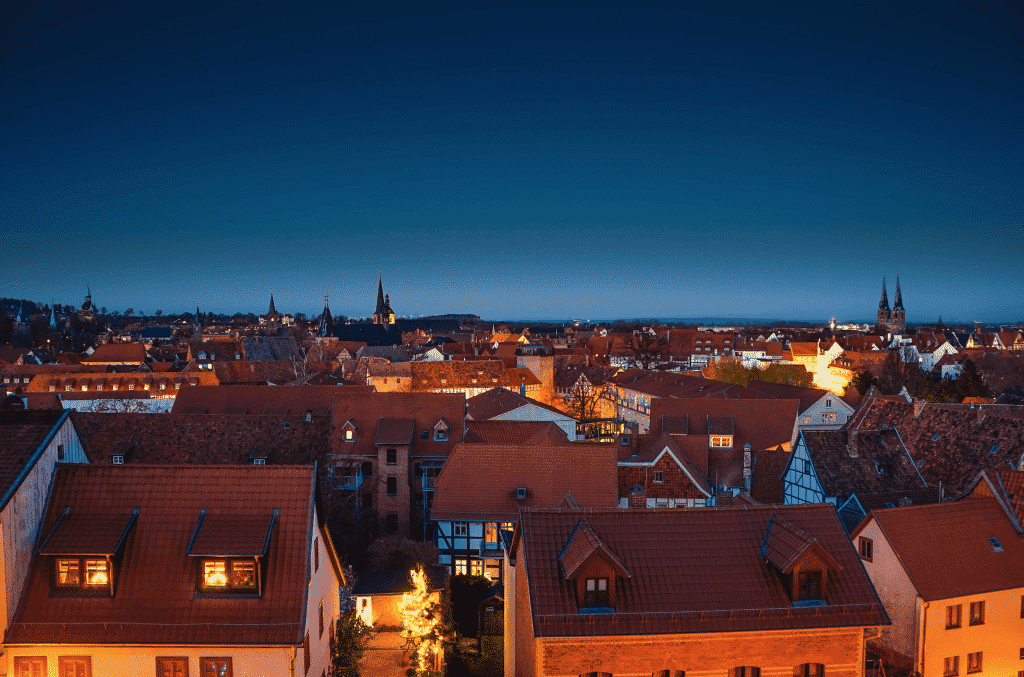
Expert travel storyteller Jordan Adkins, founder of InspiredByMaps.com, brings a decade of adventures across 101 countries and 450+ UNESCO sites into rich, off-the-beaten-path narratives, melding ecological expertise with genuine, seasoned travel insights. His full bio can be found here.
For those of you who don’t know – I have a little obsession with visiting UNESCO heritage sites. Not all of them I love, and not all of them are worth your time — but the Collegiate Church, Castle and Old Town of Quedlinburg, is absolutely 100% worth it!
In fact, it would be even if it were not a protected site – I mean, how often can you stroll through a 1,000-year-old town and see the seamless blending of past and future.
Well, you could also same the same if you visit Tallinn. Or Copenhagen. Or Prague. But was makes Quedlinburg unique is the quiet serenity. This isn’t a tourist destination that needs to brag. Quedlinburg knows how good it is!
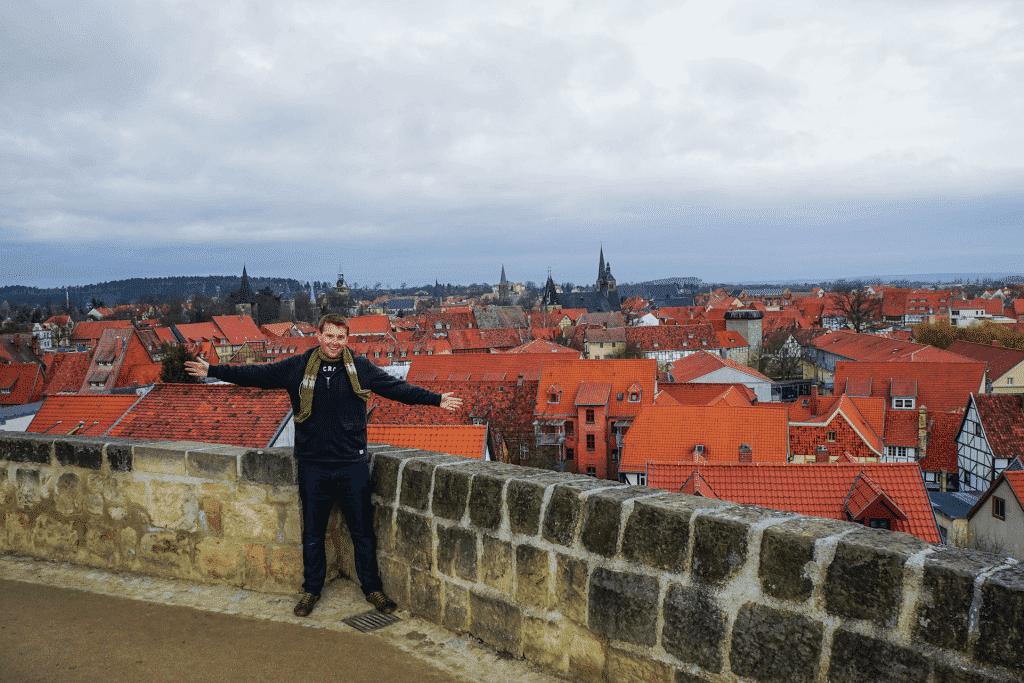
In particular, Quedlinburg is famed for it’s 1,300 Romanesque half-timbered houses and later Art Nouveau villas and, of course, the Quedlinburg Romantic Road leading to the Quedlinburg Renaissance Castle, the Collegiate Church of St. Servatius and the town’s cathedral housing the Quedlinburg treasure. No need to ask why the road has this name — though we would say the entire city is one of the most romantic places in the world!
All of this – and more – fuses to create one of the most beautiful medieval towns in Germany, deserving of its UNESCO World Heritage listing and a few days visit if you are traveling around Germany! As I said – It’s worth it, but in case you’re not convinced yet, here are a few things to do in Quedlinburg, Germany!
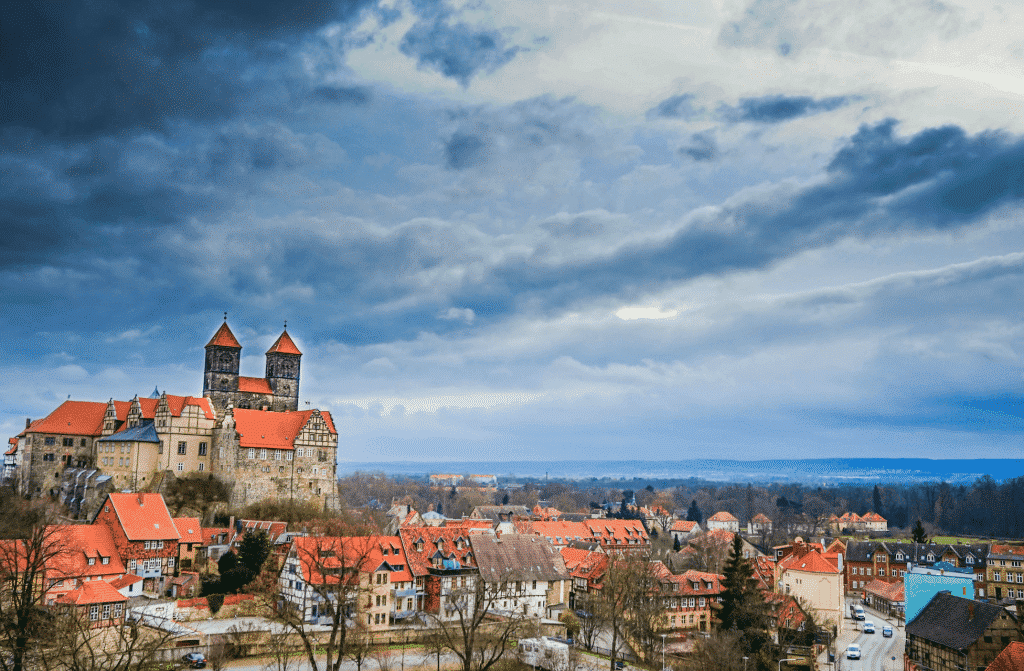
So if you’re like me, I bet you are wondering — what is Quedlinburg?
How do you even pronounce it??!
Well, Quedlinburg (pronounced Keed-lyn-berg) is an exceptionally preserved medieval European town filled with timber-framed buildings, churches, windy lane-ways, and a castle on a hill. Admittedly all reasonably standard for Europe , but the degree to which this has been preserved is astounding and like nowhere else.
You feel like you have been transported back to when the town was a prosperous trading town since the Middle Ages, especially at the Weihnachtsmärkte (Christmas markets), and that at any moment, a bard will break into a tale or the city bells will announce invaders. Hmmm well maybe not — but you get the idea!
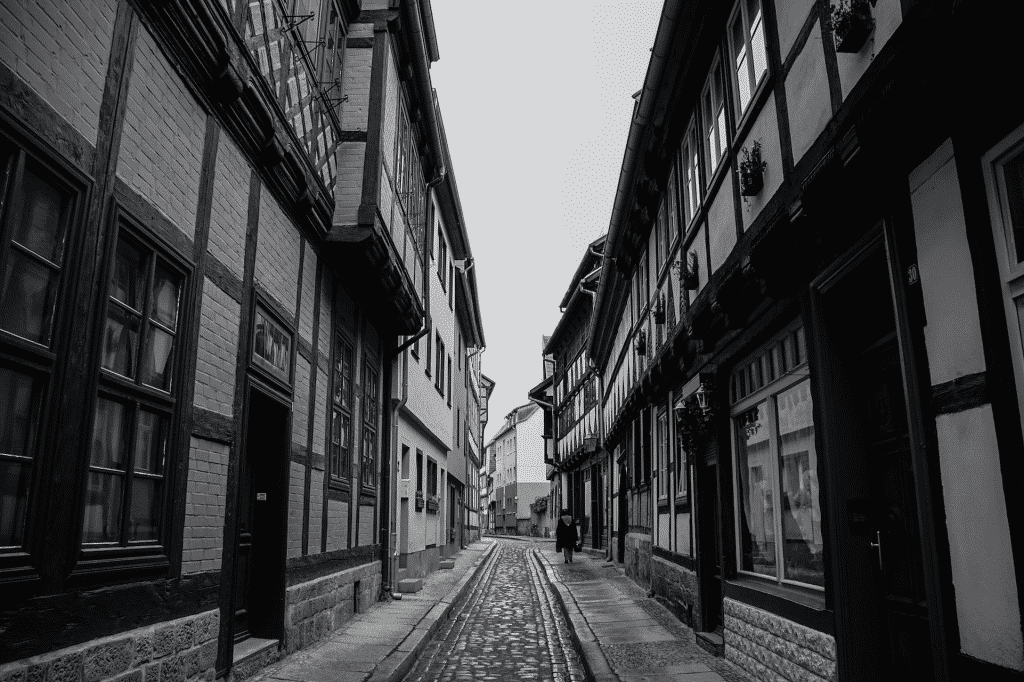
Quedlinburg can best be accessed by regional trains from Hanover or Berlin, but being located in the Harz mountains (and the relative seclusion is part of the allure), it does take about 4 hours each way.
I would recommend a one night, or two night stay as I did at the Hotel Garni Am Dippeplatz , a gorgeous 13th-century half-timbered house in the center of the old town, in one of the oldest streets of Quedlinburg (and one of the cheapest stays in city).
One of the highlights of my winter trip through Germany – especially as there are way more things to do in Quedlinburg than I ever expected.
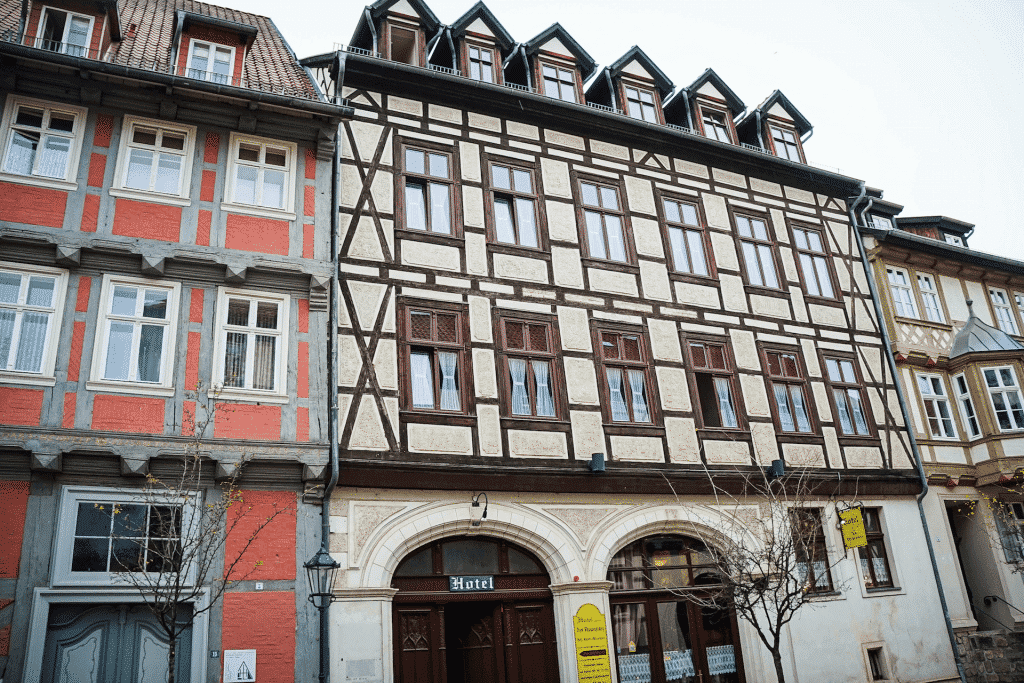
When you come here, you are instantly submerged in seven centuries of half-timbered architecture and more than a thousand years of German history and magic in this unique medieval town.
The castle-hill and the Münzenberg,” the Old Town and the historical New Town – There are so many significant sights here to draw you in. It is difficult to separate out such a rich and diverse collection of attractions, but I will make an attempt below to convince you of why this should be on the stop for the next Flixbus trip to Europe with just a few of the things to do in Quedlinburg Germany!
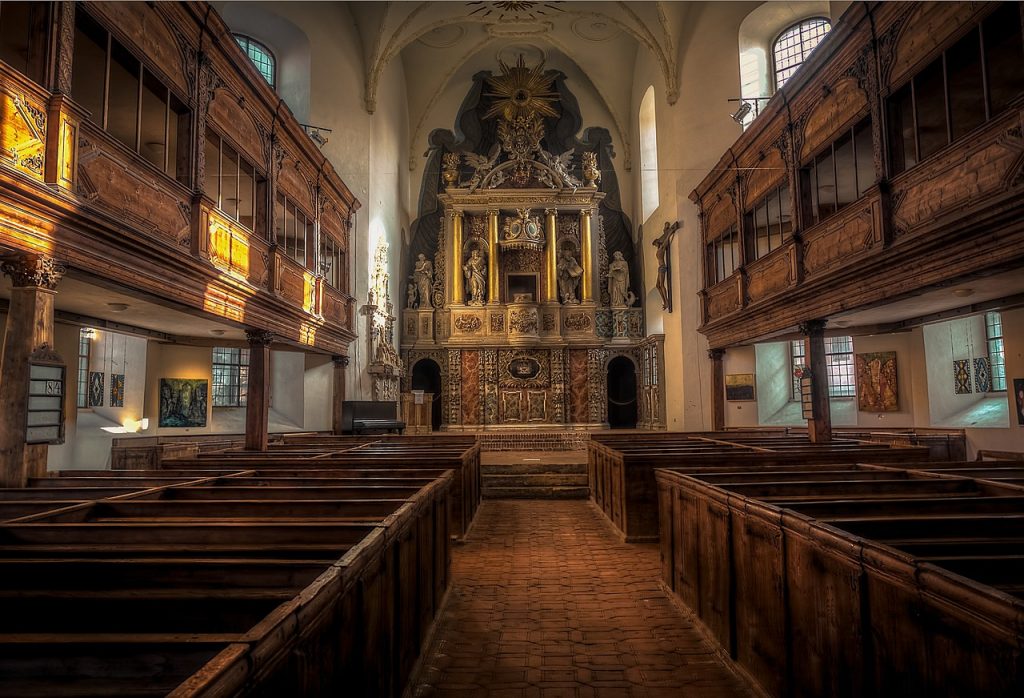
Things To Do In Quedlinburg: Germany’s Medieval Treasure Town 🇩🇪
The new town.
The Quedlinburg New Town uses the term rather loosely as, in fact, it started to develop around 1,200 AD, and the city spilled out over the walls of the old city. Remarkably different – the residential dwelling’s here consisted of large entry gates and even larger inner courtyards to accommodate crop storage space and livestock.
Some of the main must-see sights in Quedlinburg New Town are the St. Nikolai Church, The City Towers, and the New Town Churchyard – though, like most of the city, half the joy is simply in wandering aimlessly and discovering the beauty of Quedlinburg for yourself!
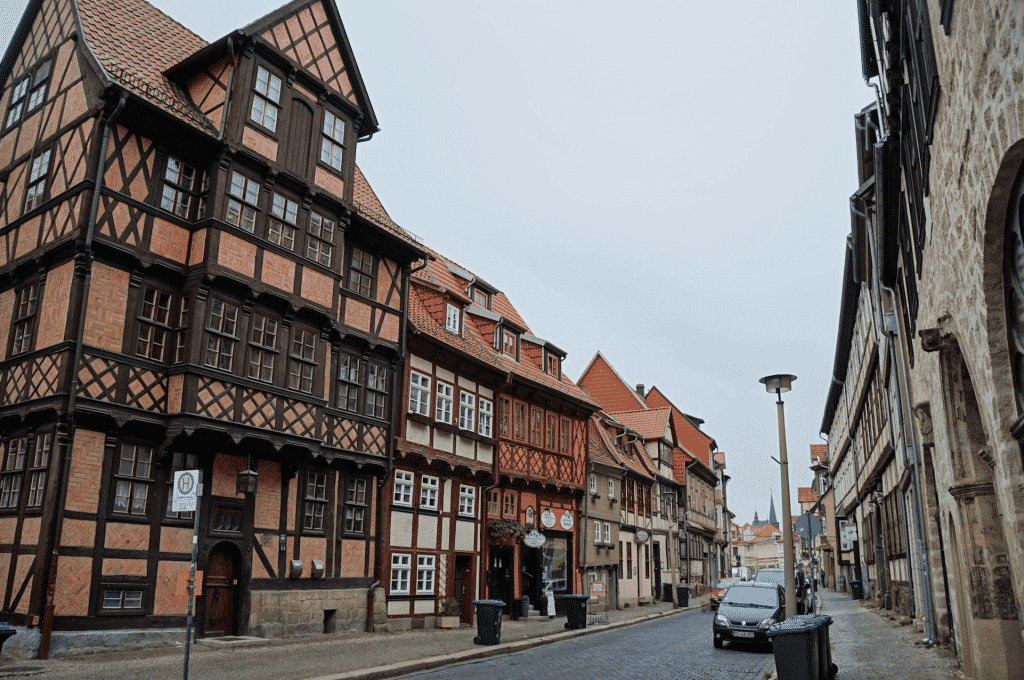
The Old Town
The Quedlinburg Old Town offers everything you need to create the most beautiful medieval town in Germany, and to be honest, at times it looks just like a movie set.
Get lost in long, unending cobblestone lanes, admire the timber buildings towering above you, get snap-happy with all the different architectural styles, and count just how many churches you can fit into one town.
Hint: it’s a lot!
The Castle-Hill
Towering over the historic town, the Castle-Hill is one of the blatantly obvious things to do in Quedlinburg, and yet it is easily one of the best! Besides offering the best view of Quedlinburg and some of the best photo opportunities, the thousand-year-old Romanesque collegiate church St. Servatius.
Towering high above the old town on a sandstone cliff, the collegiate church St. Servatius.just begs to be explored along with the famous collection of the Quedlinburg church treasures that have been housed within it’s protected vault for generations – and on display since 1993.
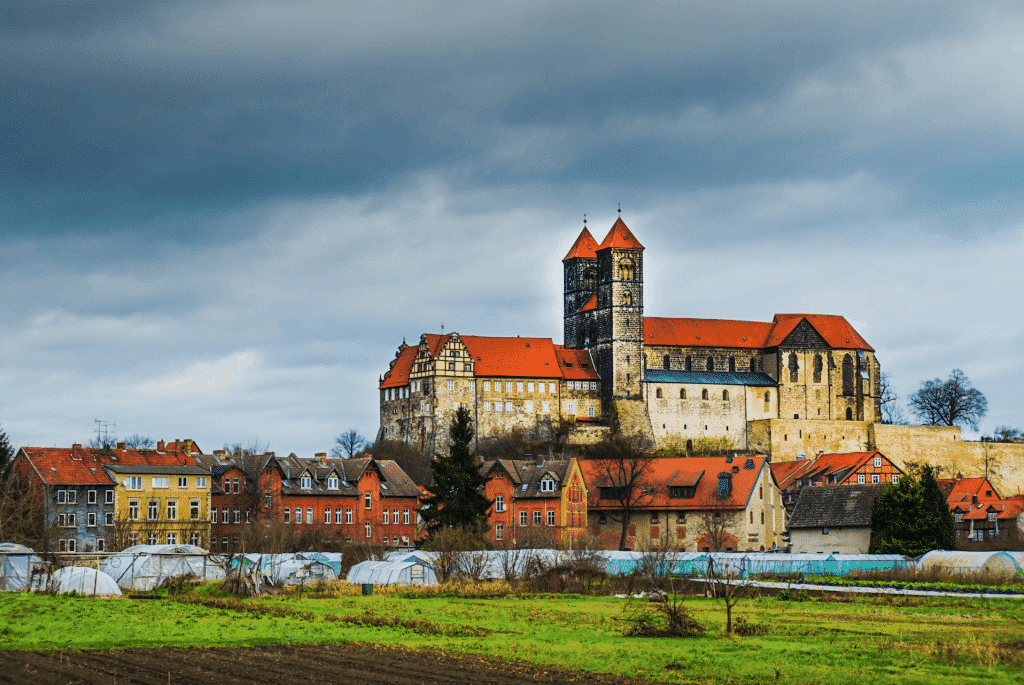
The “Münzenberg”
One of the top things to do in Quedlinburg is to visit the Münzenberg Museum, which housed the Convent of St. Mary (Marienkloster) until 1525 when an uprising of Peasants occurred, and the site was left to decay.
Reclaimed by various groups over the ages, which is left now, is a selection of rift-raft tiny half-timbered houses laid directly on the ruins, making it charming to explore and learn about the intriguing history of the Münzenberg.
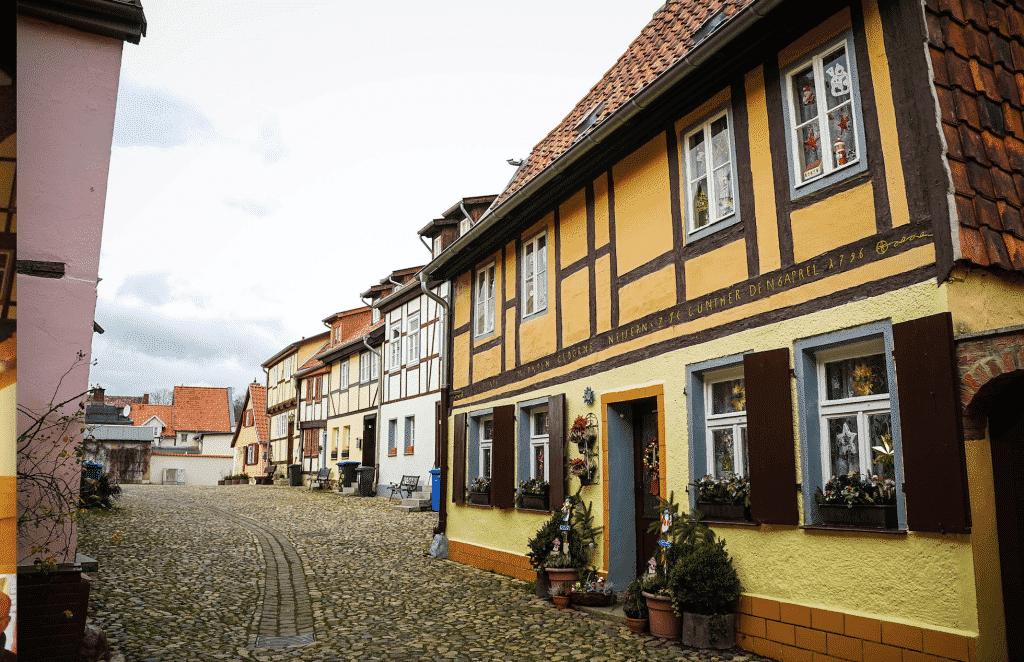
Half-timbered Architecture
The half-timbered buildings of Quedlinburg not only adds to the charm of the medieval town but also it’s uniqueness that led to Quedlinburg being inscribed on the UNESCO World Heritage Site.
Because of the uninterrupted progress on half-timbered architecture in Quedlinburg, it is possible to explore the history and to change construction styles over the ages just by wandering from street-to-street. With the oldest half-timbered houses in Germany, these iconic landmarks alone is a reason to visit Quedlinburg!

Advent City
If the seasons allow, then one of the top things to do in Quedlinburg Germany should be to visit the famous Q uedlinburg Christmas market in December.
During this time, the town is magically transformed into a Christmas dreamscape set around the historic town square and offer’s temptations for all the senses. Every public space seems to be alive and humming, and the timelessness of Quedlinburg really comes on display. Everybody seems to be out laughing, snacking on Pretzels, and drinking Glühwein.
Incomparable!
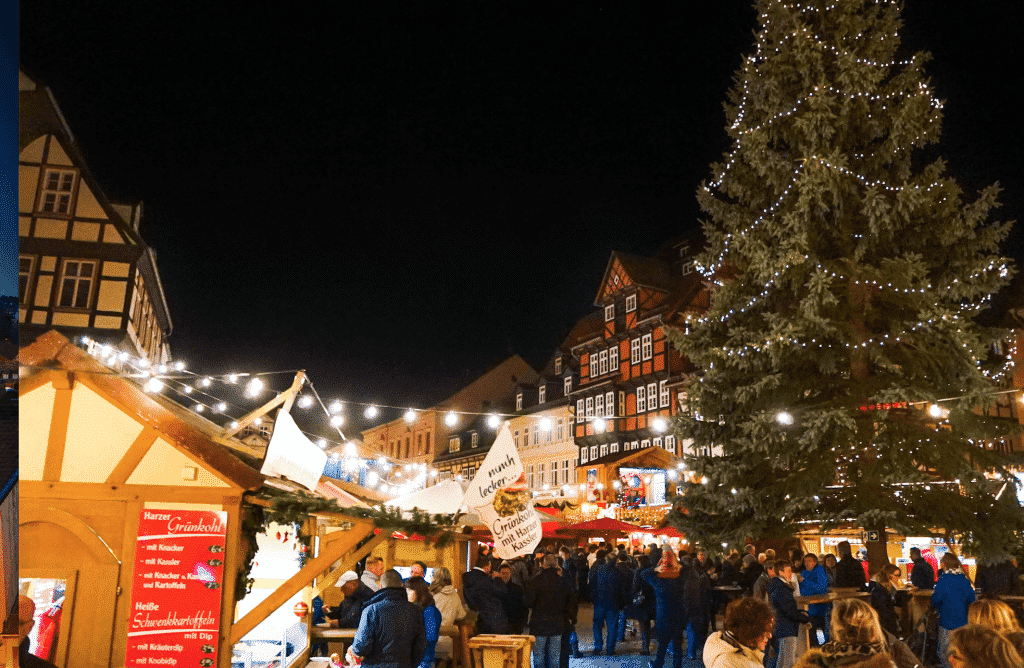
Ok — so the Quedlinburg Christmas market is only on in December but deserves mention as it still those on a winter get-away a reason all of their own to come! This city is so incredible and perfect; photos can only show so much – When you are here, it feels like you are on a movie set or a theme park.
It is unbelievable that people actually live and work here every day, but they do! Its a bit of a secret treasure at the moment though, mostly unknown outside of Germany, so be sure to add this to your hit list of European ‘must-dos’ on your next trip and live it up like a medieval king!
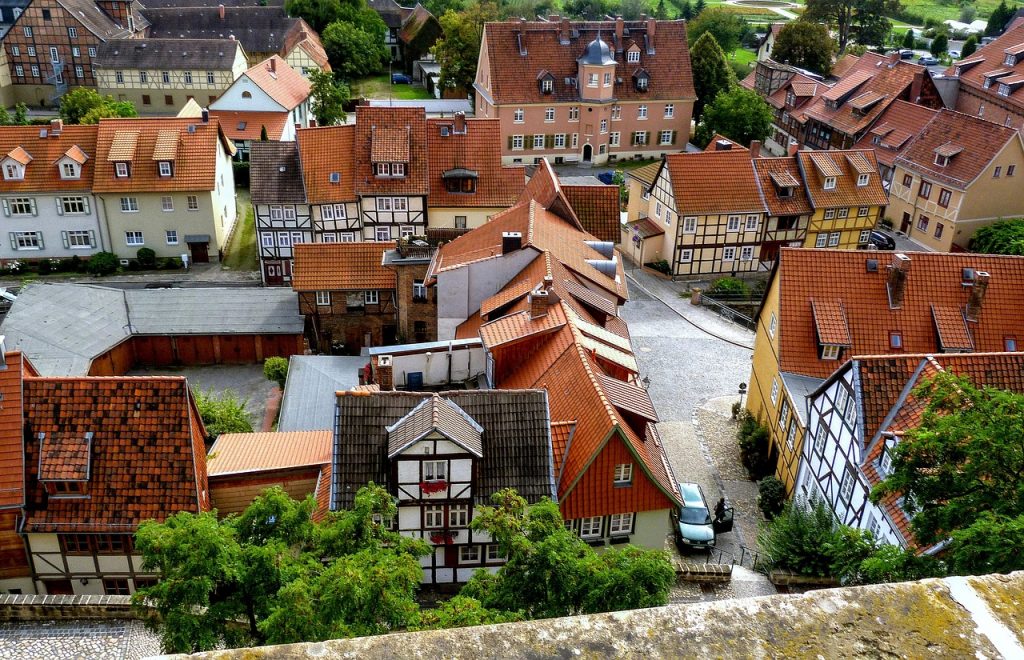
- Tuesday, April 23, 2024
- Shop Our Products

- Travel to Germany
What to See in Quedlinburg- A Step Back in Time
In 2018, I learned about a new award-winning board game called Die Quacksalber von Quedlinburg ( Quacks of Quedlinburg ), and I got curious… then I discovered Quedlinburg is a real place, I got excited! And the more I read about this city stuck in time, I knew that I had to go there. The German National Tourist Board agreed that this UNESCO city near the Harz Mountains in eastern Germany was worth a visit from us, and they set up a tour so that I could share Quedlinburg with all of you.

Quedlinburg
Quedlinburg holds the distinct title of “ most Fachwerk houses in one city ” . You will find over 2000 of these wood beamed buildings over 86 Hectacres (that’s 213 Acres to you Americans). Although the interiors have been modernized (electricity, plumbing) the exteriors of the buildings in the Altstadt are almost exactly as they were 200, 300, and even 500 years ago. It’s almost as if the city were trapped in Amber or cast under a magical spell like in Brigadoon. But don’t expect happy peasants to come along singing like in some old Heimat film… Quedlinburg is a living breathing city with schools, doctors, graphic design shops and driving academies. Only the appearances remained virtually unchanged through wars, and even Soviet occupation. Today, this town on the northern border of the Harz Mountains is the perfect place to see 1000 years of history in just a few square Kilometers without the feeling that you’ve stepped into a “Disneyfied” tourist zone.

Hotel Theophano
As easy as it is to aimlessly wander the city, I would suggest taking a walking tour . The city information office in the Altstadt (right across from the hotel) can set you up with a knowledgeable guide who will customize the tour to your interests. (Fair warning… there are other “guides” who may be cheaper, or who promise the moon, but they aren’t as well trained, and our guide was so upset to hear the nonsense that they told their clients). Not much of a walker? Hop on the Bimmelbahn! The cute little train takes you through the whole town… and is great for kids too.

The Bimmelbahn- For an Easy Ride up to Schloßburg
How did Quedlinburg Keep so many Fachwerk Houses?

Head out in any direction from the Marktplatz. Building after building, house after house, all in that traditional Fachwerk style. Sabine, our Tour Guide, gave me some interesting trivia… you can always tell if a Fachwerk house comes from Quedlinburg by looking at the ends of the beams, since many of them come to a 4 sided point. Most homes have dates carved into the beams across the door. And loads of them have beautiful carvings. But why did Quedlinburg KEEP all of these beautiful buildings? Why didn’t they get torn down or modernized?

Once upon a time Quedlinburg was a wealthy city. As part of the Hanseatic League, trade money flowed in to the town, and building boomed. Then, the city fell out of favor, and lost its status. Money dried up. Naturally, when cities and citizens are short of cash, they don’t rebuild, they fix or manage with the things they already have. No new money meant that the old houses were repaired and lived in, instead of torn down to make way for the new.

Quedlinburg suffered no bomb damage in WWI… and was out of the line of fire for WWII. Then when the war ended, the city lay behind the Iron Curtain. The thing is, Quedlinburg was a small city in East Germany that didn’t draw any real attention to itself. The USSR basically ignored it. And, like much of the East, without financial input, there was no way to change the buildings. The city stayed as it was.
Some Changes
Oddly, it wasn’t until the late 1980s that any of the old buildings were torn down. And then it was just one row of houses near the Marktkirchhof. Thanks to German thriftiness, any parts of those old Fachwerk Houses that were worth saving… beams, windows, doors, roof tiles, etc…. were put into a warehouse. These items were then GIVEN to anyone who was remodeling or fixing up a broken-down house. In this way, the past would be preserved, not tossed into the ash pile.
Wh at to See in Quedlinburg

Schuhof Quedlinburg
Walk down the Schuhhof . You’ll find the entrance near the Rathaus, a narrow passage (a tunnel really) that opens after 8 – 10 meters. This little Alley is what’s left of the Schumaker’s guild housing for widows and orphans. Today these tiny houses are homes or shops (I need to get back to spend time in the bookshop!). They lead to a wonderful restaurant Himmel und Holle. (If you can, eat in the back garden, it’s lovely).

Himmel und Holle
From the opposite end of the Marktplatz you can head up Blasiistraße then tuck down a side alley called Wordgasse to see the oldest Fachwerk House in Germany, built in the 1300s! Today it’s a Fachwerk Museum (and for just a few Euros, you can learn EVERYTHING there is to know about Fachwerk). The roundish white building with black vertical beams doesn’t have the “fancy” look that many of the city’s buildings do… but it holds hundreds of years of history.( As a Californian, I’m still trying to wrap my brain around that….)

The Oldest Fachwerk Building in Germany
Don’t miss the Schloßberg! Overlooking the whole city, the sandstone hill (or Castle Mountain) is home to St Servatii Church and the Renaissance Castle (now the Castle Museum). It’s an easy walk up the hill, and once you are there, the 360-degree phenomenal view allows you to see the whole city of Quedlinburg, and beyond to the Harz Mountains. (Naturally, there is a cafe, so you can catch your breath and recuperate with a drink after the short hike).

The ring of houses around the base of the hill are not hotels or vacation spots, these are homes lived in by locals. And during the Advent Season , the little neighborhood is extra special, it becomes a living Advent Calendar! Each home is assigned a number, and children can visit on the assigned day to get a treat or hear a story. There is a reason Quedlinburg is nicknamed the Advent City.

Looking down from the Schloßberg
Thousand Years of History
Look straight down… recently, terraced gardens ( little Schrebergarten ) were built around the base of the hill to strengthen the crumbling sandstone, and to provide green space for locals. Fruit trees planted on a few levels are a reminder that once the town was overseen by an Abbess, whose first responsibility was feeding the people. And that was my favorite story of all. For almost 900 hundred years, Quedlinburg was led by women as a “Kaiserlich freie weltliche Reichsstift Quedlinburg” or “Free secular Imperial Abbey of Quedlinburg” This meant that they answered to NO ONE except the Holy Roman Emperor.

The view from Münzenberg
This year Quedlinburg celebrates the 1000th Anniversary (YES 1000!) of King Heinrich 1 with a special exhibition in the church. Be sure to go inside. One ticket gets you into the Church and the Museum. Although the church itself isn’t “fancy”, inside you will find the grave sites of both Heinrich 1 and Queen Mathilde, as well many amazing treasures that were recently found again after they were lost after WWII , including, jewel encrusted reliquaries and ivory combs. The Castle Museum follows the timeline of Quedlinburg history, from the Stone Ages to the present. Back outside, you can enjoy a visit to the gardens; go ahead and relax on one of the many benches, or visit the café.

Why Go to Quedlinburg?

The Marktplatz by Night
Quacks of Quedlinburg
The game that put Quedlinburg on my radar! This fun “Push your Luck” game lets you make potions… but don’t let the pot explode!! Order your copy here

Large scale tourism still hasn’t arrived. My suggestion. Go to Quedlinburg. You still have a chance to see the beauty of this living Medieval City before the rest of the world catches on. Follow along on our tour…

5 thoughts on “ What to See in Quedlinburg- A Step Back in Time ”
oh man, that looks amazing! I’ll put it on my list!
Thanks for this beautiful article about the fascinating medieval town of Quedlinburg.
I really enjoyed my visit there. It’s such a gem
Thank you for showcasing a beautiful place and very familiar to me having relatives residing in the city and nearby. It is an accidental, pleasant discovery of your website presenting your viewers with interesting articles about Deutschland and reminding me of my cultural heritage since coming to Canada. I am sure you are very much appreciated by your readership.
Thank you! It made my day to hear this. I’m hoping to go back to Saxony next summer.
Leave a Reply Cancel reply
Your email address will not be published. Required fields are marked *
Related Posts
Friedensaal and the peace of westphalia – münster germany, travel accessories for a trip to germany- what i take along, seiffen church- history and a tour of the bergkirche seiffen, a visit to the black forest open air museum, vogtsbauernhof.
13 Charming Things to Do in Quedlinburg, Germany
- This article contains affiliate links. For every purchase made through one of these links, I receive a small commission, at no extra cost to you. Thank you! -

Nested in the Harz Mountains region, Quedlinburg is lovely town, characterized by over 1,300 unique half-timbered houses , making it by far one of the few most preserved medieval towns in Germany .
Surprisingly, Quedlinburg is one of the most underrated and off-the-beaten-path destinations in Germany. Especially considering the fact that it’s an old imperial city and UNESCO World Heritage Site .
I had the pleasure to visit Quedlinburg for a couple of days in August and I must admit, this was one of the most beautiful and peaceful places I have ever been to. If you’re looking for a not so popular German destination, or you’ve already decided to go on a trip to Quedlinburg, then this guide is perfect for you.
We will cover everything from how to get to, where to stay and what to do in Quedlinburg.
Table of Contents
How to get to Quedlinburg
Quedlinburg is located in the northern parts of Germany.
The nearest airport is Hanover International Airport, which is located approximately 57 km away. Another option is Berlin International Airport (216 km), from where you can make your way to Quedlinburg by car, train or bus.
Quedlinburg is also easily reached by regional trains from Hanover or Berlin . From Hanover the train takes approximately 3 hr 20 mins, and from Berlin – 4 hours.
You can also use the various bus services, which offer regular connections to Quedlinburg through many places in and outside of Germany.
As I was previously in Luxembourg , in order to get to Quedlinburg I had to take an overnight bus to Berlin. From here I took another Flixbus, which was a nice 3-hour-journey for approximately 20 euros.
Where to stay in Quedlinburg
During my 2 days in Quedlinburg I stayed at the Acron Hotel – it’s one of the most affordable hotels in town and it’s only about 5-10 minutes walking distance from the city center.
Things to do in Quedlinburg
Quedlinburg is quite a small city, but for it size it has a lot to offer. A full day may not even be enough to see absolutely everything and enjoy the ambience.
Here is a list of the top things to do and see in Quedlinburg, which should make your trip planning much easier and give you an overview of what you should expect from the city.
1. The Market Square
The best starting point when exploring Quedlinburg is undoubtedly the market square. The square is beautiful, to say the least – surrounded by numerous old half-timbered houses, some cafes and restaurants, as well as important buildings. This is where you will find the Tourist Information – get your city map from here and set yourself for the upcoming adventure!
2. The City Hall
Right at the market square you will also find the city hall, or so-called Rathaus. You just cannot miss this impressive building, made completely out of stone in the typical 13th-14th century Gothic style, with its facades coated by ivy.
There are a few things worth mentioning about the building. Above the door you can see the city’s coat of arms, which is also noticeable on the ground on the left side in the form of a mosaic.
Behind the mosaic there is a statue of a knight with a sword and shield, serving as a symbol of the town privileges of Quedlinburg.
3. Marktkirche St. Benedikti
The church dates back to the 12th century and it has still preserved some of its Romanesque look. It is possible to climb up the tower and enjoy a beautiful view from the top.
4. Church of St. Servatius

St. Servatius church serves as a monument to St. Dionysius and Servatius and it’s dedicated to the history of the High Romanesque architecture. After it was built between the 11th and 12th century, the church belonged to the Quedlinburg Ladies’ Foundation.
Since 1994 it is included in the UNESCO World Heritage List, together with the old town and the castle.
5. Schlossmuseum
The Schlossmuseum (or the Castle Museum) is located in Renaissance castle from the 16th/17th century, where you can experience and learn about a big part of the German history. The museum provides a great overview of the development of the region and the city, and visitors are able to see the oldest profane architecture the region of Saxony-Anhalt.
6. Munzenberg and Munzenbergmuseum

One of the top things to see in Quedlinburg is definitely the district called Munzenberg. Munzenberg is located on a hill above Quedlinburg and it is easily reached by foot in a matter of 10-15 minutes from the city. The view from the top is spectacular, so don’t forget to make a few quick stops along the way and take it all in.
The museum at Munzenberg is free to enter and it provides an overview of the history of the Münzenberg, where you can also see the preserved convent church – a beautiful Ottonian basilica.
7. St. Blasii Church

St. Blasii church was first mentioned in a document from the year 1222. However, the building probably dates back to the 10th century, remains of which can be seen in the present tower. This oldest version of the church was replaced in 1267 by a magnificent building that stood until 1711, after which it was transformed in Baroque style.
With the support of the German Foundation for Monument Protection, the church was extensively restored in the 1990s, after it had not been used since 1952 and the building structure had deteriorated considerably since then. Nowadays the church is mainly used as a cultural venue for book readings and concerts.
8. Klopstockmuseum

The Klopstockhaus is the birthplace of the poet Friedrich Gottlieb Klopstock, one of the founders of classic German literature. At that time his work was read more often than his contemporaries Goethe and Schiller. Today, the Klopstockhaus is turned into a literature museum which provides information about Klopstock’s life and work, but also about other important people from Quedlinburg.
9. St. Wiperti
St. Wiperti is a church dedicated to St. Wigbert and St. James. It is considered an architectural masterpiece of the Romanesque, and the church and the crypt testify to its important past as the royal court of the Saxon-Ottonian ruling dynasty.
The upper building served different purposes during the centuries – it was a male monastery until the Reformation and for some time it was even used as a barn, before its restoration after the Second World War.
10. Lyonel Feininger Galerie

The Lyonel Feininger Galerie is an art museum, which opened back in 1986. It shows works of the famous artist Lyonel Feininger, which had been preserved by the Quedlinburger Hermann Klumpp, a former classmate of his, before the destruction by the National Socialists. The collection of Feininger works in Quedlinburg is one of the largest closed collections of prints, etchings, lithographs and woodcuts of the artist and also the only Feininger Museum in Europe. It documents all his creative periods from 1906 to 1937.
11. St. Nikolai Church

St. Nikolai in Quedlinburg is the parish church of the new town in Quedlinburg. The church was first mentioned in a document in 1222, making it the oldest church in the Neustadt district.
It’s important to point out an important woman – the pastor’s wife Dorothea Christiane Erxleben, whose husband Johann Christian Erxleben was pastor of the church in the 18th century. She received her doctorate in 1754 at the University of Halle as the very first female German doctor.
12. Fachwerkmuseum Ständerbau
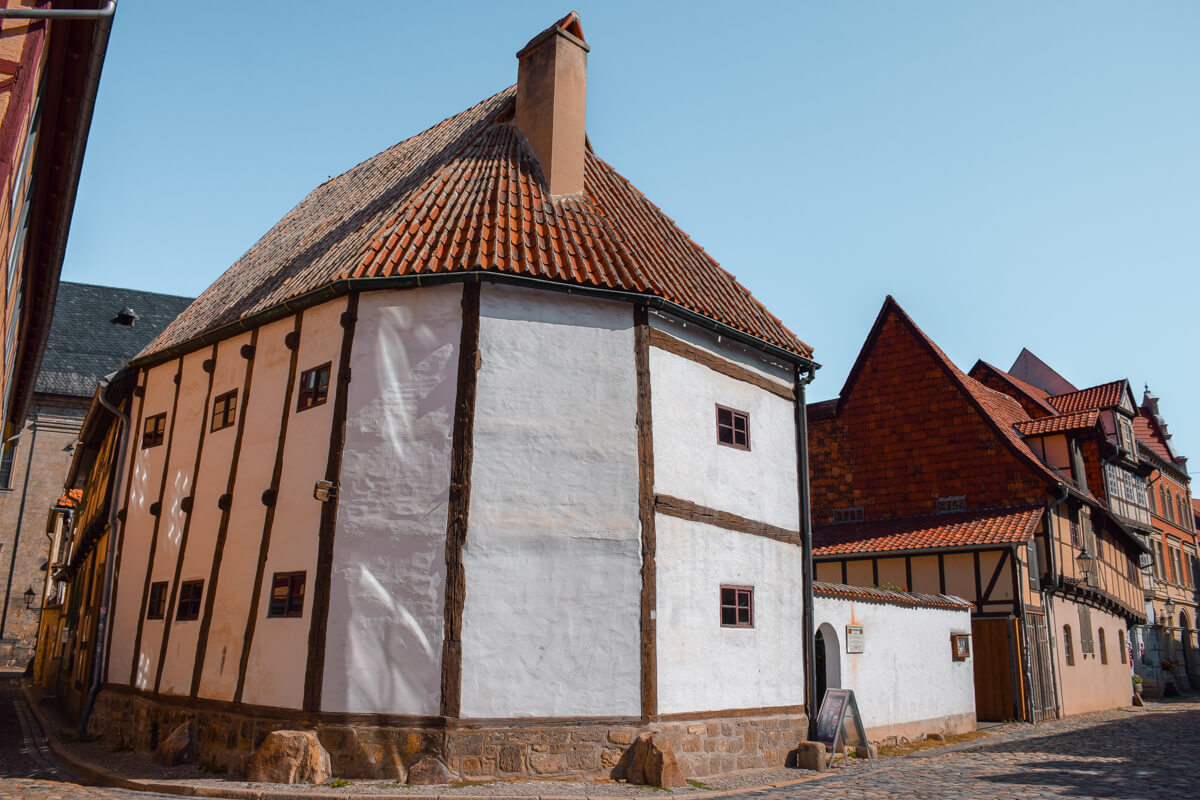
The Hochständerhaus is architecturally not the most beautiful, but probably the oldest half-timbered house in Quedlinburg. Investigations have found the construction period for the building to be around the year 1310. This makes it one of the oldest surviving half-timbered buildings in Germany. The house was inhabited until 1965.
Even though the construction has been changed and renewed throughout the centuries, technical studies have shown that about 65% of the framework is still original.
13. Park Brühl
If you want to experience the “green side” of Quedlinburg, then head to Park Brühl. The park is located south of the Schlossberg and it’s about 15 acres big.
The park is included in the Garden Dreams’ conservation – a list of 50 historical parks in the region of Sachsen-Anhalt.
14. Quedlinburg Christmas Market
One of the most magical times to visit Quedlinburg is undoubtedly during winter. In the month of December is when the main square comes to life and the Quedlinburg Christmas Market lights up the whole city. The market consists of numerous stalls from where visitors can buy delicious food, mulled wine or fruity punch, as well as some Christmas decorations and crafts.
The Christmas market in Quedlinburg usually begins at the end of November and ends at the end of December, just before Christmas. So if you are still in the process of creating your Quedlinburg itinerary, or just deciding when is the best time to visit Quedlinburg, I would strongly recommend considering the month of December.
You may also enjoy:
One Day in Luxembourg City: The perfect Luxembourg Itinerary
2 Days in Vienna – The Perfect Vienna Itinerary
11 Marvelous Things to do in Vienna in December – Winter in Vienna Guide
Where to Find the Best Schnitzel in Vienna – Tips + Prices!
Did you find this post useful? Save it for later!

Lyubomira is the creator and author behind Bulgarian On The Go. With a background in journalism and experience in the field of tourism and marketing, her mission is to show travellers many beautiful places they might have never thought of visiting or even knew existed.
Find me on: Instagram
I visited Quedlinburg just for a quick stopover in 2017 and am finally going back for a proper visit next month! This post has made me even more excited 🙂
Leave a Reply Cancel reply
Your email address will not be published. Required fields are marked *
Quedlinburg

- 1 Understand
- 2.1 By plane
- 2.2 By train
- 2.3 By road
- 3 Get around
- 4.1 Churches
- 4.2 Museums
- 4.3 Galleries
- 7.2 Mid-range
- 7.3 Splurge
- 9.2 Mid-range
- 9.3 Splurge

Quedlinburg is a town in the Harz Mountains , of Saxony-Anhalt , Germany . It is one of Europe's best preserved medieval renaissance towns. It features a rare combination of ancient and modern historical treasures. In 2020, it was home to 24,000 people.
Understand [ edit ]
Quedlinburg is on the northern boundary of the Harz Mountains National Park. It was once at the centre of the German Empire. In 1992 it was placed on the UNESCO World Heritage list . Almost all of the buildings in the town centre are timber framed, some dating back to the 16th century. It is a sight not to be missed, walking through the narrow alleys and streets around the town square and seeing all the colourful painted old houses. In the innermost parts of the town a wide selection of timber framed buildings from at least five different centuries are to be found, including a 14th-century structure, one of Germany's oldest. Fortunately Quedlinburg did not suffer too much damage during World War II, and preservation orders were put on a large number of these properties. If you wish to learn more about the timber framed buildings of the region, a trip to the Fachwerkmuseum Standebau in one of Germany's oldest half-timbered houses (1310) is a must.
A highlight of Quedlinburg is the castle (schlossberg) perched above the city, of which the centre piece is the restored baroque Blue Hall (blue Halle).
Get in [ edit ]
By plane [ edit ].
The nearest main airport is Hanover International Airport ( HAJ IATA ) (57 km). You could also use Berlin 's new airport ( BER IATA ) (216 km).
By train [ edit ]
Quedlinburg can best be accessed by regional trains from Hanover or Berlin. From Hanover the train will go via Halberstadt, taking approximately 3 hr 20 min. From Berlin you will go via Madgeburg, taking approximately 4 hr. There are other routes with differing changes, but these are the simplest.
By road [ edit ]
Quedlinburg is located on the B6n dual carriageway that runs along the northern edge of the Harz from west to east. The B6n branches off the A7 motorway near Goslar and the A395 motorway (branches off the A2) from Braunschweig to Vienenburg.
By bus [ edit ]
The local bus services offer various routes around the local area. Various long distance buses also serve the city.
Get around [ edit ]

- Surrounding area - Quedlingburg is an ideal point of departure to reach the nearby Harz, with dramatic gorges and mountainous landscapes waiting to be explored in a hiker's paradise. The 'Romanesque Road' recounts dynasties and events from German and European history up to a thousand years ago. Numerous Romanesque edifices in the immediate vicinity of Quedlinburg bear witness to this history.
- The Trans-Harz Railway Line: Crosses the Harz Mountains from north to south. On the 60-km track passengers are treated to a kaleidoscopic journey through nature.
- The Selke Valley Railway Line: Is the most romantic track of the whole narrow gauge network and has long been an open secret among nature lovers.
- The Brocken Railway Line: In July 1992 public rail service was resumed to the legendary Brocken. Climbing up there is a hard work for the 700 HP steam-powered locomotives.
- The Brocken trip uses carriages that have a feel of times gone by. There are wooden platforms between the carriages, which enable you to admire the views which are breathtaking, steep slopes, and twists and turns. The climb from Schierke, 685 m above sea level, to the Brocken, 1142 m above sea level, is hard and you can listen to the train puffing its way up. Once near the top, the fir trees gave way to the Brocken plateau. it can be very windy on top so do make sure you pack approriate clothing . The summit has the Brocken House, the Brocken Hotel and the TV tower as well as the Brocken-plateau, a great place to get your picture taken. There is a free viewing point on the 8th floor of the Brocken Hotel, which is all glassed in and commands excellent views. There is a restaurant on the 7th floor. The museum is in the Brocken House with exhibitions on four floors that cover witches, the use of the Brocken as a former military base and border post. There is a cafe on the 2nd floor and another viewing platform on the 3rd floor. Entrance is €4 for adults and €2 for kids (6-16). If you have the time, than the walk down is possible and well sign posted. For further information go to www.hsb-wr.de .
See [ edit ]

Relatively untouched by World War II, the old town and the castle mount and collegiate church in Quedlinburg are listed on UNESCO's register of World Heritage Sites, and the town is one of Germany's best-preserved medieval and Renaissance towns. The town's medieval buildings are worth a visit: its half-timbered buildings represent at least five different centuries (including one of Germany's oldest, from the 14th century). Around the edges of the old town are late 19th- and 20th-century examples of Jugendstil buildings.
The Harzer Schmalspurbahnen Selketal branch of the historic steam narrow gauge railway was extended into Quedlinburg from Gernrode in 2006, giving access to Alexisbad and the high Harz plateau.
Churches [ edit ]
- Stiftskirche St Servatii und Domschatz ( The Collegiate Church and its Treasure ), Schlossberg 1 , ☏ +49 3946 709000 . Apr - Oct: Tu-Sa 10:00 - 17:30, Su & holidays 12:00 - 17:30; Nov - Mar: Tu-Sa 10:00 - 15:30, Su & holidays 12:00 - 15:30; closed 24-25 Dec & 1 Jan . This is an excellent example of the German Romanesque style. The Domschatz (the treasury), inside the church, containing many ancient artefacts and books, many of which are on display.
Museums [ edit ]
- Schloss Museum , Schlossberg 1 , ☏ +49 3946 905681 . Apr - Oct: Tu-Su 10:00 - 18:00; Nov - Mar: Tu-Su 10:00 - 16:00, closed: 24, 25, 31 Dec & 1 Jan .
- Klopstock Museum , Schlossberg 12 , ☏ +49 3946 2610 . W-M 10:00 - 17:00, closed: 25, 25, 31 Dec & 1 Jan .
- Fachwerk Museum Standerbau ( Half Timbered Architecture Museum ), Wordgasse 3 , ☏ +49 3946 3828 . Apr - Oct: F-W 10:00 - 17:00; Nov - Mar: F- W 10:00 - 16:00; closed: 24, 25, 31 Dec & 1 Jan .
- Museum fur Glasmalerei und Kunsthandwerk ( Museum of Glass Painting and Handcraft ), Word 28 , ☏ +49 3946 810653 . Tu-F 10:00 - 18:00; Sa Su 11:00 - 16:00; closed M .
- Mitteldeutsches Eisenbahn-und Spielzeug-Museum ( Central German Model-Train and Toy Museum ), Blasiistraße 22 , ☏ +49 3946 3751 . Apr-Oct & Dec: daily 10:00-17:00; Nov Jan-Mar: M-Sa 10:00-16:00, Su holidays 11:00-16:00 .
- Munzenberg Museum ( The Mariencloister ), Munzenberg 16 . M-W F 10:00-12:00, 14:00 - 17:00; Sa Su holidays 09:00-12:00, 14:00 - 17:00; Th closed .
Galleries [ edit ]
- Lyonel-Feininger Galerie , Finkenherd 5a , ☏ +49 3946 6895930 . Apr - Oct: Tu-Su 10:00 - 18:00; Nov - Mar: Tu-Su 10:00 - 17:00 . A trip to the Lyonel-Feininger Galerie is recommended where the works of this important Bauhaus artist who was born in Germany but became an American citizen are displayed. Most of the works were hidden from the Nazis by a resident of Quedlinburg.
Do [ edit ]
- Guided Tours of the City . Tours in German: All year round tours at 14:00 (Apr - Oct additional tours at 10:00); tours in English: Available upon request in advance to Quedlinburg Information Center. ; Individual City Guides: Audio guides available in English and Japanese from the Quedlinburg information Center
- NordHarzer Stadtebundtheater ( Quedlinburg Theatre ). Drama, ballet, musical theatre and concerts
Events [ edit ]
- Spring Awakening - held around the Castle Hill the weekend before Easter.
- Kaiserfruhling (Spring Assembly of the Emperor) - an Ottonian Medieval Spectacle held at Pentecost.
- Summer Music - held at Stiftskirche St Servatii from Jun - Sep.
- Dixieland and Swing Weekend - held in Jun.
- Enchantment of the trees - held in Jun at the Romantic Park, Bruhl.
- Plants and Monuments - held in Sep.
- ProVinz Arts Festival - held in Sep/Oct.
- Christmas Market - held throughout Dec for 4 weeks.
- Stars around the Castle - held 1st weekend of Advent.
- Advent in the Courtyards - held 2nd & 3rd weekend of Advent.
- The Magic of Christmas Exhibition
Buy [ edit ]
There are no big shopping centres in the immediate vicinity of Quedlinburg. Instead they pride themselves on the numerous little curio shops selling everything from arts and handicraft, to antique shops, offering a wide choice of objects to suit every taste. Visitors looking for attractive articles, small gifts and unique home accessories will be able to discover what they are looking for in Quedlinburg. Many of these shops are housed in beautiful medieval properties, dotted all over the city centre. Alongside this historical ambience, there are any number of new shops too with items representing the latest in modern shopping tastes.
Eat [ edit ]
Budget [ edit ].
- Muenzenberger Klause , Polle 22 , ☏ +49 3946 2928 . Tavern style, very relaxed with a beautiful summer terrace to enjoy in the warm weather. €10-16 .
- Schlosshotel Zum Markgrafen , Weingartenstraße 30 , ☏ +49 3946 81140 . International cuisine, including a good selection of vegetarian food. The hotel has its own parking and when the weather is fine, you can enjoy the terrace and garden. €10-19 .
- 51.789116 11.141311 1 Bistrorant im Hotel Theophano , Markt 13/14 , ☏ +49 3946 96300 , [email protected] . 12:00-14:30 and 18:00-21:30 . Italian and local cuisine, with seasonal specialties. Parking, beer garden, non-smoking area, dogs allowed. Reviews suggest service is below par when very full. €14-19 . ( updated Jul 2017 )
- Kartoffelhaus No1 , Breite str 37 . International cuisine: a rustic, warm atmosphere, with a lovely beer garden and seating outside the front which overlooks a beautiful quiet street. €5-10 .
- 51.789116 11.141311 2 Wispel Pub , Steinweg 81 , ☏ +49 3946 702254 . 11:00 - 01:00 . Advertises "Essenpreise wie in den 80er Jahren" ("food prices like in the 1980s") and lives up to the promise. Non-touristy Ostalgie, which does however mean that the interior is rather smoky and that a lot of the food comes out of cans. ( updated Jul 2017 )
Mid-range [ edit ]
- Prinz Heinrich , Polle 29 , ☏ +49 3946 3707 . Bistro style. Decor from the turn of the century. Very cosy. Unfortunately they do not take credit cards. €12-20 .
- Himmel & Holle , Holle 5 , ☏ +49 3946 974 210 . German cuisine: delicious food in a beautiful setting. The antipasta is highly recommended, but many other dishes to choose from. The restaurant cover two floors and outside. €15-22 .
- Perlis Pasta Mia , Steinbruecke 23 , ☏ +49 3946 2122 . Italian cuisine. Bright and clean corner restaurant, just off the old market square. Warm welcome to all and accommodating with languages. €12-20 .
- Kasekuchenbackerei Vincent , Schlossberg 13 , ☏ +49 3946 81 . Cafe, bakery: beautiful cheesecakes, slightly pricey but the large portions make up for this. €15-24 .
Splurge [ edit ]
- Pension St. Nikolai , Polkenstraße 22 , ☏ +49 3946 528093 . Steakhouse: there are not many steakhouses in Germany, but this is one of the better ones. succulent steaks, cooked to your tastes, highly recommended. €18-28 .
- Weinstube im Hotel am Bruhl , Billungstraße 11 , ☏ +49 3946 961 80 . German cuisine. Clean, spacious, a la carte restaurant. €18-25 .
- Restaurant Benedikt , Marktkirchhof 18 , ☏ +49 3946 526652 . Traditional German cuisine presented in a modern style. Beautiful setting behind a church. €20-35 .
- Brauhaus Ludde , ☏ +49 3946 901481 . Located between the market place and the castle. It is set in the heart of the medieval city centre. Traditional German cuisine, next to a working brewery. €20-30 .
Drink [ edit ]
Interspersed among all the numerous shops and boutiques are any number of small cafes and bars. Many of these in the summer, spill out onto the cobbled streets, allowing their customers the opportunity to soak up the amazing historical atmosphere and watch the world go by. In contrast there are also modern bars to cater for the younger members of the Quedlinburg society.
- Bier-Pub Nase , Carl-Ritter-Str 18 , ☏ +49 3946 514255 . Irish pub
- Brauhaus Ludde , Blastiistr 14 , ☏ +49 3946 705206 . Beer house, restaurant and bar combined
Sleep [ edit ]
- [formerly dead link] Gaestehaus Toepke , Weststraße 13 , ☏ +49 3946 708166 . In the town centre. from €35 .
- Hotel Pension Weingart , Friedrich Jahnstr 27 , ☏ +49 3946 8617 . This family-run guest house is in a quiet part of town, a 15-minute walk from Quedlinburg town centre. It offers large country-style rooms and apartments. On-site parking is free. from €35 .
- Hotel Garni Am Dippeplatz , Breite Str 16 , ☏ +49 3946 77140 . The Am Dippelplatz is a beautiful half-timbered building, in the centre of the Old Town and in one of the oldest streets of Quedlinburg, which leads directly to the lively market square. Many sights, restaurants and cafès are in walking distance. from €35 .
- Quedlinburgerhof Hotel , Harzweg 1 , ☏ +49 3946 77870 . This family-run hotel offers 31 rooms with 3-star comfort, a conference and banqueting room for 60 people, an elevator plus wireless internet access in the whole house. from €39 .
- Hotel Domschatz , Muhlenstr 20 , ☏ +49 3946 705270 . This 3-star hotel occupies an over 200-year-old, timber-framed house at the foot of the Burgberg hill in Quedlinburg. It offers free Wi-Fi, free parking and free, large breakfast buffets. from €45 .
- Kunsthaus , Blasiistr 16 , ☏ +49 3946 528662 . The Kunsthaus offers spacious rooms and free Wi-Fi internet access within a historic Baroque building. It is located in Quedlinburg’s Old Town, 300 m from the Medieval Quedlingburg Abbey. from €40 .
- Schlosshotel Zum Markgrafen , Wallstraße 96 / Weingarten 30 , ☏ +49 3946 81140 . This traditional 250-year-old family-style hotel is picturesquely integrated into the old Market Square with an attention to detail, and a unique charm blend with clever new ideas and developments. from €105 .
- Hotel Schlossmuehle , Kaiser Otto Straße 28 , ☏ +49 3946 7870 . This hotel offers stylish in a quiet location near the center of the historic city of Quedlinburg in the Harz Mountains. From €75 .
- [dead link] Hotel Dorothea Christiane Erxleben , Steinweg 51 , ☏ +49 3946 770214 . A small cosy and very nice hotel in the centre of the old town. The historic ambience and the modern furnished rooms make a great combination and give this 300-year-old building a beautiful atmosphere, where you can relax and feel comfortable. from €70 .
- Hotel Zum Bar , Markt 8/9 , ☏ +49 3946 7770 . Set in a peaceful location in historic and picturesque Quedlinburg, this romantic castle hotel offers elegant 4-star superior accommodation just a short stroll from the old town centre. from €50 .
Connect [ edit ]
For further information on Quedlinburg go to www.thisisharz.com/quedlinburg
Go next [ edit ]
Quedlinburg is on the edge of the Harz Mountains, with its dramatic gorges and mountainous landscapes, waiting to be explored by hikers and bikers alike. The 'Romanesque Road' [dead link] recounts dynasties and events from German and European history going back over a thousand years. Many Romanesque edificies can be found in the immediate vicinity of Quedlinburg, which bear witness to this history.
- Harzer Schmalspurbahn – A narrow gauge tourist railway runs from Quedlinburg through the Selke Valley (parallel with the River Selke), to the top of the Brocken, the highest peak in the Harz Mountains.
- Thale Hexentanzplatz (Witches Dance Floor)is reputedly an Old Saxon cult site, at which, celebrations were held in honour of the so-called Hagedisen (forest and mountain goddesses), particularly on the night of 1 May. The place did not become known as the Hexentanzplatz until the cult was banned by the invading Christian Franks. According to tradition the site was guarded by Frankish soldiers in order to enforce the ban and they were chased off by Saxons dressed as witches and riding on broomsticks. On this plateau is the Thale Mountain Theatre (Bergtheater Thale), one of the oldest open-air theatres in Germany with 1,350 seats, which was founded in 1903 by Ernst Wachler. A gondola lift runs from Thale up to the Hexentanzplatz, where today, the plateau resembles a small Theme Park aimed at families. It includes various rides, small gift and craft shops and a Wildlife Park, illustrating the wide variety of different species of animal who can be found in the Harz region. While there are relatively unspoiled forests nearby with plenty of hiking trails, the immediate area of the Hexentanzplatz has become fairly commercialized.
- Bode Valley lies below the Hexentanplatz. This trail follows the Bode River deep into the Bode Valley gorge. Take in the spectacular scenery and rich flora as the stream tumbles over granite boulders. The walk starts next to Thale gondola station, where the path follows the river, taking you through dense forest and then into open meadows filled with wildflowers, ending in the village of Treseburg near a ruined castle. The walk along the Bode Valley takes about three hours (covering about 10 km), and is mostly gentle, with one short, somewhat steep climb that takes you to a great vantage point above the river. You can take the bus from Treseburg back to Thale. From the same starting point, you can also branch off this trail and hike up to the Hexentanzplatz or the Rosstrappe, the two rocky outcrops that surround the opening of the Bode Valley (shorter but much steeper routes).
- Halberstadt
- UNESCO World Heritage Sites
- UNESCO tag to be fixed
- Has custom banner
- Has map markers
- Has mapframe
- See listing with no coordinates
- Do listing with no coordinates
- Eat listing with no coordinates
- Drink listing with no coordinates
- Sleep listing with no coordinates
- Articles with formerly dead external links
- Articles with dead external links
- Has Geo parameter
- Saxony-Anhalt
- All destination articles
- Usable cities
- Usable articles
- City articles
- Pages with maps
Navigation menu
You are using an outdated browser. Upgrade your browser today or install Google Chrome Frame to better experience this site.

Guided Tours for Groups
For groups we have put together individual guided tours on a wide range of topics . Your advantage : Book the tour at the time that suits yo u b est .
read more guided-tours-for-groups
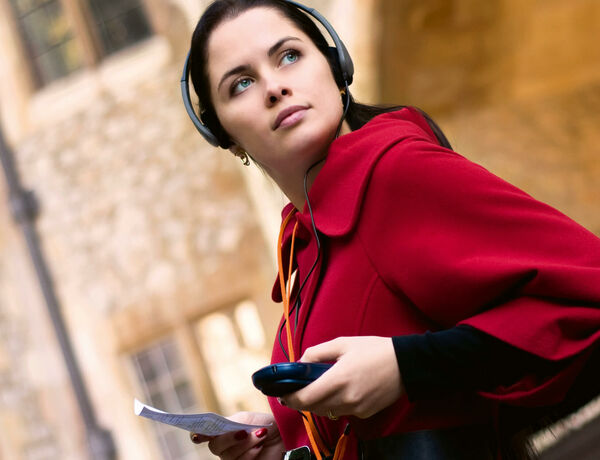
Audio-Guide
Do yo u want to explore the World Heritage City on your own, regardless of appointments and meeting points ? Then our audio guide is just right for yo u. A total of 20 listening stations – from the old town to the new town , from the castle to the Münzenberg and even from the Brühl to the Wipertikirche – offer an overview of everything worth knowing .
read more audio-guide-979
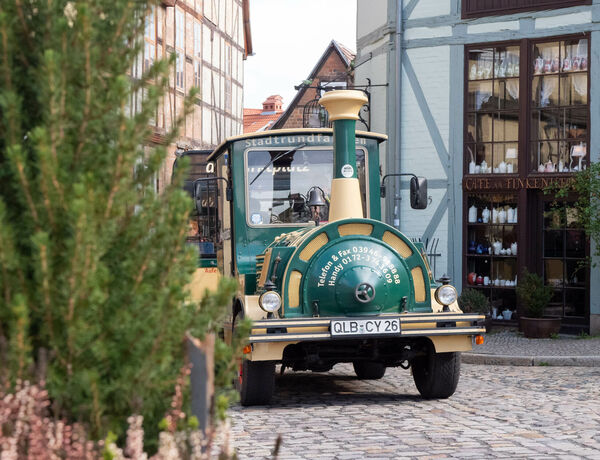
Tour with the Quedlinburger Bimmelbahn
Discover Quedlinburg on a 45-minute city tour with the Bimmelbahn . It is a relaxed way to get an overview and first impressions of the city .
read more a-circular-tour-with-the-quedlinburger-bimmelbahn
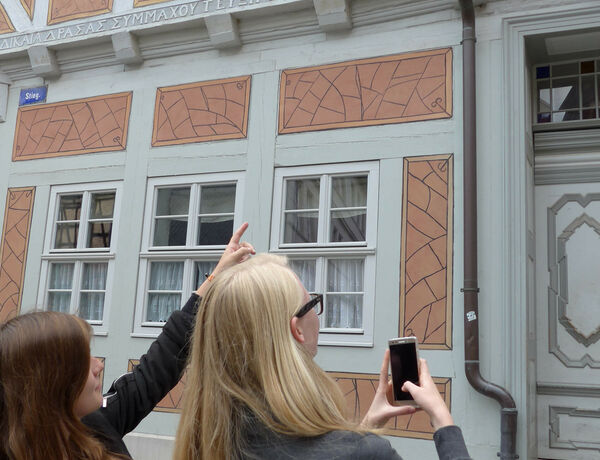
Discover Latin House Inscriptions
Unobtrusive , b ut still present , are Latin inscriptions on the Quedlinburg half-timbered structure . Like their German-language counterpart , they give readers a glimpse into the life of the former bu ilders . They present the wisdom of life , tell of gratitude and reverence to God , or ask for the b lessing of the house .
read more exploring-latin-house-inscriptions
- Accommodation
- Guided Tours
- Group Offers
- Short Trips
- 360° Panorama
- Leisure Time
- Hiking & Biking
- Surroundings
- Bad Suderode
- Tourist Information
- Travel Brochures
- Arrival & Transport
- Tourist Tax

IMAGES
VIDEO
COMMENTS
Things to Do in Quedlinburg, Germany: See Tripadvisor's 9,744 traveler reviews and photos of Quedlinburg tourist attractions. Find what to do today, this weekend, or in April. We have reviews of the best places to see in Quedlinburg. Visit top-rated & must-see attractions.
The local tourist office refers to the church as the Kulturkirche St Blasii - it is now mainly used to host cultural events, including concerts, poetry readings and exhibitions. ... (The Bear Hotel), a wonderfully friendly traditional hotel with many Quedlinburg attractions just a couple of minutes' walk away. Across the Markt, the Hotel ...
If you only have one day to visit Quedlinburg tourist attractions, find our one day Quedlinburg places to visit itinerary below. Note that I sort these things to do in Quedlinburg Germany based on geographical location starting with the central Old Town and Marktplatz and then listing the closest Quedlinburg Germany things to do while working ...
Let's explore the best things to do in Quedlinburg: 1. Stiftskirche St. Servatius. Source: Shutterstock. Stiftskirche St. Servatius. A monumental sandstone construction on the Schlossberg, this Lombard Romanesque church is a three-aisled basilica consecrated in 1129.
Top Things to Do in Quedlinburg, Germany: See Tripadvisor's 9,739 traveller reviews and photos of Quedlinburg tourist attractions. Find what to do today, this weekend, or in April. We have reviews of the best places to see in Quedlinburg. Visit top-rated & must-see attractions.
Things to Do in Quedlinburg, Germany: See Tripadvisor's 9,739 traveller reviews and photos of Quedlinburg tourist attractions. Find what to do today, this weekend, or in April. We have reviews of the best places to see in Quedlinburg. Visit top-rated & must-see attractions.
Closed for renovations. One of the best free things to do in Quedlinburg is admire this view from above. 13. Collegiate Church of St. Servatii (Stiftskirche im St Servatius) The Collegiate Church of St. Servatii in Quedlinburg, a UNESCO World Heritage site, has a history dating back to King Henry I in the 10th century.
The town hall in Quedlingburg is quite simple yet imposing and picturesque at the same time. 5. Sternkiekerturm. 20. Points of Interest & Landmarks. By mountainlover830. You enter at a stone gate to the Schloss Holte, 93 Walstrasse, go about 100m and the entrance to the tower is on your... 6. Marktkirche St. Benedikti.
The tourist information provide good information and brochures on sights in and around Quedlinburg. Friendly and helpful staff. ... Quedlinburg Attractions Information. Attractions: 51: Attraction Reviews: 2,016: Attraction Photos: 2,117: Local Time: Saturday 12:16 pm $ SGD. Singapore
Things to Do in Quedlinburg, Germany: See Tripadvisor's 9,733 reviews & photos of 50 Quedlinburg attractions.
What are some things to do in Quedlinburg, Germany during your visit? Quedlinburg is a beautifully preserved medieval town situated on the north-eastern edge of the Harz Mountains in the state of Saxony-Anhalt, Germany and it dates back over a millennium!. The old town is a maze of Romanesque half-timbered houses featuring a castle, churches, gardens, squares and winding alleys where one could ...
Quedlinburg Top Attractions and Best Places to Visit in Germany. Quedlinburg, a hidden gem nestled in the Harz Mountains of Germany, offers a plethora of attractions that will captivate travelers with its medieval charm, rich history, and stunning architecture. One of the must-visit places in Quedlinburg is the Old Town (Altstadt).
Lyonel Feininger moved to America when his work was declared "degenerate" by the Nazis. The artist's work was preserved and later donated to the museum by his close friend, Dr. Hermann Klumpp. Schloßberg 11, 06484 Quedlinburg, Germany, +49 3946 6895930. 5. Klopstockhaus.
Hotel Zur Goldenen Sonne. 80. from $78/night. Wyndham Garden Quedlinburg Stadtschloss. 242. from $95/night. Family Club Harz. 46. from $123/night.
Quedlinburg is a hilly city, and the tourist train can be helpful for avoiding some walking. Eat at Brewery Lüdde. Beer and German food at Restaurant Brauhaus Lüdde in Quedlinburg. For some traditional German food and beer, there are lots of restaurants in Quedlinburg, but I recommend Brewery Lüdde. They have a good menu of delicious local ...
Our tourist information center "Quedlinburg-Information" is opened regularly. Contact. Castle hill - Photo: Jürgen Meusel. Get your offer now! UNESCO World Heritage City Quedlinburg. Explore an almost 1100-year-old half-timbered city and its cultural treasures. A unique medieval city plan with over 2000 half-timbered houses from eight ...
Quedlinburg - World UNESCO site and incredible preserved medieval town. So many sites and attractions but here are the top things to do in Quedlinburg! ... This isn't a tourist destination that needs to brag. Quedlinburg knows how good it is! In particular, Quedlinburg is famed for it's 1,300 Romanesque half-timbered houses and later Art ...
The German National Tourist Board agreed that this UNESCO city near the Harz Mountains in eastern Germany was worth a visit from us, and they set up a tour so that I could share Quedlinburg with all of you. Quedlinburg. Quedlinburg holds the distinct title of "most Fachwerk houses in one city". You will find over 2000 of these wood beamed ...
Quedlinburg, a small town of about 23,000 inhabitants, near the Harz Mountains in western Saxon-Anhalt, virtually the heart of Germany, is a treasure which is rapidly evolving into a prime tourist attraction particularly for non-Germans. A rare combination of ancient , medieval and modern historical and artistic treasures are making it a ...
Jul 2020. I think Quedlinburg is a more interesting town to visit and to stay in, than Goslar and many other better known towns in the Harz area. Many other towns, maybe because they were located in West Germany, have been updated and altered since the 1950s, whereas Quedlinburg seems to have been respectfully restored from the mid-1990s.
13. Park Brühl. If you want to experience the "green side" of Quedlinburg, then head to Park Brühl. The park is located south of the Schlossberg and it's about 15 acres big. The park is included in the Garden Dreams' conservation - a list of 50 historical parks in the region of Sachsen-Anhalt. Bonus tip: 14.
Quedlinburg is located on the B6n dual carriageway that runs along the northern edge of the Harz from west to east. The B6n branches off the A7 motorway near Goslar and the A395 motorway (branches off the A2) from Braunschweig to Vienenburg. ... Harzer Schmalspurbahn - A narrow gauge tourist railway runs from Quedlinburg through the Selke ...
Quedlinburg-Tourismus-Marketing GmbH Markt 4 | 06484 Quedlinburg GERMANY. Phone: +49 (3946) 905 620 E-Mail: [email protected] Web: www.quedlinburg-info.de